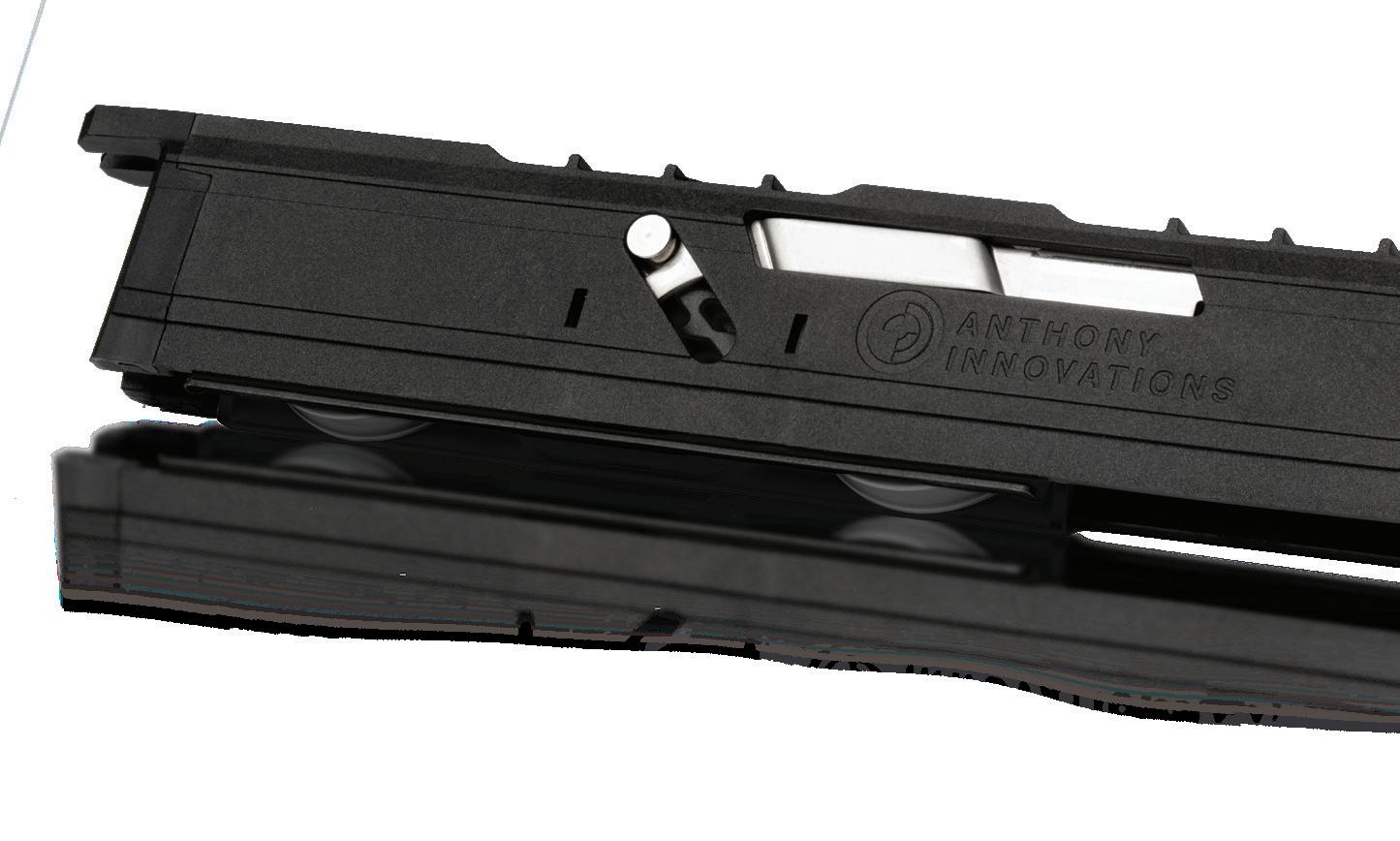

WE’RE MORE THAN UNIQUE, WE’RE AUSTRALIA’S LARGEST MANUFACTURER AND SUPPLIER OF WINDOW & DOOR HARDWARE




WE’RE MORE THAN UNIQUE, WE’RE AUSTRALIA’S LARGEST MANUFACTURER AND SUPPLIER OF WINDOW & DOOR HARDWARE

MAJOR EXHIBITION SPONSOR





CASUAL DINNER SPONSOR
WELCOME PARTY SPONSOR
GOLD SPONSOR
SILVER + LANYARD SPONSOR
























MAJOR EXHIBITION SPONSOR
DAY 1: Exhibition Open 8.00 AM to 5.00 PM Norfolk Hall, Prince and Monarch Rooms
DAY 2: Exhibition Open 8.00 AM to 3.00 PM Norfolk Hall, Prince and Monarch Rooms
Find out more about the Genuine Hush™ range
Genuine Hush™ is Australia’s noise-reducing glass choice for homes, offices, and public buildings. Products include ComfortHush™ and QLam Hush™. Look for the label to identify your glass is Genuine Hush™ made by Oceania Glass.

oceaniaglass.com.au
Kommerling
Kommerling Cyncly
Cyncly
Overseas Glass Agencies
Overseas Glass Agencies
Overseas Glass Agencies
A+W Software
Fenestration Solutions Australia
Fenestration Solutions Australia
Elegant IG
Elegant IG
Glaston Finland OY
Klaes
Siegware
EnduroShield
Viridian
Quattrolifts
Quattrolifts
Aluflam Australia
Aluflam Australia
Proctor Group Australia
GRC Tooling
Aluplast Aluplast
Breezway Australia Deceuninck
Orgadata Biesse Group
Glassworks
Antas Sealants & Adhesives
Elite Security Screens & Doors
Capral
Interform Supplies
Techni Waterjet
Doric
Doric
Doric
Admil Sealants & Adhesives
Admil Sealants & Adhesives
Azuma Design
NFK Glazing & Industrial Supplies
LandGlass Technologies
Guru Corporation
CR Laurence
EBSA
EBSA
Oceania Glass
Lincoln Sentry Bostik
Oceania Glass EBSA EBSA
Modern Frameless Glass Systems
G.James
Parkwood Doors Doric - Coffee Cart Deco - Coffee Cart National Glass - Coffee Cart

North, South or somewhere in between... Viridian has a solution to meet 7 Star compliance for every region in Australia.
Double glazing will improve the comfort and liveability of your home, it is a simple and e ective way to reduce energy bills and cut carbon emissions. We have provided our key double glazing solutions that work towards better insulation and 7 Star compliance.
ThermoTech™
SUITABLE FOR WARMER CLIMATES
ClimaTech™

SUITABLE FOR MIXED CLIMATES
LightBridge™
SUITABLE FOR COOLER AND MIXED CLIMATES
Products in the ThermoTech™ range are ideal for keeping your space comfortable and naturally lit with energy e cient benefits.
ClimaTech™ is a great option for those wanting double glazing on a budget.
LightBridge™ o ers exceptional insulation, using a high performance Low E glass with a thermal spacer.
For more information visit viridianglass.com or call 1800 847 434
Laureate Professor Veena Sahajwalla (UNSW) | Sponsored by AWS

Enjoy a 2-course lunch while listening to an inspirational speaker and networking with your peers.
Where: RACV Royal Pines Resort - Videre Restaurant
Time: Wednesday 12:30 PM
Sponsored by Doric
Enjoy a delicious buffet dinner on on the Podium Lawns with entertainment and take the chance to catch up with colleagues and friends.
Where: RACV Royal Pines Resort - Podium Lawns
Time: Wednesday 6.30 PM to 9.30 PM

MC: Andrew Daddo | Band: The Filthy Animals
For our final night, join us in the Royal Benowa Ballroom for the 2023 AGWA National Design & Industry Awards Gala Dinner as we celebrate our amazing achievements in the industry. Includes a 3-course dinner, drinks (beer, wine and soft drinks) and entertainment.

Where: RACV Royal Pines Resort - Prince and Monarch Rooms
Time: Thursday 6.30 PM to 11 PM | Dress Code: Formal
PROGRAM: TUESDAY 29
Sponsored by Viridian and Tomma
Sponsored by Southern Star Group of Companies
Royal Benowa FoyerMarquis Room
Welcome
Housekeeping and Opening Rob Carlton | Conference MC
Welcome Address
and Monarch Rooms Prince and Monarch Rooms
Keynote 1
Keynote 2
A Clear Future - Adapting to Change
Jason Clarke | Minds At Work | Sponsored by Capral
Change in the Regulation Space (2025 and beyond)
Russell Harris (AGWA) and Michael Reid (ABCB)
Morning Tea | Sponsored by GRC Tooling
The Changing Economic Outlook
Keynote 3
Keynote 4
Tom Devitt | HIA
Change or Be Changed - NZ Perspective
Brett Francis and Rob Campion | NZGGWA
12:30 | Ticketed Event - Women In Windows Lunch
12:35 PM | Lunch
Innovation in Construction
Prince and Monarch Rooms
Prince and Monarch Rooms
Prince and Monarch Rooms
Prince and Monarch Rooms
1.50 PM
Keynote 5
Keynote 6 Keynote 7
Professor Chris Knapp | Building 4.0 CRC
Energy and the Future of Buildings
Rob Murray-Leach | Energy Efficiency Council
Energy Sustainability Discussion Panel
Clinton Skeoch | AGWA CEO/Excecutive Director 9.15 AM 2.35 PM 3.20 PM
Clinton Skeoch, Russell Harris, Rob Murray-Leach, Professor Veena Sahajwalla and Professor Chris Knapp
Afternoon Tea
Exhibition Open 8.00 AM to 5.00 PM Royal Benowa Foyer and Marquis Room
Prince and Monarch Rooms
Prince and Monarch Rooms
Prince and Monarch Rooms
Breakout Session 1
Breakout Session 2
Breakout Session 3
Breakout Session 4
Smart Vision for a Sustainable Future
Laureate Professor Veena Sahajwalla | UNSW
Durability is the Key to Net Zero
Professor Michael Stacey | Bartlett School of Architecture London Sponsored by DECO
Managing Hazardous Manual Handling with an Ageing Workforce
Rick Carlei | Quattrolifts
Glass Innovations, Electrochromic Tinting Glass and Solar Facades
Anthony Breach | George Fethers
Energy Ratings in Australia
Prince Room
Monarch Room
Norfolk Hall
Prince Room
Breakout Session 5 Monarch Room
Andrew Wright | CSIRO
All Things IGU
Breakout Session 6
Adam Davies | AGWA
Morning Tea | Sponsored by AGC
Disputes and Non Compliance Investigations
Breakout Session 7
Breakout Session 8
Breakout Session 9
Breakout Session 10
Breakout Session 11
Breakout Session 12
Russell Harris , James Whitehouse and Adam Davies | AGWA
Tangible Benefits of Silicone Sealants vs Organic Solutions in the Facade Sealant Market
John Cook | Shin-Etsu | Sponsored by Admil Adhesives
Lessons Learnt in the Safety Space
Kate Wendt | Dragon Glass
WERSlink and Supporting Efficient Window Selection
Russell Harris | AGWA
Industry Training, Recruitment and Skill Development, Licensing
Melissa Baker and Clinton Skeoch | AGWA | Sponsored by Thermeco
Standards and Consumer Law
Atul Singh and Cameron Spanner | Adams and Partners Law Firm
Transforming Mindsets for Business Growth
Breakout Session 13
Breakout Session 14
PM
Final Keynote
*Please note, Program subject to change.
Leanne Luhrs | DLG | Sponsored by AWS
Laminated Glass – The Fit for Purpose Product for Today’s NCC Requirements
Geoff Rankin & Julia Schimmelpenningh | Eastman Chemical Company
Coming Together to Thrive Through Change
Rob Carlton | Conference MC | Sponsored by Viridian
Norfolk Hall Prince Room
Monarch Room
Norfolk Hall
Prince Room
Monarch Room
Norfolk Hall
Prince and Monarch Rooms
Norfolk Hall
Prince and Monarch Rooms
Rob Carlton is an Australian actor, best known for his Logie winning performance as Kerry Packer in ABC’s Paper Giants.

Rob is also a writer, winning an Australian Writers Guild Award (an AWGIE), for best narrative comedy, for the show he created; Chandon Pictures (STAN). Rob won Tropfest with Carmichael and shane, a short film about a father of twins who chooses a favourite. 2023 sees Rob appearing in Black Snow for Stan, Boy Swallows Universe for Netflix and North Shore for Paramount Plus.
A popular entertainer and true professional, Andrew Daddo is a regular face on Australian television, stage and film.

Andrew’s also carved out a niche as one of Australia’s favourite corporate MC’s and Conference Hosts. He has hosted high profile television events including the Logies, People’s Choice Awards, and the Australian Music Awards. Working across all industries, his clients have included Subway, Mc Donald’s, CBA, Westpac, BT, National Insurance Brokers, AusRail, Baker’s Delight, Engineering group SMEC, Holden, Travellers Choice and Arbonne. Having enjoyed a successful media career that began with Network Ten while an undergraduate at Monash University, then completed his studies majoring in politics/ history, it’s fair to say, there’s not much Andrew has not done or is unable to accomplish. With extensive experience, he believes the secret to a good event is communication with the people as much as the industry.

A Smart Vision for a Sustainable Future: SMaRT Technologies and MICROfactories™ Creating Sustainable Materials and Products from Waste | Women in Windows Lunch Speaker | Sustainability Panel
Professor Veena Sahajwalla is an internationally recognised materials scientist, engineer, and inventor revolutionising recycling science. She is renowned for pioneering the high temperature transformation of waste in the production of a new generation of ‘green materials’ at the UNSW Sustainable Materials Research and Technology (SMaRT) Centre, where she is Founding Director. Professor Veena is the inventor of polymer injection technology, known as green steel, an eco-friendly process for using recycled tyres in steel production.
Professor Veena is the director of the ARC Industrial Transformation Research Hub for ‘microrecycling’, a leading national research centre, where she launched the ARC Research Hub for Microrecycling of Battery and Consumer Wastes this year.
Tom joined HIA as an Economist in 2018. As Senior Economist, he assists in the research and analysis of housing market trends and manages the assumptions and statistical modelling behind HIA’s residential building forecasts. He has also authored many of HIA’s wide range of economics publications.

Before joining HIA, Tom worked as an Economist for private sector consultancies. During this time, he worked on projects engaging with and providing advice to all levels of government, as well as private sector clients and the community sector.
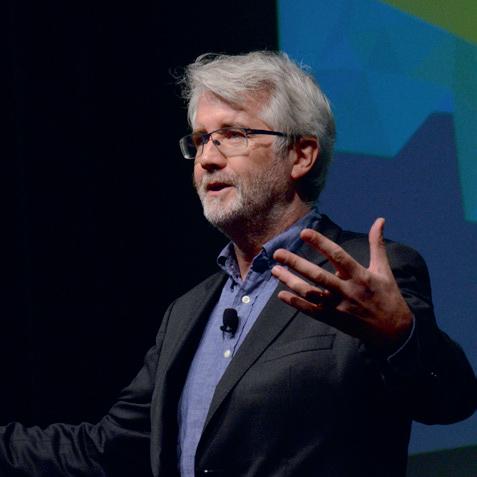
Jason is a Director of Minds at Work, a commercial collective of autonomous thinkers and problem solvers dedicated to supporting anyone interested in Making Things Better. He has worked across most industries and government sectors in Australia.
While establishing Minds at Work, Jason also worked as a lecturer teaching Innovation, Logic and Problem Solving at Melbourne Business School and as a Guest lecturer in Innovation at the Australian Graduate School of Entrepreneurship and for the Stern Business School of New York.

Brett is the CEO of the Window & Glass Association NZ. Five years ago, he helped combine the Window Association and Glass Association together with a common goal and agreed strategies. The Association is the recognised voice of the industry, supporting and education its membership community.

Rob has had a life-long involvement in the window and door industry and brings his experience to the table, working closely with MBIE, BRANZ and other industry bodies on window-related projects, aiding in the fulfilment of the Associations mantra ‘helping to create a better built environment for all New Zealanders’.
Professor Chris Knapp is an experienced leader, educator, design practitioner, researcher and maker and Research Director at Building 4.0 CRC. He previously served as Head of School at Bond University, where he helped establish the Abedian School of Architecture from 2011.
Dr Knapp’s research expertise is in the application of digital fabrication and digital design tools toward transforming the relationship between design and construction. Since 2015, Chris has co-directed Studio Workshop, a practice in Southeast Queensland creating innovative spatial and technical approaches to building-making through digitally-assisted means. His research, teaching, and practice work have been published widely and received national and international recognition.
Rob Murray-Leach, has a background in environmental policy, biology and behavioural sciences and has worked in climate and energy policy for 20 years. Rob founded the Energy Efficiency Council in 2009 as it’s CEO and is now the Council’s Head of Market Transformation.

Prior to the Energy Efficiency Council, Rob worked for industry, government and non-profits, including the Garnaut Climate Change Review, the South Australian Government and the Conservation Council of South Australia. He has contributed to award-winning books on sustainable transport and urban ecology.


Atul is a Director at Adams & Partners in charge of the Litigation Department, covering both Civil and Criminal Litigations.

He has over 17 years of experience in the legal industry in the public and the private sectors, successfully achieving great and practical results for businesses and individuals in New South Wales. His experience expands from extensive court work in litigation & appeals in criminal and civil matters, including contracts, building & construction, contracts, defects, property & development, extraditions and defence proceedings. Atul was also a recipient of the Minister’s Award during his time with the public sector.
Professor Michael Stacey is an award-winning architect, author and professor of architecture, and is a leading international expert in the field of aluminium sustainability. For the past 30 years, Prof Stacey has undertaken a wide range of research, which has focused on the benefits of aluminium in architecture and the built environment.
Stacey’s building designs have been recognised by national and international awards. Stacey’s passion and commitment to design excellence has also seen him develop prefabricated cladding and façade systems, which includes the system used by architect Philip Cox on the Melbourne Tennis Centre. Stacey’s new publication ‘Aluminium: A Studio Design Guide’ will be published in 2023.
Anthony Breach connects Australia’s glass fabricators, façade engineers, architects and building owners with world-leading, sustainable glass and solar solutions.
As National Sales Manager at George Fethers & Co, Anthony brings the latest glass technology to the Australian market, enabling projects that are both beautiful and sustainable.
With over 20 years’ industry experience Russell has a thorough understanding of fenestration, including compliance, product design, development, and testing. Russell’s background in R&D means he is familiar with many of the emerging technologies, innovations and market influences that are likely to impact the industry in the future.

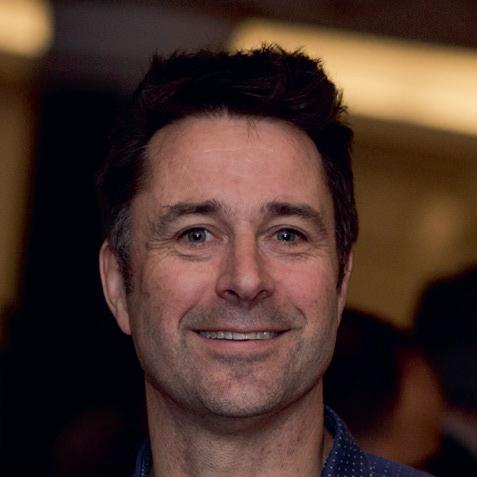
Since joining the Association in 2016, Russell has been a noteworthy leader in the technical space, and an active contributor to the ongoing development of the Regulatory framework affecting the window industry.
John Cook has spent decades in the functional sealant market and is an expert in all aspects of high performance sealants within the Australian market including Structural Glazing, Insulating Glass, Cladding, etc.

John has had extensive involvement with new build and refurbishment projects, including glazing, curtain wall, stone and glass facades as well as knowledge and understanding of both structural and insulated glazing systems.
Julia Schimmelpenningh is the architectural technical engagement manager at Eastman Chemical Company, in Springfield, Massachusetts USA, a global specialty material and chemical company. Her work includes new product development, qualification and commercialisation of laminated glazing solutions, regulatory development and industry education and association support for Architectural Saflex and Vanceva interlayers.
Julia has been a very active and solid contributor in the glazing industry for 30+ years and served as president of the Glass Association of North America and as chair of several committees on ASTM International. She is currently on the ASTM Board of Directors and has been published in trade magazines and peer reviewed journals.

Kate Wendt is a highly skilled professional with expertise in the fields of glazing, joinery, construction, and project management. As a trade qualified glazier and joiner, licensed builder, and qualified project manager, Kate possesses a diverse set of skills that she has honed through her remarkable journey.

During her time in Europe, Kate dedicated three years to mastering the art of glass lamination, immersing herself in the intricacies of the craft. In her pursuit of excellence, Kate established her own lamination line. Despite her growing success, Kate remains committed to being hands-on and personally oversees every job within her businesses, Dragon Glass Lamination and Black Widow Australia.
Anthony leads the Building Energy Efficiency Team at CSIRO. In the last 5 years he has overseen the development of the Australian Housing Database, the redevelopment of AccuRate as a cloud tool, the implementation of new whole-of-house regulations under the NCC 2022, the development of the NatHERS benchmark tool for disclosure, development of the RapidRate artificial intelligence, and many other residential energy efficiency projects.

Prior to his current role, Anthony worked in State Government and in architecture practises as a building designer and project manager, always with a focus on energy efficient residential design.
Cameron was admitted to practice Law in New South Wales in early 2017. Cameron began at Adams & Partners Lawyers as a paralegal, then transitioned into the role of a junior lawyer. In late 2019, at the age of 25, Cameron became the youngest ever Director at the firm.
Cameron has a vast wealth of knowledge in multiple areas of practice including commercial and contractual law, building law, wills and estates and personal injury and workers compensation litigation. Cameron is a people person and enjoys problem solving, which is why he enjoys what he does.

Adam holds a degree in Materials Engineering from the University of NSW and started his glass career as a part-time employee at the Viridian Ingleburn float line in his final year of study. After graduation, he moved into a full-time role as a Process Engineer and later to Technical Manager at Viridian. Adam has seen most aspects of the industry.
Adam has brought a new structure and process development skills to the AGWA Accreditation Programs to support members, drawing on his experience in glass processing, warranty investigation and reporting, and product testing.

Rick graduated as a chiropractor 1987 and operated chiropractic clinics from 1987-2004. He is an OHS consultant specialising in hazardous manual handling for various companies including Pilkington Glass/ Viridian, A&L Windows, Amcor, Visy, Olex Cables and various councils around Victoria.
In 2006, Rick started Quattrolifts Glass Handling equipment, which manufactures and exports glass handling equipment to North America, Europe and Asia.
Melissa has worked in the training industry for more than 20 years, most recently in the VET sector at TAFE NSW. She has a wide range of training and management experience across a variety of sectors, including in a head teacher capacity.


At AGWA Melissa works with our industry subject matter experts to develop new and improve resources for our members. This has included training courses, both on demand and instructor led, safety resources, the new AGWA website, Events and AusFenEx23. Melissa is also the co-editor of BuiltView Magazine.
Leanne is a seasoned business owner with over 27 years of experience in the glazing industry and has honed her skills in decision-making and adapting to an ever-changing market. Leanne knows the importance of adapting to change and taking calculated risks to grow a business. Her hard work and dedication have not gone unnoticed, as she was the inaugural winner of the Women in Windows Award.
Despite her busy schedule, Leanne never loses her passion for work and always looks for new opportunities to grow and improve her business.
Michael Reid’s role involves oversight of technical projects which lead the development of changes to the National Construction Code. He also sits on various technical and standards committees and has a particular interest in structural performance, climate change resilience and adaptation of buildings, and external envelopes.
Prior to joining the ABCB, Michael was a building façade engineer working on national projects in Australia, the United Kingdom and the Middle East. He is a Chartered structural engineer and with his industry nous and a solid technical background, Michael is passionate about driving positive change in the built environment.


While there are increased minimum performances within the two key glazing factors (U-Value and SHGC), don’t ignore other key performance factors that impact aesthetic and comfort of homes:
U-VALUE:
Think of this as a measure of Insulation – how much internal heat escapes through the glazing, per m², when it is colder outside than inside, as heat wants to move from where it is hot to where it is not. The lower the U-Value, the better the Insulation.

SHGC:
Solar Heat Gain Coefficient. This is a measure of Solar Control –how much heat from the sun enters inside the building through the glazing. The higher the SHGC, the more passive heat from the sun enters inside while the lower the SHGC, the less sun heat enters in.

VLT:
Visible Light Transmittance is how much % of sunlight enters inside through the glass. The lower the VLT, the less light enters, and also affects the look and clarity of the glass. For Residential homes we generally want higher VLT to allow high levels of natural light inside.

SELECTIVITY:
This is a ratio that looks at the relationship of VLT and SHGC as we must be mindful of what impact lower SHGC has on the amount of natural light ingress. A ratio of 1.25 is considered great while a ratio over 2.0 is extremely high performing and even more beneficial. Also known as Light to Solar Gain ratio (LSG).
QUALITY:
The processing of glass opens up the potential for quality issues. The Heat Treating of glass for example (Toughening and Heat Strengthening) can see distortion affect the reflection on the glass. Reflections should be as close to a mirror-like reflection as possible.
COMPLIANCE:
Compliance to not only the NCC 2022 demand of Total System U-Value and SHGC, but also processing standards such as AS 2208 for safety glass and AS 4666 for Insulated Glass Units (IGU). All Australian Glass Group plants are certified to these standards.
Australian Glass Group also understands the vital importance of certification and compliance of glass products. Our products are manufactured and certified to Australian Standards by an international certification body and compliance is certified and available on request in key areas including;
See our Insulglass® Projects at www.agg.com.au/about/projects
Insulglass ® Double Glazed Units - available in a full range of options to suit your needs;



A full range of non-coated DGU options, surpassing any single glazed option in terms of insulation.
An ideal LowE for Warmer climates to minimise Glare and a balance of Solar Control and great Insulation.
An ideal LowE for Colder climates with maximum Visible Light, Passive Heat Gain and excellent Insulation.


Excellent performance to advance both Solar Control and Insulation without compromising Visible Light.
Superior performance to maximise both Solar Control and Insulation without compromising Visible Light.

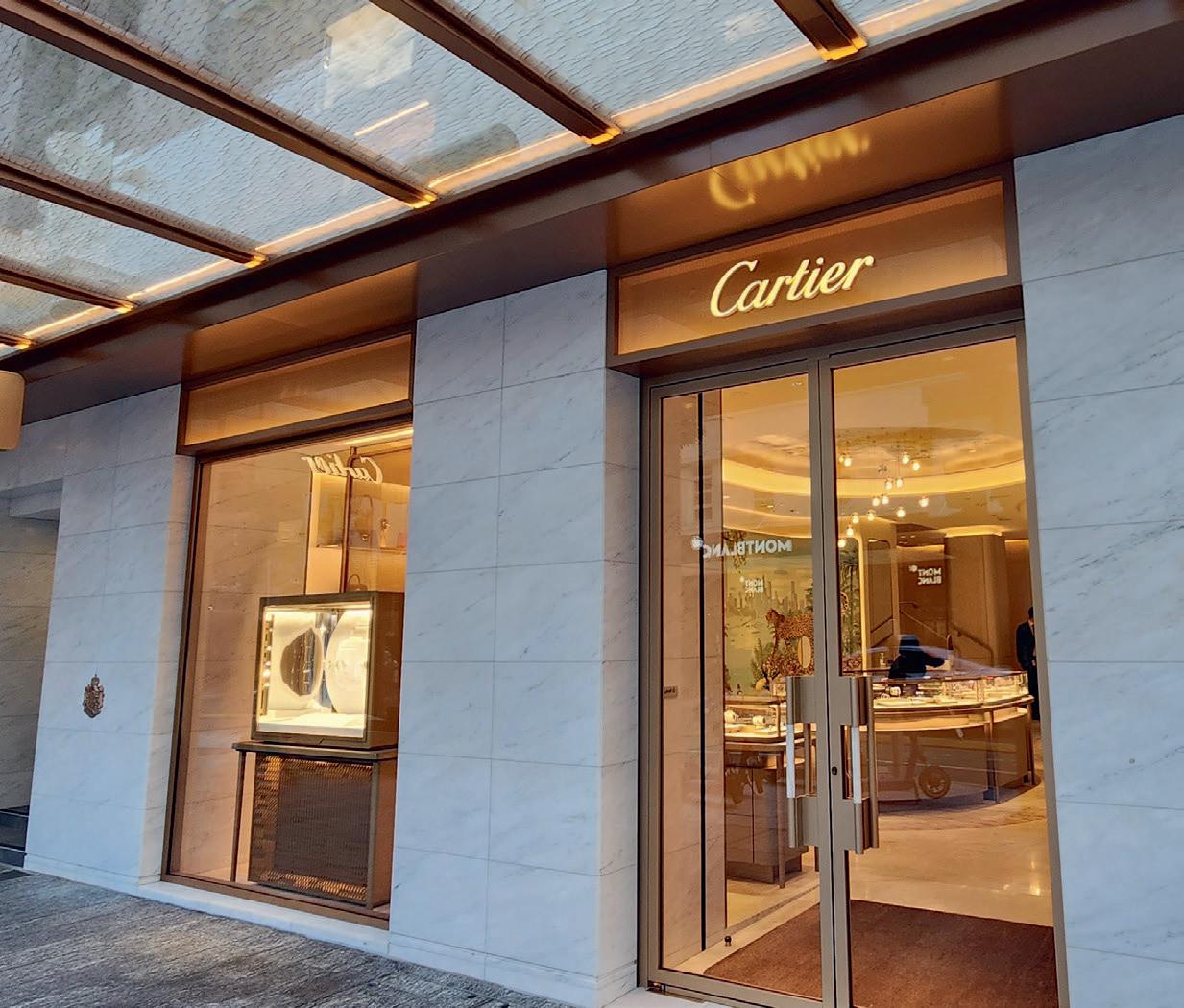






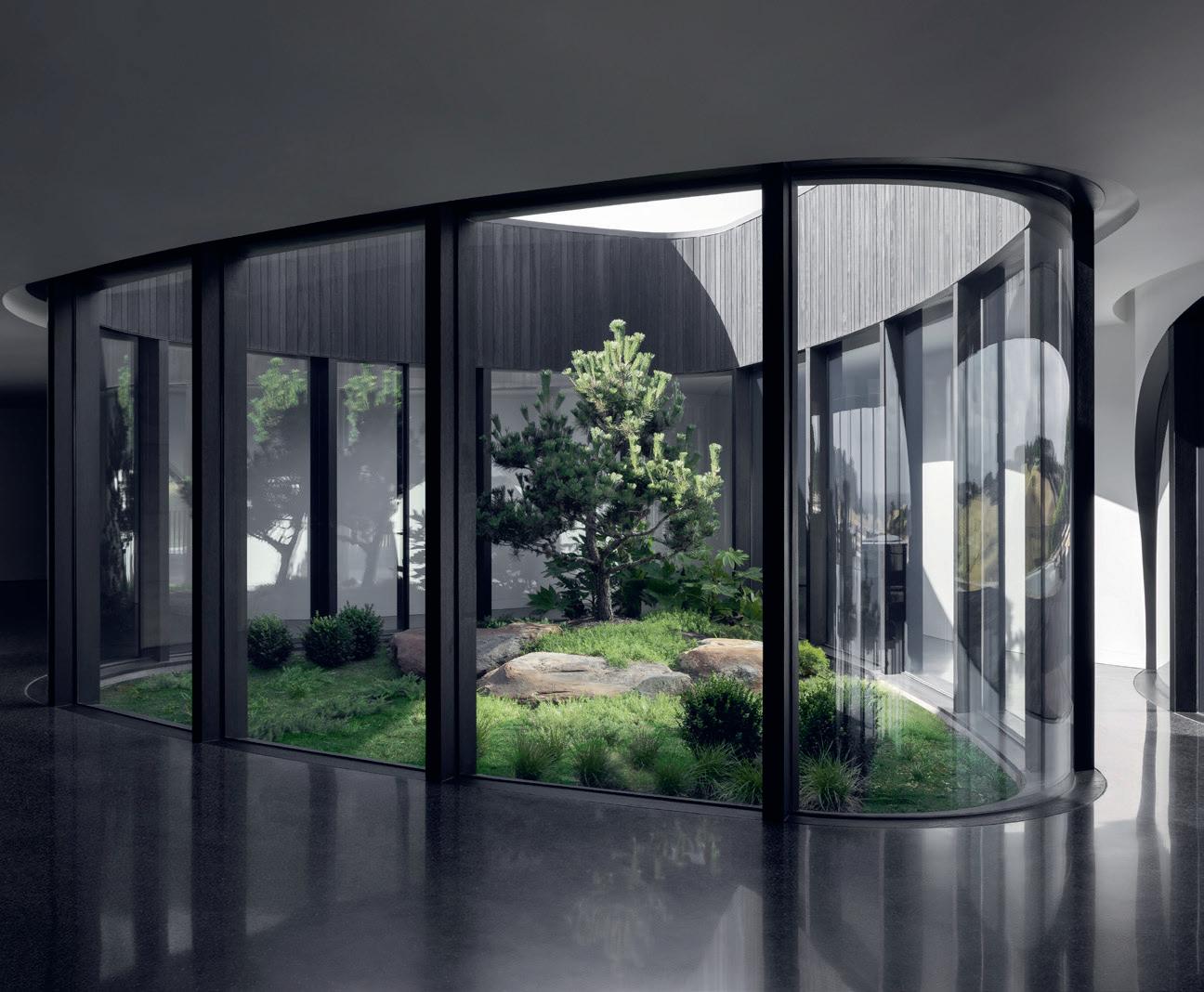

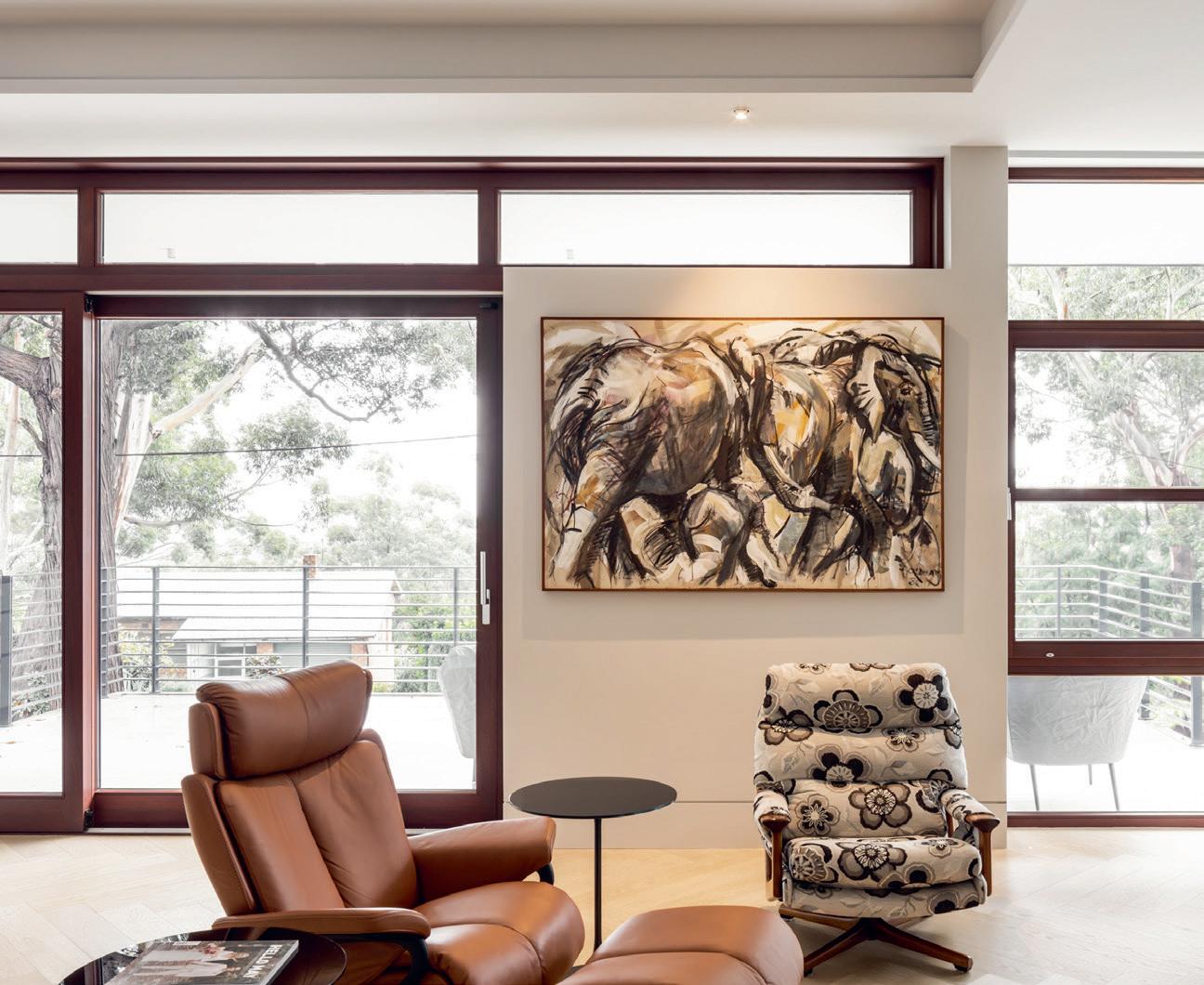
 Spadaccini Homes Cooling Brothers Glass Company
Birchgrove Residence Bent and Curved Glass
Cedarhill Tweed Coast Glass
Peninsula House Creative Windows
Alvie House European Window Co
Mangerton Residential Australian Glass Group
Spadaccini Homes Cooling Brothers Glass Company
Birchgrove Residence Bent and Curved Glass
Cedarhill Tweed Coast Glass
Peninsula House Creative Windows
Alvie House European Window Co
Mangerton Residential Australian Glass Group




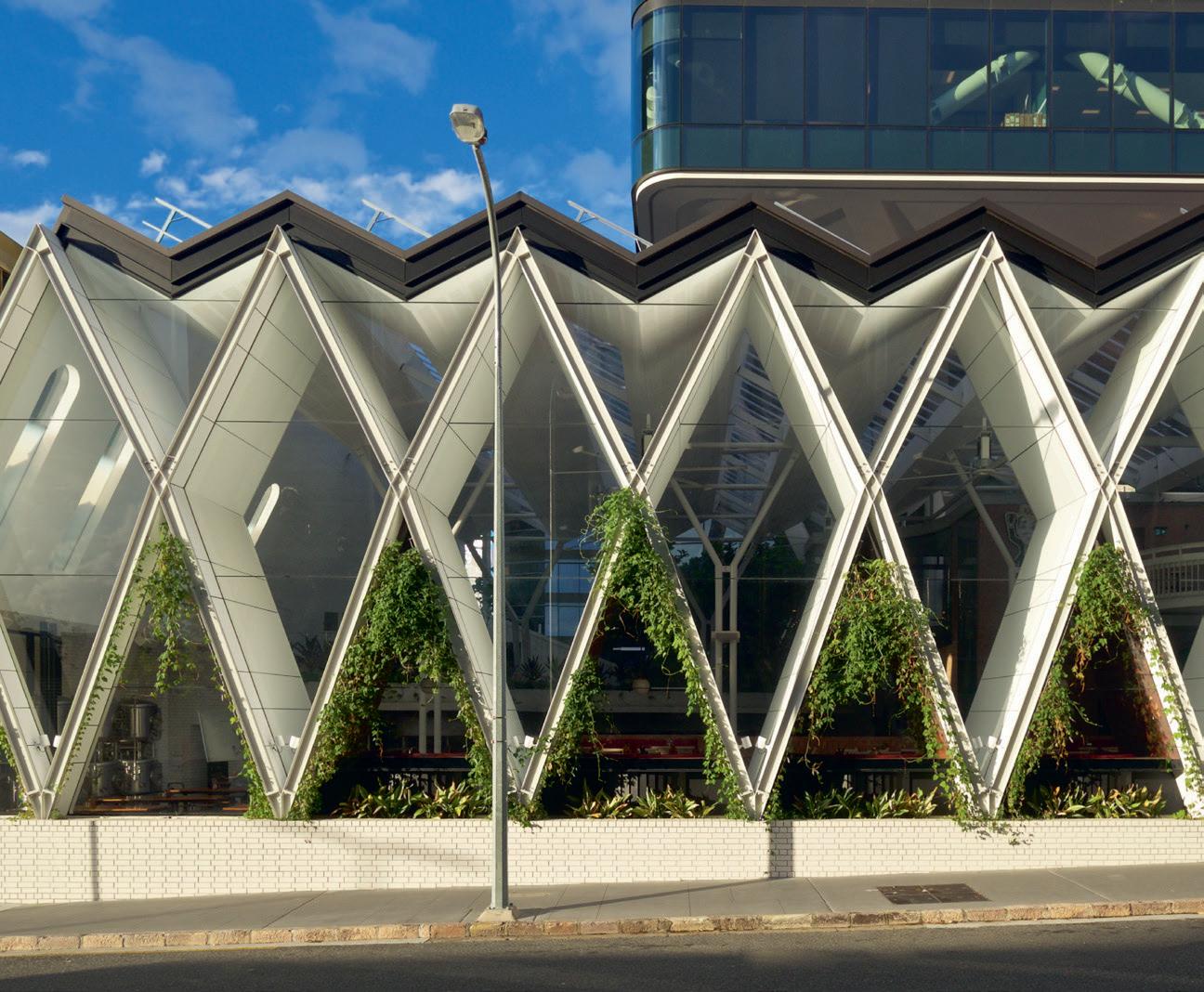



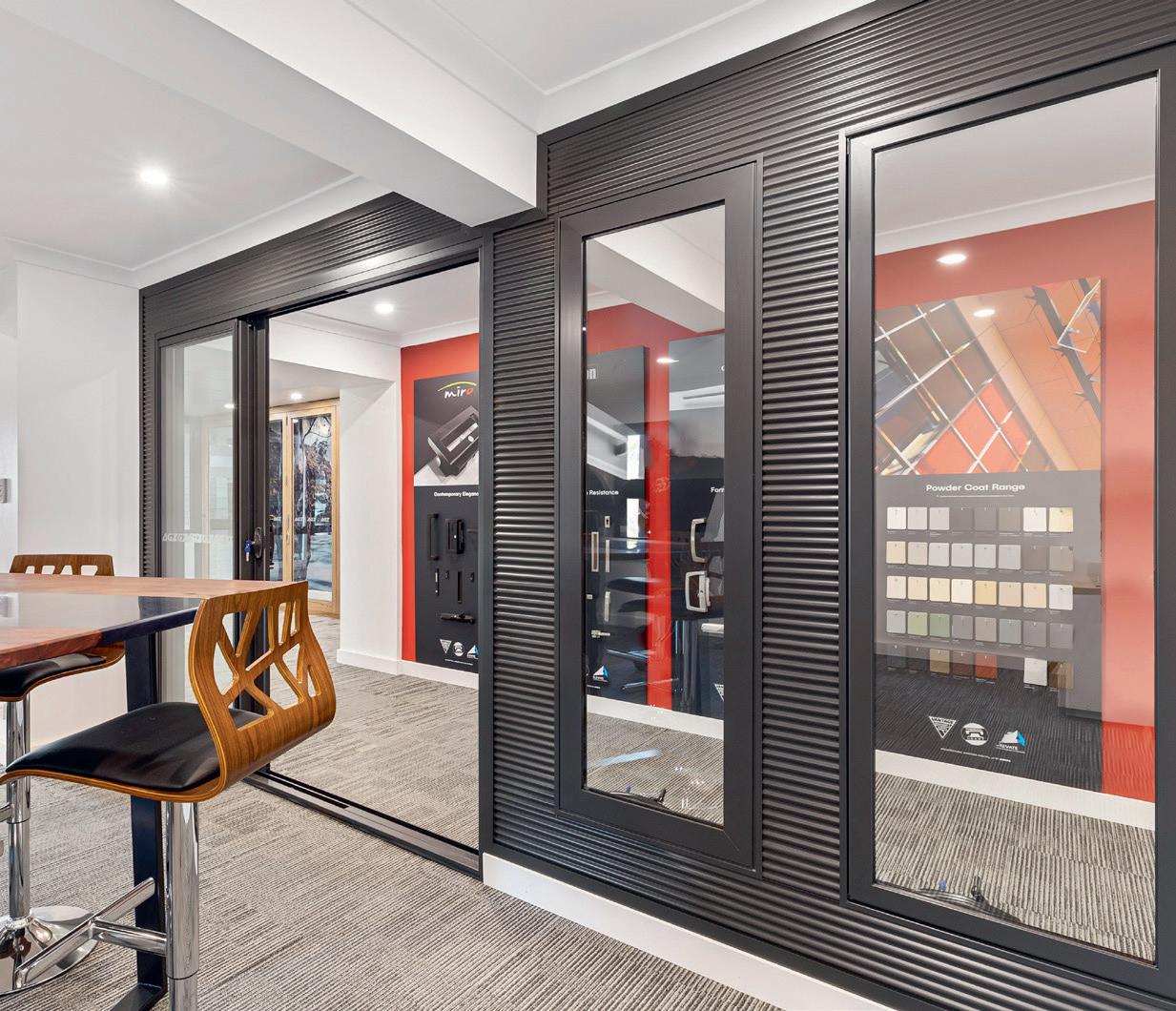
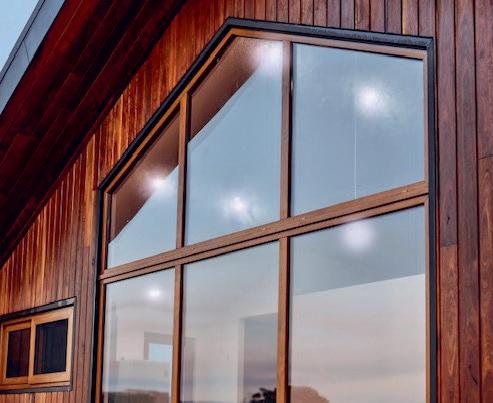

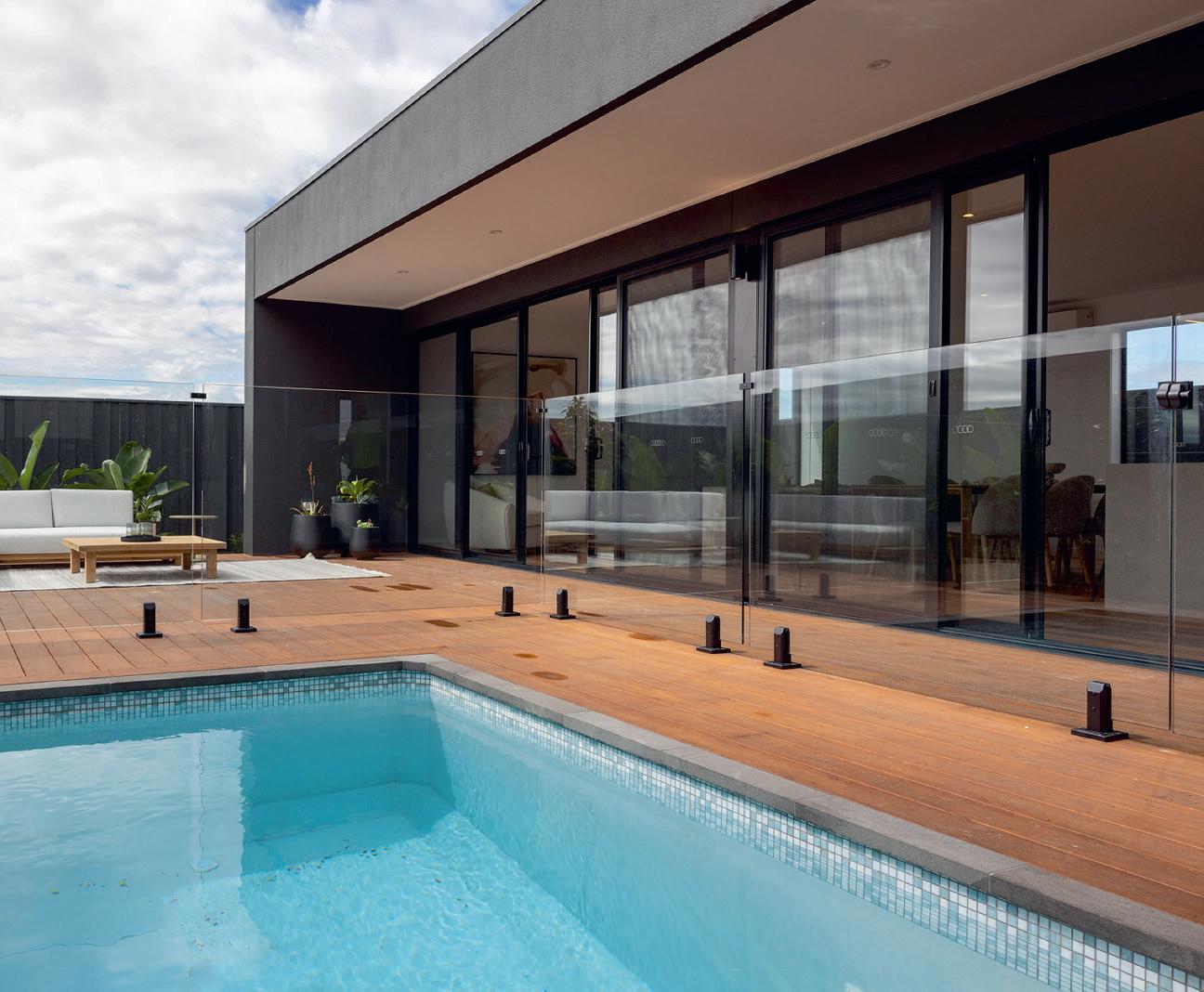
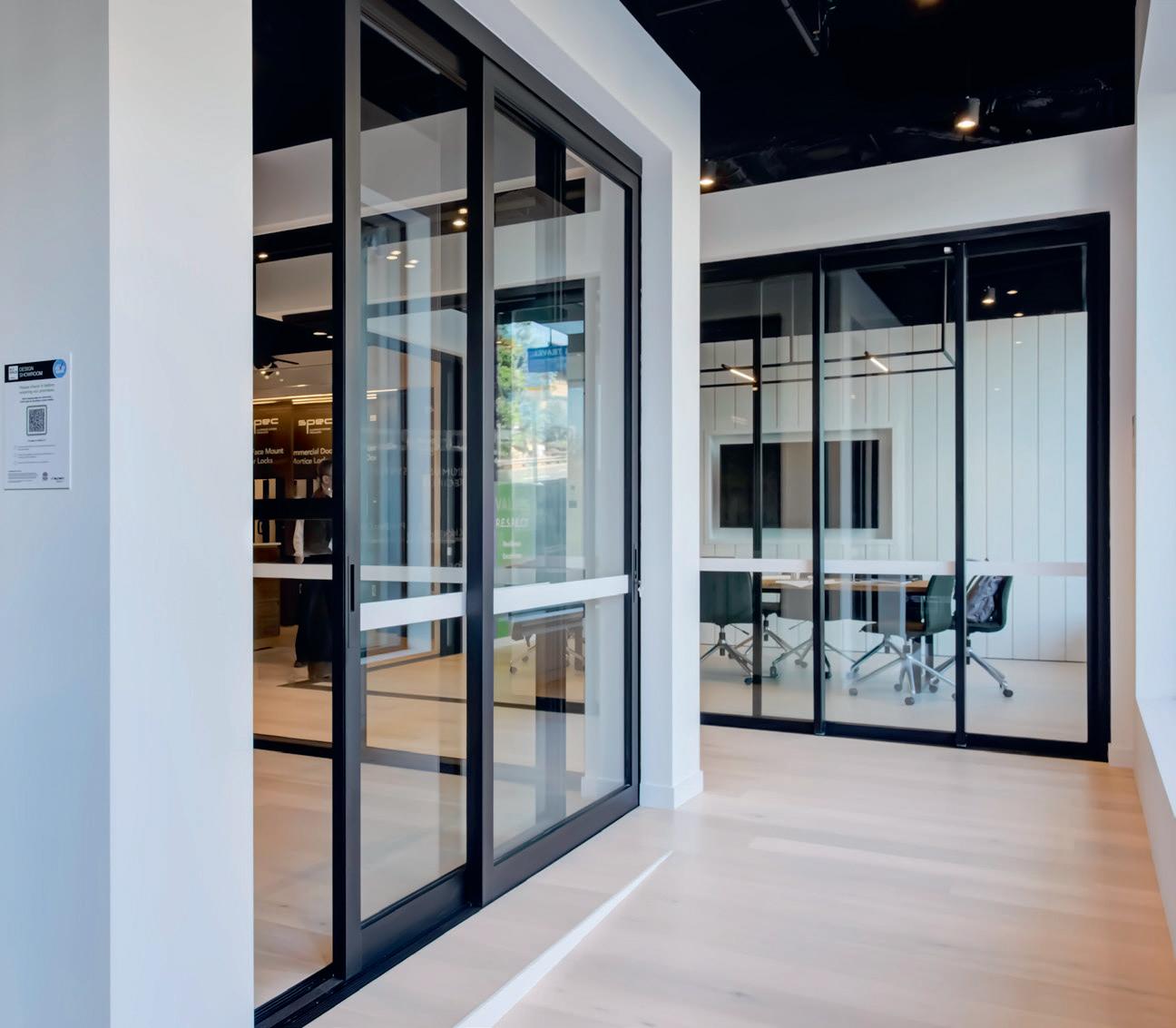
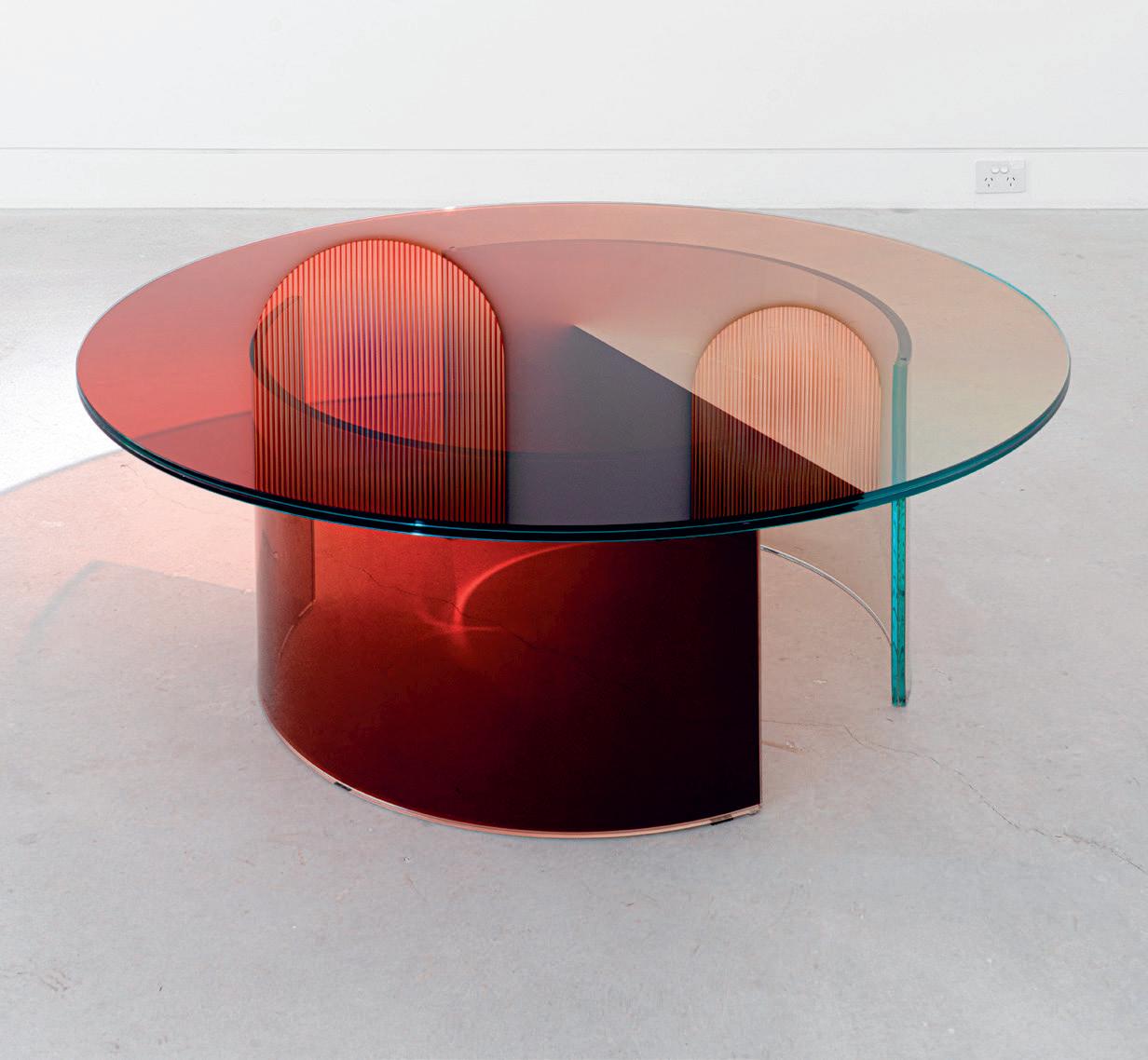


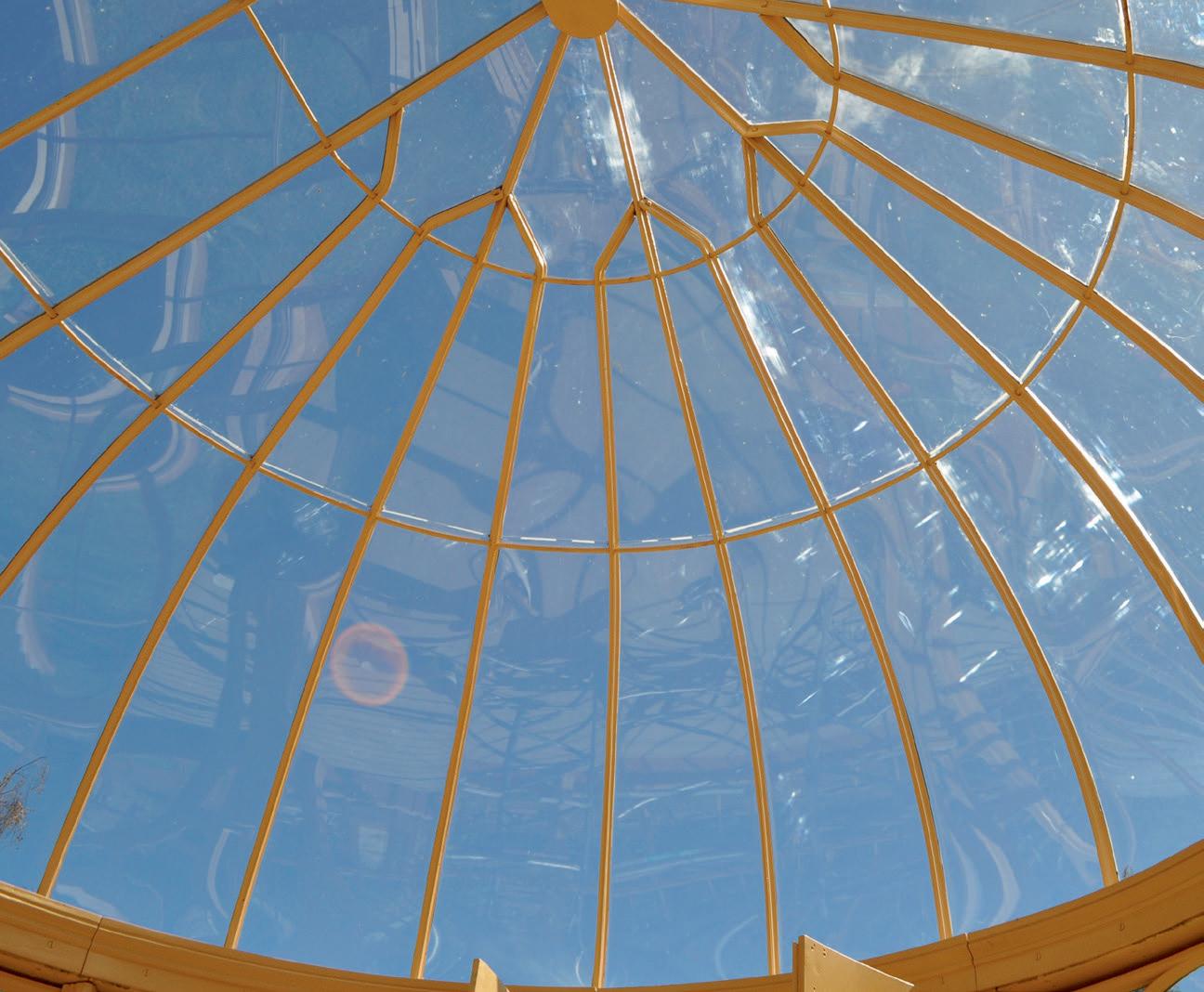
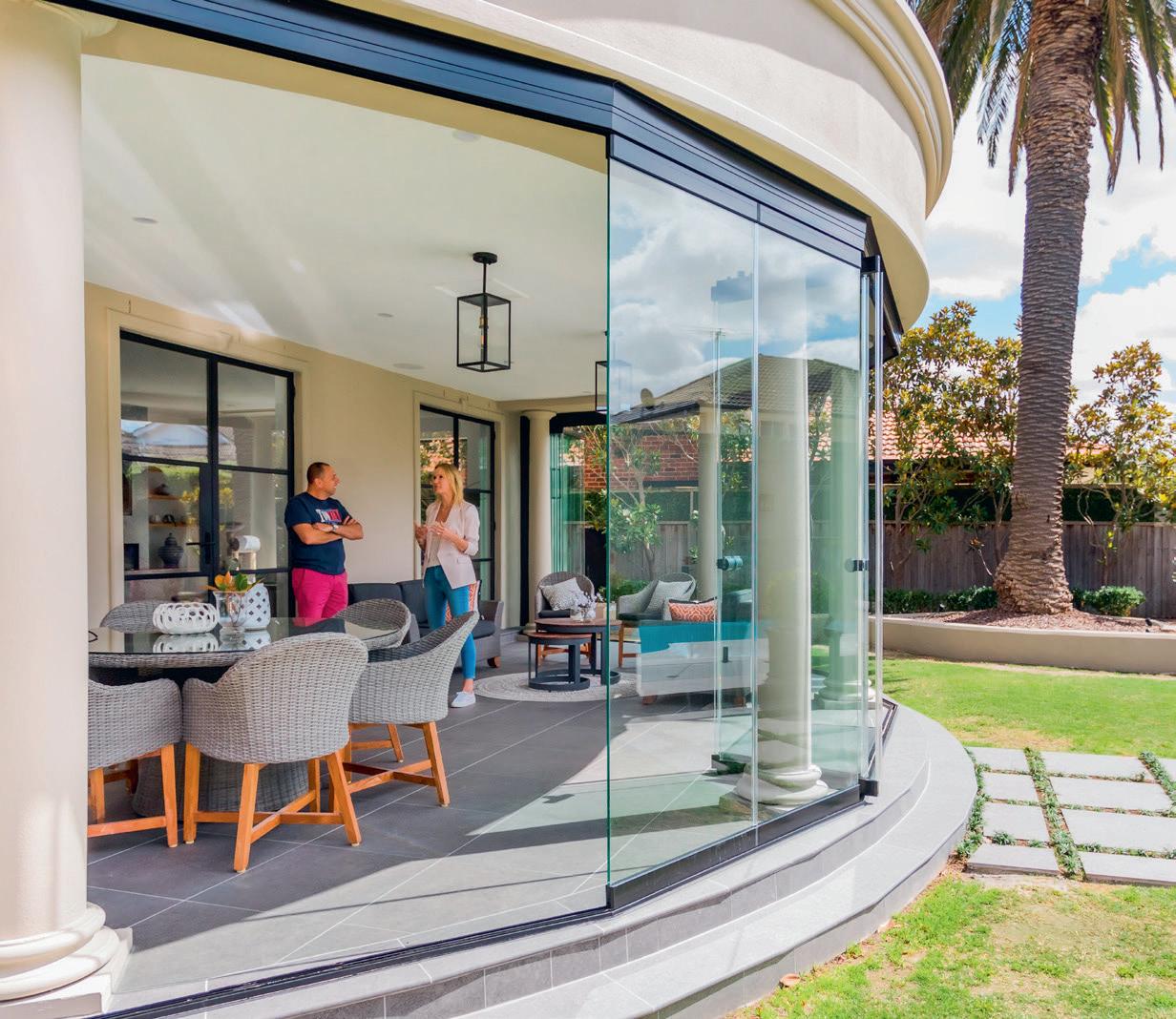
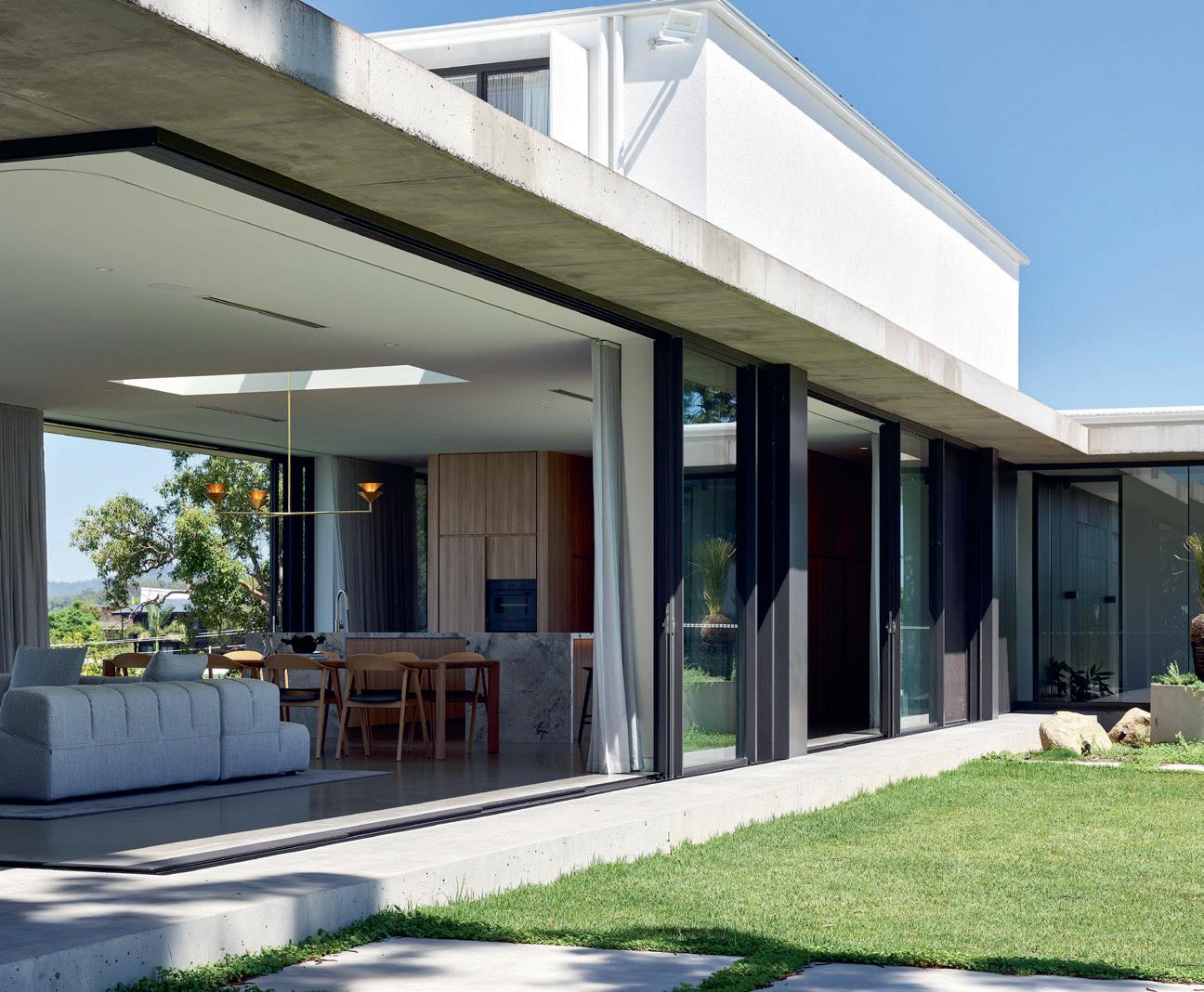


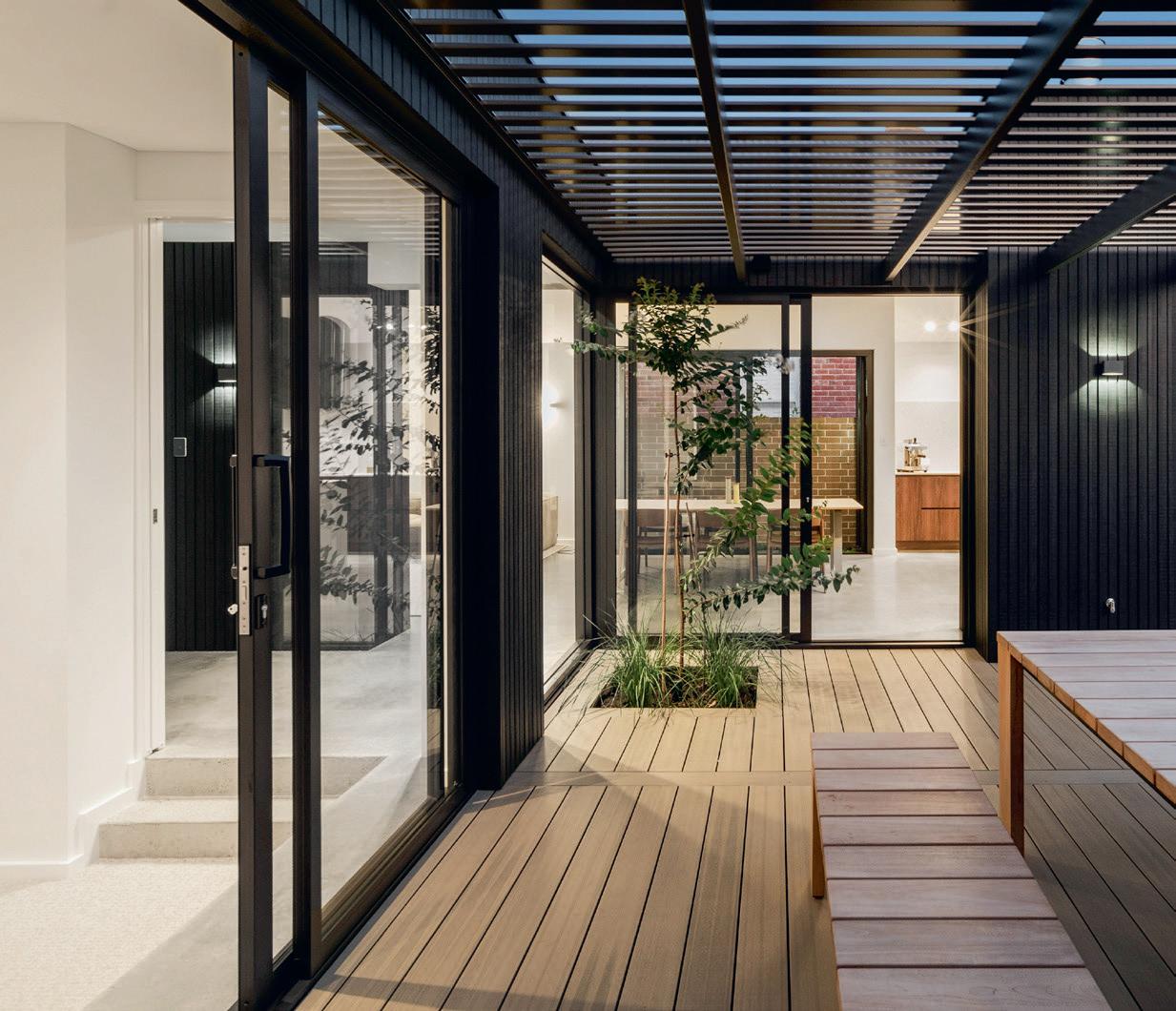
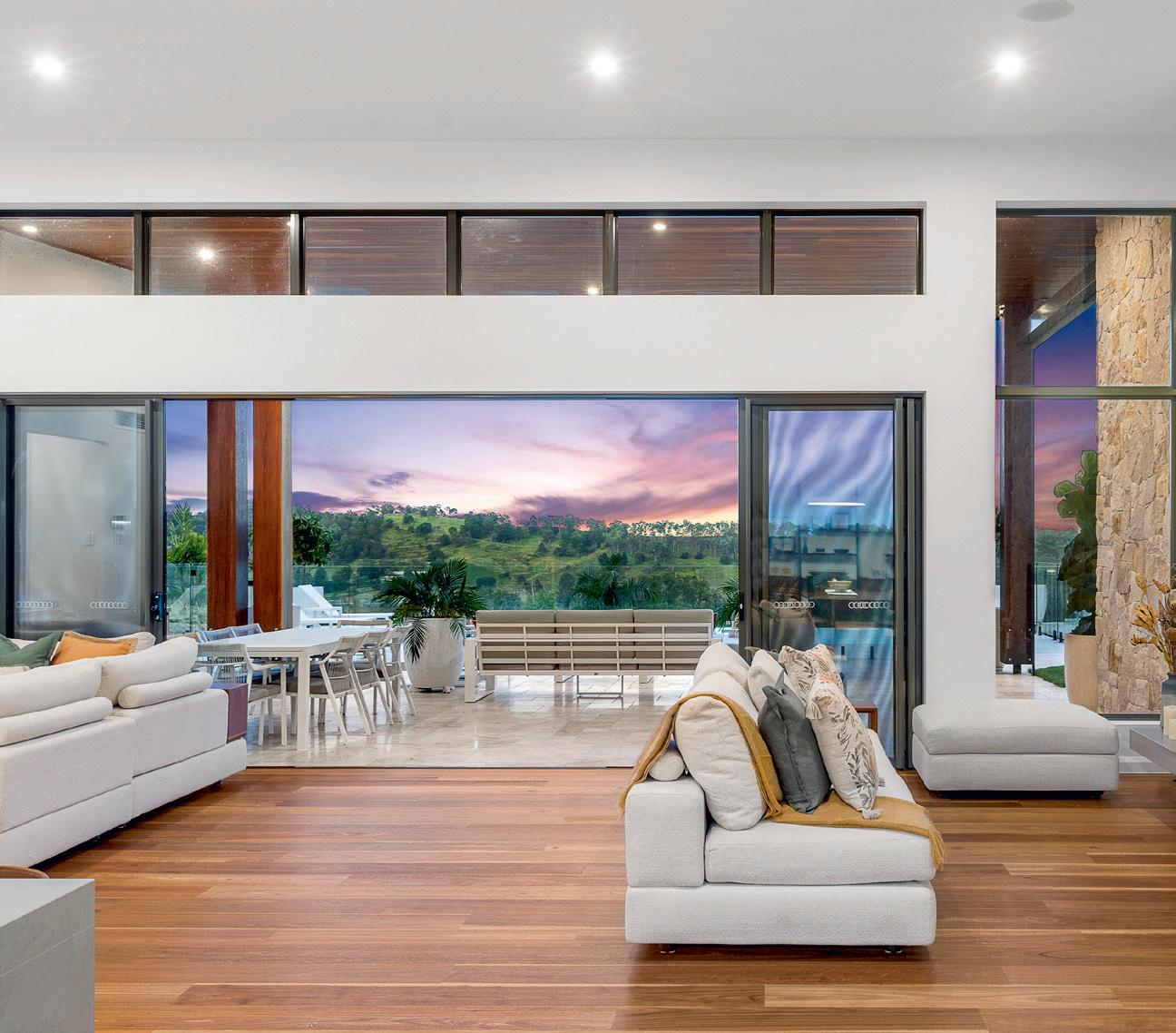
 Glass Co Metro Showroom Glass Co Metro
Emmerson Jason Windows
Altair IGLU Double Glazed Louvre System Breezway
Flush Drain Sill System
G.James Windows & Doors
Umbra Flush Mortice Lock Doric Products Pty Ltd
Bruce Rocksberg House Dowell Windows + Doors
Glass Co Metro Showroom Glass Co Metro
Emmerson Jason Windows
Altair IGLU Double Glazed Louvre System Breezway
Flush Drain Sill System
G.James Windows & Doors
Umbra Flush Mortice Lock Doric Products Pty Ltd
Bruce Rocksberg House Dowell Windows + Doors
BuiltView Magazine is a quarterly publication of the Australian Glass & Window Association.
EDITORS
Melissa Baker, Ingrid Pagura


SUB EDITOR
Helen Dawes
DESIGN
Webqem Pty Ltd
Ahmad Awick, AGWA
EDITORIAL & ADVERTISING
ENQUIRIES
Helen Dawes
+61 2 9498 2768 marketing@agwa.com.au
PUBLISHED BY
AWA-AGGA LIMITED
ABN 57 629 335 208
Suite 1, Level 1, Building 1, 20 Bridge Street, Pymble NSW 2073 +61 2 9498 2768 admin@agwa.com.au www.agwa.com.au
COVER IMAGE & CONTENTS PAGE IMAGE
835 High Street, Armadale, VIC
Project by Thermeco
Architect: Carr Design
Builder: Flux Construction
Fabricator: European Window Co
Photograph: Rory Gardiner
CONTRIBUTORS
Clinton Skeoch, Atul Singh, Todd McInnis, Maurice Tapang, Craig Howard, Horst Mertes, Joost Bouten, Luca Mosca, Shane McDuff, Ingrid Pagura, Adam Davies, Mari Lehtinen, Roger Bishop, Joshua Ianni, Lido Russo, Kellie Moore, Emma Savage, Lee Thurbon, Helen Dawes, Melissa Baker, Vivienne Munter, Kerrie Henderson, Ahmad Awick and Dominique Macartney.
PRINTED BY
SOUTHERN IMPACT southernimpact.com.au
Our printer conforms to the ISO-14001 environmental management standard and the ISO-9001 quality management standard.
DISTRIBUTED BY D & D MAILING SERVICES www.ddmail.com.au
BuiltView Magazine is proudly packaged in Biowrap, 100% degradable plastic wrapping.
DISCLAIMER
Copyright © 2023. All rights reserved.
Reproduction in whole or part without written permission from AWAAGGA Limited is strictly prohibited. It is impossible for the publisher to ensure that the advertisements and other material herein comply with the Australian Consumer Law Competition and Consumer Act 2010. Readers should make their own inquiries in making decisions and where necessary seek professional advice.
It is with great pleasure that I address you in this edition of BuiltView Magazine. While for many the NCC 2022 general provisions are in place, with the announcements and timelines a distant memory, the livable housing and energy-efficiency measures have not yet been adopted. However, in the rugged world of construction policy, not all is as it seems with several key sector groups pushing hard for up to a further two-year delay in the adoption of these important measures. As an industry we have invested well over $180 million in capacity, machinery, tools, training, product development and people to meet the new energy-efficiency measures. Our message to the various state and territory governments has been focused on ensuring they hold the line. Through numerous meetings and calls with departments, advisors and ministers we have emphasised the need to maintain the successful implementation of the National Construction Code 2022 (NCC 2022) with the previously announced time frames.

While it is true that we have experienced some minor slippages in the adoption time frames, they have not been of the size and quantum advocated by some builders and feared by many of them. AGWA has been unwavering in its focus on advancing energy efficiency in the built environment and the investments and support of our members has been pivotal in demonstrating the industries preparedness and future focus. I want to take a moment to thank those who have assisted us on this journey.
In parallel to this key advocacy journey, we have been working closely with the NSW Government to engage in the development of the draft trade licensing frameworks for the new NSW Building Act and we hope that these changes will form the foundation of further licensing improvements across the country. In support of this important agenda, I would like to extend my gratitude to the NSW Chapter for their invaluable support and feedback in this endeavour.
While ongoing consultations with the NSW Government are still underway, the latest guidance at the time of writing this, is that is that it is highly likely that a Glazing License will be mandatory for all building classes, including commercial structures, a large expansion of the current licensing framework in NSW. Furthermore, the value of monetary threshold for work is likely to be reduced with any glazing work exceeding $3,000 in value being likely to require a license. This development signifies a significant step forward in ensuring the highest standards of professionalism and expertise in the glazing industry. We remain committed to advocating for the best interests of our members and will continue to consult with the NSW Government to shape the final trade licensing frameworks and keep our members up to date with progress.
On a separate note, I would like to take this opportunity to express my sincere appreciation to Roy Loftus of Nu-Look Glass and Aluminium Windows in WA. After many years of dedicated service to AGWA and AWA, he has stepped down from the AGWA Board. His contributions have been invaluable, and the Board and I are grateful for his commitment, candour, perspective and engagement with the Association particularly during its formative stages.



With this change in WA and the recent passing of Liz North, the AGWA Board had vacancies for the WA and the NSW window board positions. Given this, I am pleased to announce the appointment of Daniel Gaunt from Glass Co Metro in WA and Chloe Luhrs from DLG Aluminium and Glazing from regional NSW as our new sector representatives. Both Daniel and Chloe bring strong industry experience and a fresh perspective to the Board. We look forward to their contributions in driving our Association's vision forward.




As we forge ahead, I encourage all members to remain engaged and to actively participate in our initiatives. We have a lot on and a lot to achieve. If you have any questions, I encourage you to reach out to me or the team.
I look forward to seeing you at the AusFenEx23 Conference and celebrating all that is great about our industry as we learn about the opportunities ahead.
 Dean Haritos Chair
Clinton Skeoch Secretary
Deb Deeth Member
Greg Hunt Member
Corne Kritzinger Member
Chloe Luhrs Member
Peter den Boer Vice Chair
Tony Paarhammer Treasurer
Daniel Gaunt Member
Scott Kelly Member Perry Long Member
Dean Haritos Chair
Clinton Skeoch Secretary
Deb Deeth Member
Greg Hunt Member
Corne Kritzinger Member
Chloe Luhrs Member
Peter den Boer Vice Chair
Tony Paarhammer Treasurer
Daniel Gaunt Member
Scott Kelly Member Perry Long Member
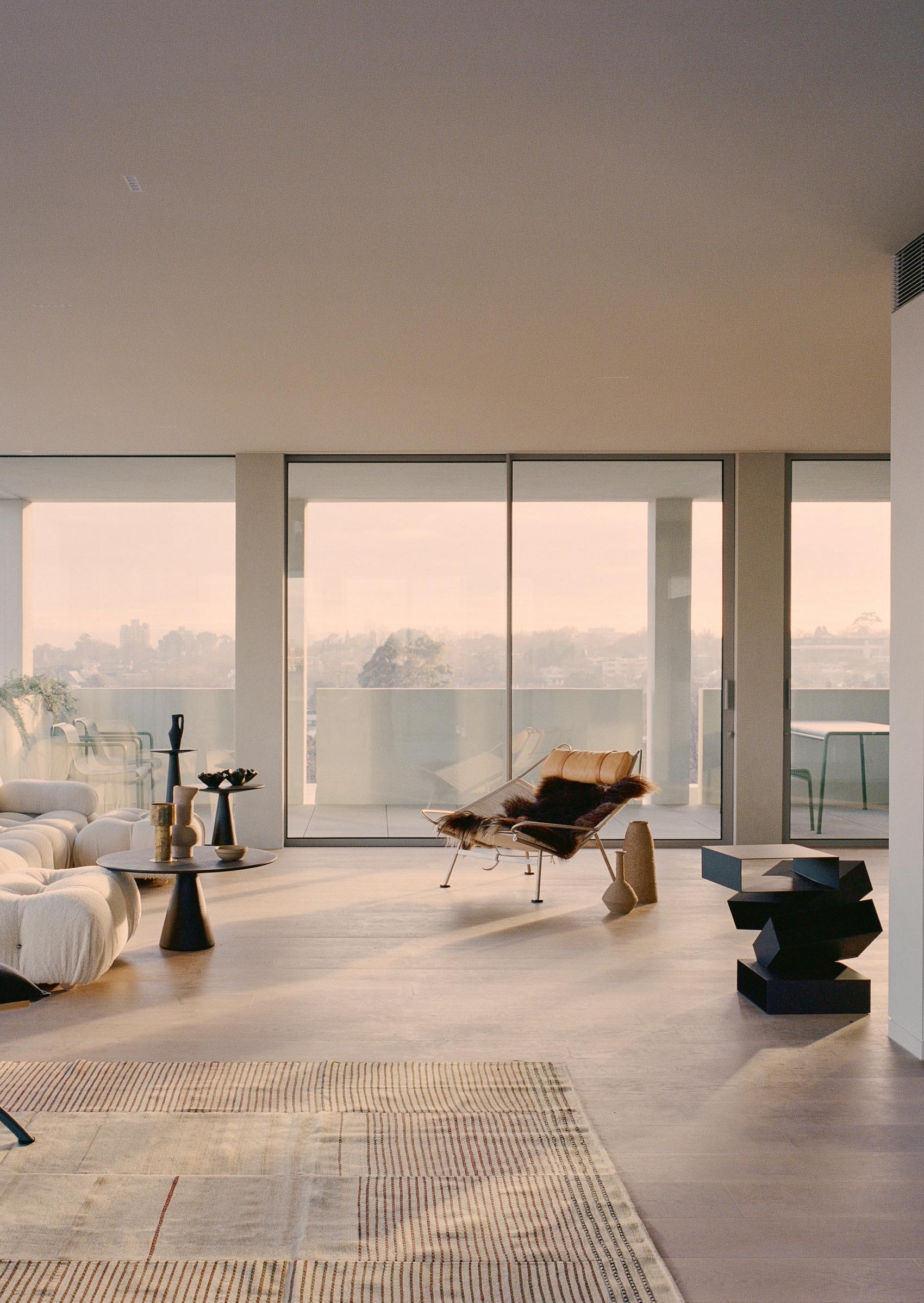
COVER AND CONTENTS:
One of our design entries in the 2023 AGWA Design Awards
Welcome to 835 High St, Armadale. Featuring an architectural language of its own, the building of 835 High St is shaped by a distinctive grid pattern. Every horizontal and vertical frame aligns perfectly from the outside over five levels, one atop the other in a linear pattern. The façades to the east and south are highly refined and detailed, while those to the north and west gradually step back, wrapping around and dissolving the form with the use of the framing. The effect is calmness through consistency, balance through repetition. The minimal windows and glazing together with the colour palette, design and materials creates a humble and enjoyable site.

Atul is a Director at Adams & Partners in charge of the Litigation Department, covering both Civil and Criminal Litigations. He has over 17 years of experience in the legal industry in the public and the private sectors, successfully achieving great and practical results for businesses and individuals in New South Wales. His experience expands from extensive court work in litigation & appeals in criminal and civil matters, including contracts, building & construction, contracts, defects, property & development, extraditions and defence proceedings.
Atul was also a recipient of the Minister’s Award during his time with the public sector.
Ingrid Pagura Industry Development Coordinator, AGWAIngrid began her role with AGWA in May 2021 looking after the training needs of members. Her role soon progressed to include working on BuiltView, the AGWA Design Awards, the website and other marketingrelated activities.

Prior to AGWA, Ingrid worked for a legal publishing company as an editor, a publishing manager and then an editorial trainer. Her time at Butterworths saw her work on their building and local government and environment suite of products and with the CSIRO and ABCB on other BCA projects. She also previously worked for many years as a part time teacher at TAFE teaching law, business, communications and work health and safety across multiple faculties.

Horst has been working in the software industry for glass and window processing for more than 37 years. He speaks seven languages fluently and has been working world-wide promoting and developing integrated and modern software solutions to the marketplace. In 2007, Horst joined US-based software specialist FeneTech as VP of Sales & Marketing. Today FeneTech is part of the Cyncly group of companies who employ more than 2400 talented software specialists. FeneTech offers a leading completely integrated and modern software ERP solution which has been installed in more than 220 companies world-wide, including Australia. Horst has spoken at various other conferences worldwide including GPD, GPAD or other industry events.
Luca Mosca Sales Area Manager, Monticelli
Luca's role at Monticelli is to provide companies with assembling solutions useful to improve both quality and production of their Aluminium Systems. Luca oversees the Northern European, Eastern European and Oceania markets. Monticelli is the only company specialised exclusively in corner joints, from their design and development to the manufacture of the finished piece, which is fully carried out in Italy. Monticelli’s purpose is to ensure that each profile is perfectly connected and aligned, combining quality, speed and affordability. This attention to detail translates into top quality corner joints, with a vast range of over 4000 products.
Joost Bouten Sales Director, Orgadata AustraliaJoost Bouten started in the window and door industry assembling and installing. After graduating as a Mechanical Engineer and working for several years as Facade Engineer, he graduated in Business Management and started as first employee for the software company Orgadata Benelux. After making Orgadata Benelux market leader, Joost moved to Australia to setup the Australian department.
Craig Howard is the Managing Director of EnduroShield and with over 20 years’ industry experience, he has a deep understanding of the challenges involving glass faced by processors, architects, designers, building owners, installers and end users and is dedicated to finding solutions to these challenges. Under his leadership, EnduroShield has become a leading provider of glass protection solutions, helping to enhance the durability and longevity of glass surfaces. With Craig's commitment to excellence and his technical expertise, EnduroShield continues to deliver impressive results and make a positive impact on the industry.
Todd McInnis Senior Economist, HIATodd is an economist with over 15 years' experience in a broad range of fields. Prior to joining HIA, he spent two years as an independent contractor with the government and private sectors. He is currently completing a Masters degree in Applied Economics with Macquarie University.




 Adam Davies Accreditation/IGMA Manager, AGWA
Adam Davies Accreditation/IGMA Manager, AGWA
Maurice graduated with a Bachelor of Economics from the University of Sydney in 2021, majoring in Financial Economics and Econometrics. Maurice comes from a construction background, with his family involved in the quarrying, hauling, earthmoving, and waste business in the Philippines.
Adam holds a degree in Materials Engineering from the University of NSW and started his glass career as a parttime employee at the Viridian Ingleburn float line in his final year of study. After graduation, he moved into a full-time role as a Process Engineer and later to Technical Manager at Viridian. Adam has seen most aspects of the industry. Adam has brought new structure and process development skills to the AGWA Accreditation Programs to support members, drawing on his experience in glass processing, warranty investigation and reporting, and product testing.



Can award entitlements such as penalty rates, allowances, and loadings be included within an employee’s salary or wage? One of our goals is efficiency in record keeping and calculating payroll.
It is common practice to include award entitlements within a salary or rate of pay, which is usually fine so long as:
• an employee's total remuneration is no less than their award/enterprise agreement requires;
• there is a written agreement acknowledging that certain award entitlements are included within an employee’s remuneration; and
• employers keep adequate records of hours worked and duties performed.
In the case of any employees who have a guarantee of earnings in place and who are paid above the high-income threshold (HIT), this becomes a moot point as Modern Awards do not apply to them because their income is deemed adequate compensation for all Award entitlements. The high-income threshold as of now (April 2023) is $162,000 per annum.
For employees below the HIT (or above the HIT without a guarantee of earnings), the employee’s specific Award/Enterprise Agreement is very important as many have clauses that will describe exactly how certain entitlements can be included within the salary or rate of pay.
For instance, a small number of Modern Awards incorporate a similar concept as they have a ‘salary absorption’ clause that exempts managerial staff from specific award entitlements above a certain salary threshold.
Many Modern Awards now incorporate an ‘Annualised Wage Arrangements’
model clause which details the minimum requirements for such an arrangement:
1. The clause first lists those penalty rates, allowances and loadings that can be included within an annualised wage.
2. It requires that a written agreement be made specifying:
• which of the provisions of the award will be satisfied by payment of the annualised wage;
• the method by which the annualised wage has been calculated, including specification of each separate component of the annualised wage and any overtime or penalty assumptions used in the calculation; and
• the maximum limit on what the annualised wage will cover whereby any hours worked beyond that limit would earn additional pay in accordance with the award.
3. At least once every 12 months employers must calculate the total remuneration an employee would have earned if paid according to the award ie, earning the award minimum rate plus all other applicable award entitlements (eg, penalty rates, allowances, loadings etc) for the exact hours they worked. If their annualised wages fall short of the award, and the shortfall wasn’t made up in the relevant pay cycle when it occurred, then employers must backpay that shortfall in the annual review.
4. The employer must keep a record of the starting and finishing times of work, and any unpaid breaks taken, by each employee for the purpose of undertaking the 12 months’ comparison mentioned above. This record must be signed by the employee each pay period or roster cycle.
Many employers question that fourth point as they hope to avoid such onerous time and record-keeping requirements. The good news here is that in practical terms employers only really need to keep records of hours worked and duties performed outside of those that the annualised wage has been calculated to cover. For example, let’s say an annualised wage was calculated to compensate for an average of 45 hours work per week (inclusive of applicable overtime and shift penalties under their award), and presumed no weekends or
public holidays would be required. Then employers only need to record hours outside those parameters ie, hours beyond 45 per week, and any weekend or public holiday hours, or when the employee was filling for another on higher duties. Then these extras would have to be paid for separately within each pay cycle, to comply with the annualised wage clause.
Another way to incorporate award entitlements into a higher salary or rate of pay is through a written Individual Flexibility Agreement (IFA). However, the two major drawbacks to an IFA are that first they cannot be made a condition of employment (ie, they can only be made with an existing employee, not a new candidate) and second, either party can unilaterally cancel the agreement with 13 weeks’ notice.
Thus, the approach that is generally the most recommended when wanting to incorporate award entitlements into an employee’s remuneration while ensuring that they are not underpaid, and minimising the record-keeping burden, is to use a compensation for legal entitlements clause or offset clause in an employee’s common law contract. Such a clause should make clear that both parties agree that the remuneration specified in the employment contract compensates the employee for any award entitlements (such as wages, overtime, allowances, penalties, and loadings) that may arise for any hours worked in the course of employment.
Of course, the remuneration provided must meet or exceed what the award requires for the same hours and duties performed. It is highly recommended that employers seek legal advice on the drafting of such clauses and ensure the correct award that covers the employee (if any) is identified as well as the relevant classification.
The bottom line: Employers can incorporate award entitlements into a higher remuneration, so long as a written agreement is in place, specifying what entitlements are compensated for and employers ensure an employee’s remuneration does not fall below what the award requires. Employers must maintain adequate records of work performed because the onus of proof is always on employers in answering any underpayment claim.

Having a worker who has been off on leave due to an injury or illness can be stressful for everyone involved. Having that worker return to work can also be stressful for everyone involved. Your injured worked doesn’t need to be fully recovered or finished their medical treatment for them to return to work. Often complete recovery doesn’t happen until they are back at work. Generally, returning to work post-injury isn’t always easy but long-term absences from work have negative health impacts, including the reduced likelihood of ever returning to work.
Returning to work has benefits for all involved. For injured workers returning to work can:

• Enhance the recovery process
• Increase social participation and confidence
• Decrease the physical, psychological, social and economic effects of being absent from work.
For employers, playing an active role in the return to work can:
• Help your worker recover faster
• Keep the skills and knowledge of the worker in the business
• Reduce costs associated with finding and training new staff
• Build morale within the workplace.
A gradual return to work can help as it can help minimise the risk of being injured again or making the original injury worse. As an
employer you are required to provide modified or gradual return to work options
This is a complex situation and varies from person to person, however a successful return to work is more likely if done gradually. Often, even starting these conversations can be daunting. Safe Work Australia has put together a guide for supervisors in small and medium businesses to help with this. It is called Managingthe RelationshipwithanInjuredorIllWorkerDuringReturntoWork. This Guide covers the process from the injury to the return to work, including conversation starters. That first step is often the hardest. It includes suggestions as to what to include in conversations, checklists and even how to talk to the rest of the team. It is really an invaluable tool that can help take the awkwardness out of a difficult situation.
If you would like a copy of the Guide, please see safeworkaustralia.gov.au or contact AGWA at training@agwa.com.au.
It is with great pleasure that I announce that the 2023 AGWA Safety Award finalists are:
1.Lucidity Rollout by Glass Co Metro (WA)
The system provides a ‘single source of truth’ and clear visibility as well as integrated and automated reporting including safety goal tracking, task completion status on actions from audits or inspections, and incident management. It gets rid of the standard paper types of systems used traditionally by businesses of our size and makes reporting easier. We would be able to demonstrate due diligence and sound record keeping should a serious incident occur.
2.Heavy Lifting Safety Solution by Festival Glass (SA)
This Festival Glass & Glazing safety improvement program identified the need to eliminate soft tissue and back injuries by investigating and then implementing factory and onsite mobile mechanical lifting equipment, to ensure a safer and more productive workplace. This fundamental program has been an exciting and valuable WHS benefit to our team now and into the future, and our team continue
to see the benefits by working and staying safe. We believe that the results speak for themselves – the complete elimination of all soft tissue injuries in the 3 years since the implementation of the solution is an award-winning achievement for our team and an outstanding example of continuous WHS improvement that can benefit the glazing industry.
3.No Injury November by AGG (NSW)
The AGG NSW ‘No Injury November’ initiative was designed to find practical ways to have safety ‘top of mind’ during the busiest time of the year. A heavy focus in one month with activities, prizes, training and guest speakers and designed to kick start a more intense focus on safety that continues throughout the year. Also hoping it can be embraced by other companies to improve the safety of all industry participants.
Engagement was pleasantly encompassing with all team members being active and contributing. We continue to witness validated effectiveness as it is still referred to today (5 months later) and we are especially proud of the team.
4.Partnership with University of SA to host final-year Physiotherapy students by Aussie Aluminium (SA)
The work performed to manufacture aluminium windows and doors is very labour intensive, with an ageing experienced workforce, combined with architects designing bigger and bigger doors and windows the importance of working safely i s now at the forefront of our core responsibility as an employer. The partnership between Aussie Aluminium and the University of South Australia has enabled business owners, Davis and Tiffany Perin to implement and provide their staff with a much safer, compliant workplace for their employees. The reports presented by the students have assisted in the strategic planning for preventing workplace injuries and many of the recommendations given have been implemented. We currently have students researching an industry-specific manual handling training package that we will use as part of our staff training.
The main driver of Australia’s housing shortage is population growth — more people needing more houses. In the year to September 2022, Australia’s population grew by 1.63%, up on its 10-year average of 1.36%. So, not only do we need more houses, but we actually need more than previously thought.
Adding to that pressure is the fact that the average household size has been consistently falling over the past few decades — or in other words, the same number of people need more houses today than they did in, say, the early 1990s. These pressures are not likely to change anytime soon as people these days have fewer kids and are more likely to live by themselves. So, we don’t have enough houses to cater for our existing population, let alone one that’s growing at around 400,000 people per year. And, given that the shortage is nothing new, there’s already an accumulated shortfall. Fortunately, the Federal Government is beginning to recognise this. In its most recent forecasts, the National Housing Finance and Investment Corporation (NHFIC) estimated that by 2028 we’ll have 100,000 fewer homes than we need. This is an under-estimate because it assumed a population growth of around half what we’re currently seeing, and it also didn’t consider an existing shortfall — but that’s another story.
 Todd McInnis, HIA Senior Economist Maurice Tapang, HIA Economist.
Todd McInnis, HIA Senior Economist Maurice Tapang, HIA Economist.
The Government’s target of building a million homes over five years from 2024 is similarly a positive development. While it won’t be enough to address the housing shortage, it at least provides a bit of certainty for all those sectors that depend on a strong housing market.
One of the simplest and most obvious ways to boost our housing stock is to attract more foreign investment. The argument that foreign investment takes away from Australians’ housing options does not stack up. Foreign investors have been restricted to only investing in building new apartments across Australia and, therefore, do not compete in the established home market. They can only build new homes. Their exit from the market is a key reason apartment supply is contracting.
The reasons why Australia has under-supplied homes for decades revolve around a systemic failure of government. Here we consider what are probably the two main failures of government: taxes and Regulations.
There are few items in our economy that are more heavily taxed than new homes. There is a long list of taxes, fees and charges imposed on new home building from Stamp Duty through to a ‘temporary levy’ imposed to recover the cost of the HIH collapse in 2001. Governments tax tobacco to impede its consumption, and by t axing new homes, they achieve the outcome of building fewer homes.
The effect is even more pronounced for foreign investors. Attracting more foreign investment to the housing market is one clear way of alleviating the housing shortage. Unfortunately, both state and federal governments have implemented a raft of Regulations and taxes in recent years aimed at precisely the opposite.
All this adds up. HIA estimates that an overseas investor looking to purchase an average property in Sydney — by far the largest market — must pay $150,000 in stamp duty, land tax and FIRB fees, around three-quarters of which is solely through foreign surcharges. Altogether, stamp duty, land tax and FIRB fees account for between 15-20% of the median dwelling price in major housing markets.
There are also proposals to tax domestic investors, or restrict short-term rentals, all of which would restrict the supply of housing. Apartment construction remains the cheapest, fastest option to increase the stock of housing in locations
where there are stable and reliable employment opportunities.
For this reason, given the acute shortage of housing stock, the advice to policy makers at all tiers of government, is stop making new homes more expensive. It only makes the problem worse.
Australia ranked at number 80 out of 140 countries in overall burden of government regulation, according to the World Economic Forum’s 2019 Global Competitiveness Report. That’s just behind Vietnam (ranked 79) and well behind China (ranked 19). The housing sector is arguably one of the most heavily regulated sectors in Australia. To be one of the most heavily regulated sectors in one of the most heavily regulated countries does not do much to encourage more housing supply.

Some regulation is necessary, just as overregulation can discourage investment, so too does under-regulation. But Australia is far too heavily swayed toward the former. For example, owner occupiers, especially first home buyers, have been forced away from ownership by increasingly restrictive lending Regulations. These restrictions have been ramped up over the past 15 years, largely because of the Global Financial Crisis in 2008, despite a lack of evidence that there is a problem with mortgage delinquency in Australia. This has resulted in reduced competition for lending to first home buyers and those with less than a 20% deposit. This further reduces the pool of investment for new home building.
Different states and territories also have a raft of different Regulations, which adds an additional challenge for those who operate across borders — which is most. What suffices for one state may not suffice for another, which adds to the overall cost of regulation. One element of this that is often not fully appreciated is the extent to which a heavily regulated society actually generates more self-regulation. Or to put it another way, the more burdensome government Regulations are, the more internal process procedures that private businesses will put in place to ensure they’re compliant with the government’s Regulations.
There are some promising signs ahead for the housing market and all the sub-sectors that depend on it, but government taxes, at both the state and federal level, and Regulations need to be amended if the sector is to work at maximal capacity.











Azuma has installed two new large chambers that are designed for testing up to 20 kPa positive and negative pressures. Highly trained testing technicians will be with you every step of the way to provide all the equipment & guidance that you may require.
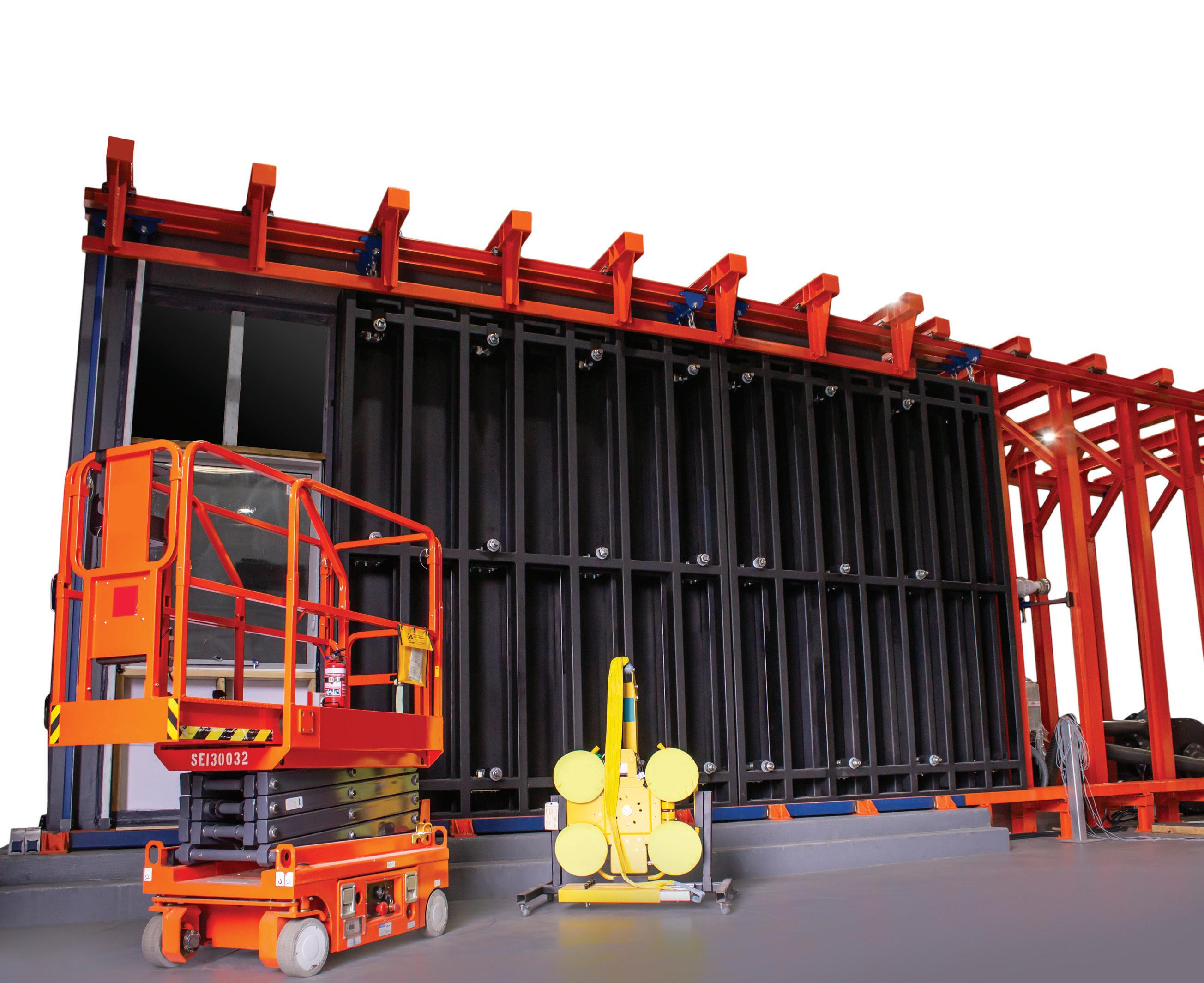
These new chambers are capable of testing to the requirements of:
AS2047 - “Windows and External Glazed Doors in Buildings”
AS4040 - Parts 2 and 3 “Method for testing Roof sheet and Cladding”
AS4284 - Testing of building Facades (Cyclic Water).
Each state or territory implements the NCC through its regulatory framework covering building and plumbing work. These changes place additional responsibilities on all builders, developers, and tradies. When entering into a contract (or subcontract), each party must be aware of their obligations and responsibilities under NCC 2022 and the contract that they are taking on board.
This will have a follow-on effect on the materials that you contract to supply/receive. Builders will need to ensure that all documentation they receive from other contractors or subcontractors, including designs and test certificates, is aligned with the NCC 2022. It is important to carry out a ‘health check’ of all your compliance documentation to ensure it meets the new requirements. In some cases, they may require amending to be valid.
Among the new obligations is included a push for more energy-efficient homes. As such, you will need to turn your mind to, and accommodate, better insulation in your contractual documents and consider the performance of windows and solar panels where needed. The minimum level of thermal performance of new homes is to be raised to the equivalent of 7-stars under the National House Energy Rating Scheme. Your contract documents will now need to reflect this depending on the site or location of the build, in order to comply with the energy requirements.
NCC 2022 also places emphasis on improving accessibility and provides specific measurements for constructions of hallways and doors. Standard size hallways and doors previously relied on by builders will no longer be compliant under the new regime. Have you checked whether these obligations have been passed on to you under the contract that you have entered into?
Where, as part of a contract, an owner is to select particular materials or products, you must ensure they comply with NCC 2022. Where a builder engages a subcontractor to install particular product the onus is on the builder to ensure that the materials, products, and method of installation are in line

with NCC 2022 and its objectives. These extra requirements will no doubt reflect on the costs of any contract.
Where an owner wishes to construct a hallway or door in a particular way, they must consider the expressed provisions of the NCC 2022 and its objective of improving accessibility.
Such legal obligations will almost without a doubt be passed onto the installer/ supplier. The question is, are you reading and understanding what contractual (and therefore legal) obligations have been placed on you?

Ensure that in any contract that you enter into you:
• Understand what your obligations are;
• Are clear on which relevant Standard and/or Code is relied upon;
• Have sufficient details in all respects.
If you are unclear, obtain formal verification prior to signing and confirm that all works required of you in the contract are within your expertise.
If you require any legal advice or assistance for personal and/or commercial matters, get in touch with Adams & Partners, Lawyers at multiple locations on (02) 4721 6200 or visit www.adamslawyers.com.au
In light of the new National Construction Code 2022 (NCC 2022), parts of which came into effect from 1 May 2023, are you ensuring that you are aware of what your contractual obligations are?
In the increasingly competitive world of flat glass processing, industry players are not just grappling with the need to automate their machinery and robotics, but also the pressing challenge of outdated and disjointed administrative processes. With a significant portion of businesses still relying on bespoke software solutions or dated packages designed for the industry, they are left confronting issues such as inconsistent data across different databases and subpar system response times — issues that are further exacerbated for companies operating multiple branches nationwide.
This highlights the importance of moving towards a modern, fully integrated ERP (Enterprise Resource Planning) solution that unifies all essential functions within a single central database, from quotation management and production scheduling to invoicing. Such a shift can significantly mitigate these challenges, ensuring smoother operations, better efficiency, and a stronger competitive stance.

An ERP software system is an IT-based system of software solutions helping management to keep track of existing resources and business processes. With the help of an ERP system, management can optimally design, influence and manage all processes effectively. ERP systems are integrated programs and modules based on central data management. Part of the claim of an ERP system is that it is integrative and maps the company, both in the cross-divisional basic functions and in the specialist departments or functional areas of a company.
The efficient storage of large amounts of data, its collection and analysis represent a serious challenge for ERP systems in larger companies and enterprises. Although an ERP system can consist of numerous software modules, it can only fulfill its task across all industries if the data is unique throughout the company and only available once. Information is derived from
data and represents the most valuable asset in companies. That is why clean and valuable data is so important.
The data management itself is one of the most important aspects of modern software ERP solutions. The key is to decide whether to use centralised or decentralised data management. Centralised data management has several advantages over the use of decentralised systems. One key advantage of using centralised data, for example, is the need for a single and central database system. This simplifies the maintenance of collected data, as all data is stored in a uniform structure. This can simplify searching for specific information in the database, as all data is located in the same place. In addition, centralised management will also reduce maintenance costs since there is only a single database system.
An additional advantage of centralised management is improved data security. In a centralised database, permissions can be set for each user so that only authorised individuals have access to specific data. This improved security feature makes it easier to build an overall secure network.
Another important benefit is the streamlining of data access. By using a central database system, users can access the same data even if they are located at different sites. This allows the company to ensure that information is managed quickly and efficiently. In the flat glass processing industry, this is even more important for larger companies and enterprises who operate different branches across the country, but only one server and database is accessed via modern and fast WAN connections. All branches can be created and managed in this central database with their own settings and variations. This includes branch-specific data, such as delivery route information, machinery and capacity variations and restrictions, etc.
The advantage of this concept is that certain database tables such as customer tables, credit limits or pricing data can be maintained centrally for all branches. This facilitates data maintenance a great deal in the case of price increases, for example and eliminates the duplication of customer data in the case of end customers dealing with various branches of the enterprise. A centralised database offers some significant advantages over decentralised management. By implementing a central database system, a company can store its data securely and manage it more efficiently, quickly and cost-effectively.

The term ERP as a Service (analogous to SaaS — Software as a Service) emerged as early as the 2000s. It stands for a new generation of ERP systems — ERP in the Cloud . Soon, these systems will replace today's traditional solutions. The systems will then be Internet-based and platformindependent (Cloud). In addition, they are easily scalable. ERP as a Service is particularly suitable for small and mediumsized companies due to its scalability. Furthermore, adjustments and changes can be made even faster due to the webbased, functional and open architecture. The term ERP as a Service has now been replaced by ERP in the Cloud or Cloud ERP.
One of the most important aspects in today’s challenging and competitive glass industry is the full integration of the different functions in one central system. A key function is a comprehensive, dynamic and flexible capacity planning tool, not only to balance machinery capacities, but also to ensure on-time deliveries and perfect customer service. Many existing software solutions in our industry do offer such tools but unfortunately, due to the system architecture using multiple databases, capacity planning usually resides on the production side of the system.
kept as short as possible. At the same time, maintenance work is necessary to ensure that the production flow runs without interruption as much as possible. If maintenance on machinery is necessary, it needs to be planned ahead of time, so that time slots can be reserved for these maintenance cycles meaning that production capacity is planned dynamically around these slots.
Why is capacity planning so important in the glass processing industry?
Inadequate capacity planning results in, among other things, an increase in the so-called idle capacity costs in a glass processing company, as excess capacity then becomes a cost factor. For example, staff members who are not needed at a certain point in time must still be paid. Idle costs can also arise from the downtime of machines and systems. In production, low machinery utilisation drives up unit costs due to the high proportion of fixed overheads. When capacity utilisation is high, on the other hand, the fixed costs are spread over a higher number of produced units, so that the proportion of idle costs is
reduced. This approach can also be applied to other areas — for example, the service sector or larger projects: over-capacities are always cost-relevant. The same applies to under-capacities, which can bring the entire process of delivery to a standstill. However, many companies consciously accept over-capacities to maintain their flexibility for new orders. This can only be achieved in an optimal way with integrated and powerful capacity planning software. Other important advantages of capacity planning are as follows:
• Planning deviations and bottlenecks are mitigated by resource planning at strategic, tactical and operational levels. In this way, companies ensure that sufficient resources are available for all activities (machinery time and staff).
• Continuous capacity planning secures the flexibility of glass processing companies better than the automatic provision of excess capacities. Resource requirements and resource supply — including a buffer for unforeseen events — are better coordinated.
It is essential, however, that capacity planning is done right at the point of order entry, completely interactive and in real-time as order items are entered into the system. This ensures that eventual capacity bottlenecks or other technical problems (physical restrictions of existing machinery, for example) are detected right at the beginning and that an accurate delivery time can be confirmed to the final customer. Because of that reason, it is so important that the capacity planning function resides as an integral tool in order processing. In production, while machines are usually available around the clock, the employees can usually only work eight hours a day or a shift. To keep downtime to a minimum, set-up times, which are used for setting up machines or preparing production batches, for example, as well as times spent on maintenance, must be Fig.2 Detailed drawings for both customer and production using integrated CAD
• The results of a functioning resource planning system also include a valid and constantly updated database. The data generated in this way makes an important contribution to forecasts, to the optimisation of processes, to the planning and implementation of new projects or as a basis for change management in the company or to adjust capacity parameters for the future.
• The workload of employees is more balanced. This effectively prevents excessive demands and underdemands on individual employees or groups of employees. Through their human resources capacity planning, companies create important prerequisites for a high level of commitment, motivation and employee satisfaction. In this dimension, too, capacity planning is an important productivity factor in the company.

The abbreviation CAD stands for ‘computer-aided design’. In concrete terms, working with CAD software means that individual steps in the design process are no longer carried out manually, but are taken over by the computer software. With the help of CAD software functions, all steps from concept development to handover to the production department can be completed directly on the computer and transported in an electronical data format, such as DXF.
In the flat glass processing industry, CAD is extremely important and needs to be an integral part within the complete ERP system. Many existing glass-specific software solutions on the market use standard CAD solutions, such as AUTOcad and try to interface those to their main systems. Most times these solutions do not offer the necessary integration and flexibility and drawings need to be done in a separate system. Furthermore, such standard CAD solutions are very complex and require extensive training, as they were developed for a wide range of applications.
Therefore, a completely integrated software ERP solution for the glass industry needs to have a completely integrated CAD, but tailored to the glass industry to efficiently create complexshaped units, including edge processing, drill holes, cut-outs, surface processing, such as screen printing, edge printing, special tempering stamps, etc. Such a system needs to be flexible and userfriendly, so that users can be trained in minimal time. As with the capacity planning function, the CAD function needs to reside right at the point of quoting and order entry, as the final customer requires a detailed drawing of the ordered unit with their quote or order confirmation document.
One of the other advantages of such an integrated CAD solution is that the


system can automatically drive pricing of all processes through CAD entry — no separate entry of processing codes (drill hole categories, cut-out categories, processing articles, etc) is necessary to have the system calculate prices and costs based on processing edge lengths, etc. Furthermore, using such an integrated solution will eliminate the so-called CADdepartment in a glass processing company, where staff members usually need to create drawings for all shapes, for each CNC machine separately, all day long as many manufacturers of CNC machinery supply their own CAD solution with their specific own format. Using an integrated tailor-made CAD solution as part of the ERP will create all necessary generic DXF files in the background, ready to be imported by all CNC processing equipment available on the market offering the DXF file standard. In that case, sometimes only tool setting is necessary for some of the CNC processing lines, depending on the brand and the technology offered.
Optimising racks for delivery, such as A-Racks, L-Racks or others becomes as important as optimising glass to ensure that delivery lorries are used to the fullest capacity, while ensuring that weight restrictions and unit sequences are respected. This function should also be part of a modern integrated state-of-the-art software ERP solution for the glass processing industry. On many occasions, final customers, such as window manufacturers require their glass units to be delivered in a certain sequence, streamlined with their own production of window units or sashes to eliminate unnecessary sorting with the risk of breakage or scratches. This process will offer the same advantages to the DGU producer as to the final customer
because production, on both sides, will be completely streamlined and manual glass sorting (on both sides) can be eliminated. The window manufacturer can schedule their own production and then can transmit the scheduling sequence as an order to their DGU supplier, even in electronical data format (EDI). The glass manufacturer on the other hand, using their integrated packing optimisation as part of their own software ERP solution, can schedule their glass unit production using the requested sequence of the final customer. This efficient method saves time and increases productivity, while eliminating sorting and eventual breakage or scratching, especially in the case of soft coated glass types.
One of the key benefits of a completely integrated ERP system tailored to the glass processing industry is that it allows glass companies to streamline processes, eliminate redundant tasks or activities, and reduce the manual effort required to manage resources. There are different software solutions for glass processing on the market, some of them being supplied by machinery manufacturers. An efficient software ERP solution should be based on one single central database, for the reasons stated above and such a solution should be machinery-independent, yet able to control all glass specific production lines available on the market.
The doors for future machinery purchase decisions remain completely open for the company — a great advantage!
The Birchgrove Residence Project encompasses a contemporary addition to the rear of a heritage dwelling that reaches out to, flows down towards and embraces it’s dazzling harbourside location.

The unique curvilinear forms of the architecture create a dynamic interplay of positive and negative space interpreted and defined by an almost liquid flow of the facade glazing system.
The combination of applying a range of traditional glass craft skills with deployment of the latest glass manufacturing technologies has allowed Bent and Curved Glass to provide glazing solutions that meet the challenges presented by this unique architectural design vision.

The project is testament to what can be achieved by local curved glass manufacturer Bent and Curved Glass working with a collaborative approach combining with Architect, Builder and Window fabricator in a collective commitment to achieve the highest level of finish.
Bent and Curved Glass is dedicated to creating the most exciting and successful outcomes for all its’ customers.
Since the start of manufacturing windows and doors in Australia, the automation process has made significant steps. Just think about the introduction of the pneumatic punches, the phone, the fax, the computer, and the mobile phone.
Change is not always easy to come to terms with. Where some struggle with change, others thrive with it. The speed of technical change has rapidly gathered pace, transforming window, door and façade manufacturing beyond recognition. We are now amid the fourth industrial revolution (industry 4.0). Where some of our fellow window and door manufacturers have been able to adapt their productions lines with automated control systems, software, paperless manufacturing and CNC machines, some are still at a position where there is lots to gain.
It's important to understand the full scope of benefits that automation can bring to your company. This is especially so now that we have seen that being reliant on the international supply chain of cost-efficient window and door manufacturing is not always the best strategy. It’s worth taking stock of why automation is something to be welcomed, not feared.
Automating your company can massively increase the productivity of tasks, processes and manufacturing lead times on the shop floor and in the office. Processes that once took a significant amount of skilled labour and time, nowadays can now rely on a standardised work process with information being available to staff at the right time and at the right moment. Just think about it. If you could save between 10%-30% of the time it took to manufacture your projects, this could also increase your productivity, making you more flexible and most importantly, manufacturing a project gets more cost efficient.
The goal is to remove any manual handling within your processes if possible. There are great ERP and Estimation software packages
Automating your company can massively increase the productivity of tasks, processes and manufacturing lead times on the shop floor and in the office. Processes that once took a significant amount of skilled labour and time, nowadays can now rely on a standardised work process with information being available to staff at the right time and at the right moment.

available that can help you to achieve this. For example, if you have multiple software packages, trying to reduce them within your business would be a great place to start. When you order products from multiple suppliers, try to avoid your staff having to adapt to different work processes each time. The fewer software packages your staff need to work with the better as this increases their efficiency, reduces software maintenance, and reduces fail cost because of constant change. Be critical about how you do things and invite your suppliers and partners over to discuss this, as they have the opportunity to share with you methods that work with other businesses.
Did you know that if you improve your company processes it increase your project profit margin? When productivity increases, the cost to process a project automatically reduces. You might think, how does investing all this time and capital into new software, training and machines be financially the best choice? Let’s look at machinery for your factory, as an example. Considering that the total cost of investing in a startup package for CNC machinery equipment equals 2-3 staff members’ annual salary and equally reduces the workload of 2-3 staff members, after just one year, you have organised a massive reduction in cost to manufacture projects.
According to the Society of Manufacturing Engineers 89% of manufacturers have reported difficulty finding skilled workers. Software can help to aid the skilled labour shortage by reducing reliance on it. In the past, manufacturers that purchased a CNC machine needed to train their staff on an engineer-level of programmer, taking weeks or even months to code the new machines with macros. This process also created a dependence on a staff member who was then hard to replace. With software though, there is no need to have an engineer working on the machine. You simply quote a job in your office software which then automatically generates all the codes for all your machines in the factory. Not only do you not need a highly trained engineer, but
you also reduce fail cost because you are not depending on staff to copy that information into your machines as a standard process. In addition, it also saves approximately 30% of the time for the machine operator.


4.
Most companies in Australia have an ERP system using software for quoting, ordering, and manufacturing. just installing these software products and utilising them with staff that only finished the initial training will not necessarily present you with the most efficient outcome. If you are looking to save time and therefore money, you should contact your vendor for a consultation. You will be surprised about the number of software features that you may not be currently using and about methods that you could implement to increase your productivity.
Choosing lower-carbon aluminium in your next project can reduce the embodied energy of your aluminium products by up to 75%* LocAl® Green (8kg CO2e/1kg AL) and LocAl® SuperGreen (4kg CO2e/1kg AL) are the responsible choice for a locally extruded, lower-carbon option in your next project.
LocAl® is standard across Capral’s range of proprietary windows & doors.
FOR MORE INFORMATION VISIT lowcarbonaluminium.com.au

Offering high performance, versatility and design flexibility, the CityView TM range of commercial windows and doors, seamlessly integrate into the aesthetic of any commercial project.

Suitable for a range of architectural and commercial applications, the CityView range has been designed & engineered in Australia and tested to AS2047.

Easy to fabricate & install
Meets & exceeds AS2047
BAL40 Bushfire rated*

Designed and engineered in Australia

BAL 40
BAL

Fire Rating
A system by
WERS rated for energy efficiency
*Refer to www.darleycityview.com.au for more information.
SYDNEY HEAD OFFICE T: (02) 8887 2888 E: sales@darleyaluminium.com.au
To find out more about CityView scan the QR code

MELBOURNE T: (03) 9238 3888 E: salesvic@darleyaluminium.com.au
BRISBANE . T: (07) 3287 1888 . E: salesqld@darleyaluminium.com.au
PERTH . T: (08) 9437 2999 . E: saleswa@darleyaluminium.com.au

Monticelli is an Italian company specialised in the production of connectors and corner joints for aluminum frames. Founded by Domenico Monticelli about 50 years ago, the company has achieved enormous success worldwide thanks to the uniqueness and quality of its wide range of products that not only include aluminum angle corners, but also PVC angle joints, woodaluminum, continuous facades, and variable angles for windows, doors, frames, and shutters.
Design, development, and manufacturing take place entirely in the company's Italian plants. This guarantees a high standard of production and constant quality control throughout the production process. In addition, the company uses cutting-edge technologies to produce connectors, ensuring maximum precision and flexibility in the final product.

Here are some questions that we submitted to the technical office of the world leaders in the production of connectors.

What kind of company is Monticelli?
Monticelli's activity is based only on production of connectors producing a frame with perfectly coplanar closed cuts and sides, ensuring maximum quality and speed of assembly. By focusing all our resources on the creation of this single type of product, the internal technical office can offer customised solutions for every market on a global scale: We are able to adapt our brackets to every profile, with about 50 types and a wide range of over 4,000 articles.
How did you become world leaders in connectors?
Being a leading exponent in the window and door industry requires constant attention to quality and customer needs. Monticelli has distinguished itself in this field thanks to its highly specialised technical office, dedicated to the research and development of innovative products and cutting-edge solutions, offering customers a professional consultancy service.
We are very proud of our growth achieved mainly thanks to our investments in research and development to improve the quality of our products. For example, we have adopted the aluminum die-casting process to obtain connectors with a perfect finish and high corrosion resistance. In addition, we have always tried to adapt to market needs, maintaining a focus on customer satisfaction and quality control. Finally, we have implemented an Environmental Management System to reduce waste and comply with environmental regulations, demonstrating our commitment to sustainability and social responsibility.
Our flagship product is represented by the ‘Tonale’ bracket, unique in its kind and multifunctional, which guarantees precision, simplicity, and assembly flexibility. Tonale is a corner joint in die-cast aluminum, designed to meet the multiple needs of the frame. Thanks
to its high resistance, we recommended it for doors, shutters, or armored frames, but it has also found use in classic frames.
How to distinguish a high-quality corner?
Monticelli's corners are different from those made by extrusion, which are usually thin and can easily deform. Our products not only do not aesthetically deform but can also correct any defects caused during the cutting phase, without altering the original appearance of the profile. The ‘Tonale’ corner joint, for example, boasts incredible mechanical strength, precision, and assembly speed. We also offer ‘alignment’ corner joints to perfectly align the frame.
Why choose Monticelli corner joints over others?
Our range of die-cast aluminum corner joints offers thickness and rigidity to the frame, ensuring higher quality. Unlike extruded or screwed brackets, our die-cast aluminum corner joints maintain their shape over time, providing customers with a durable and reliable solution. With our die-cast aluminum corner joints, there is no material waste, and they are easy to assemble for every operator, even the less experienced.

What are the advantages of a die-cast corner joint?

Monticelli uses aluminum die-casting to produce corner joints quickly and with an excellent crystalline finish. This process has numerous advantages, including low costs, high-quality surface finish, longevity, and corrosion resistance.
Why is there a greater economic advantage?
Our company offers economic advantages for using die-cast aluminum corners compared to extruded aluminum. Unlike extruded aluminum, die-cast aluminum corners do not require additional processing such as cutting, labor, and material use. Assembling more complex extruded corners is more expensive because the extruders dealing with profiles
are not equipped to do post-processing on the corners and, therefore, assembly of the components. Thanks to our specialisation in all assemblies and processing, we can contain costs for our customers.

We cater to all window and door manufacturers, from small to medium businesses, and even to more advanced ones with assembly lines. Our wide range of corner joints are designed to meet the specific mounting requirements of different types of window and door manufacturers, ensuring quality, flexibility, and precision. In addition, our specialisation allows us to contain the costs of assembling more complex corner joints compared to other companies, without compromising the quality of the final product. We are pleased to offer our customers the best solution for their work.
We have partnered exclusively with Fenestration Solutions Australia (FSA) as we recognise them as a leading systems supplier with a strong history of helping companies design and develop. Its portfolio of products includes many world-leading brands that perfectly complement Monticelli and its strategies. In Australia, we see an emerging market that suffers from high labour costs, which we believe can benefit from the efficiency improvements in producing perfectly aligned and flush corners and improved sealing and strength when compared with current corner joining practices.
For more information, please contact FSA on +61 3 9773 3966 or email sales@fsa-aus.com.au
 Fig. 2 Double Denal Dett
Fig. 2 Double Denal Dett
Glass professionals are increasingly recognising the growing demand for highly durable spray-on glass protective coatings in the industry. With a keen eye for smarter and more sustainable glazing solutions, designers, architects, and building owners are turning to these coatings to enhance the longevity and maintenance of glass structures.

In the world of glass, aesthetics and transparency are paramount. However, the challenges of contamination and harsh environments can quickly diminish the allure of glass, leaving it difficult to clean and maintain. This is where glass protective coatings step in, offering a range of benefits that cater to the unique needs of professionals in the industry.
These coatings not only provide a shield against staining and etching but also create an easy-to-clean surface that stays cleaner between cleans, saving valuable time and effort while also reducing maintenance costs. They offer added advantages, such
as protection against cement slurry during construction and safeguarding against concrete masonry runoff as the building ages. This ensures that glass structures retain their pristine appearance and performance over time.
The versatility of glass protective coatings is truly impressive. They are used in various applications such as shower glass, balustrades, and facades to functional uses in sliding doors, windows, and roof lights. Moreover, they have a role to play in specialised areas like bird-friendly glazing, automotive glass, cruise liners, trains, and even solar farms. The breadth of possibilities
highlights the adaptability and utility of these coatings across different segments of the glass industry.
While alternatives to spray-on coatings, like coatings that are baked into the glass, have their place, they come with their limitations. First, they have limited easy-to cleanproperties, are only available as a singleside solution, require additional inventory management, and the inability to repair scratches or expiration of untempered stock sheets. This is where spray-on coatings shine. They offer flexibility and convenience, allowing for manual application through spray and wipe techniques or more advanced methods like HVLP spray guns. Additionally, fully automated machinery provides a level of precision and efficiency that minimises bottlenecks and reduces labour requirements, maximising productivity for glass processors.
As glass professionals, it is important to embrace the transformative power of glass protective coatings. By incorporating these coatings into our projects, we can elevate the performance and longevity of glass
structures while maintaining their aesthetic appeal. The ability to provide enhanced protection against staining, etching, and the ease of cleaning is a testament to the continuous innovation in our industry.
With the demand for sustainable and lowmaintenance solutions on the rise, glass protective coatings are not just a trend but a necessity. They offer an opportunity to demonstrate our commitment to delivering high-quality and durable glass solutions to our clients. By staying at the forefront of this technology, we can ensure that our glass projects stand the test of time and continue to exceed expectations.

Projects such as the landmark McKinney & Olive building is a one-of-a-kind, 20-story structure, designed by world-renowned architect Cesar Pelli. Its distinctive geometric design features a sheer curved glass façade and stands as the tallest building in Uptown Dallas, USA. The building is easily recognisable by its striking architecture, offering 150,000 m2 of worldclass office space with lofty 10-foot ceiling
heights framed with floor to ceiling insulated windows, plus exclusive restaurant, and retail in the vibrant neighbourhood of Uptown Dallas.
McKinney & Olive operates at the highest level of efficiency and sustainability. The iconic building is LEED v4 O+M: EB Gold certified. As green cleaning practices contribute to LEED credits, EnduroShield was specified to be applied to the 23,000 m2 of facade glass to protect against corrosion, etching, and staining, making the glass far easier to clean.

Closer to home, the Sydney Metro Northwest consisted of eight new metro stations and five upgraded stations. Glass canopies, 6000 m2, across the above-ground stations were treated with EnduroShield. The team worked with Empire Facades on the specifications for treating the futuristic style, multi-faceted glass roofing designed by international urban architects Hassell Studio. The coating was applied in-factory and the glass panels were then delivered to site and lifted into place.

Let us
embrace the potential of glass protective coatings and unlock a new era of excellence in the glass industry. Together, we can redefine what is possible and shape the future of glass innovation.


NCC 2022 increases the minimum energy efficiency benchmark for housing and apartments.
AGWA have undertaken a comprehensive study to understand the impacts of 7-star, identify key variables which influence performance and raise awareness of the likely market responses in terms of window selection across a range of climates.

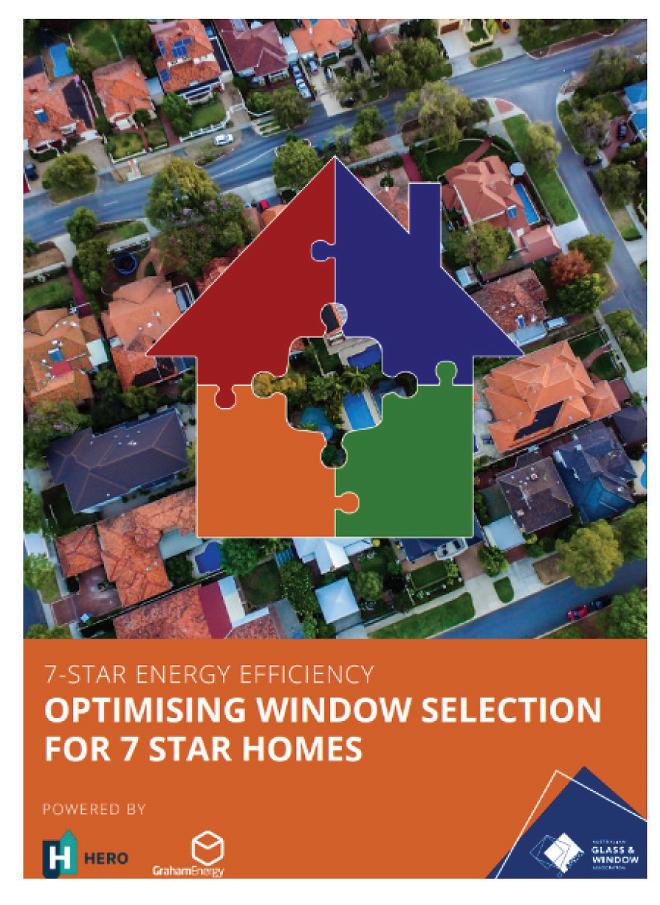
DECO’s new Testing Laboratory and the DECO Innovation Centre were officially opened on 12 May 2023 by the Prime Minister of Australia, the Hon Anthony Albanese MP.
The newly NATA-accredited laboratory and award-winning display centre showcase the exceptional investment the family-owned Australian manufacturer of premium aluminium building products and metal finishing and coatings has made to enhance their commitment to quality and innovation.
Founder and Director of DECO Australia Ross Doonan said he was honoured to have the Prime Minister of Australia officially open the two facilities today.


‘It is an honour to have the Hon Anthony Albanese MP here today to officially open the DECO Innovation Centre and our new NATA-Accredited Testing Laboratory. These facilities are both extremely important investments for our business and ensures we can meet requirements from both our customers and accreditation authorities.’
DECO’s new Testing Laboratory received NATA accreditation last year. The laboratory
plays a critical role in DECO’s quality control, which involves a wide range of essential tests and control processes. These internal functions ensure compliance with accreditations such as ISO 9001, ISO 17025 and Qualicoat, as well as customer specific Process Control Plans, operational specifications, and inspection requirements.
‘DECO prides itself on providing the highest possible quality products and metal finishes in the market. The new testing laboratory is not only essential for meeting accreditation criteria, it also supports our ongoing innovation, research and development as well as our day-to-day quality controls for our customers across the architectural, engineering, defence and aerospace industries’, said Ross Doonan.
Completed in 2020 during the pandemic, the DECO Innovation Centre was designed in conjunction with ClarkeHopkinsClarke Architects and has now become a must-visit destination for people looking for building inspiration in real-life applications, to explore DECO’s product range up-close and to select their perfect finishes and colours.
‘The DECO Innovation Centre has been well received by our partners and customers; it’s been fantastic to see how it inspires people
to bring their own design visions to life. We’ve had people travel interstate just to visit the centre. Our investment into this facility has been completely worthwhile’, said Ross Doonan.
Also announced on the same day was DECO Australia’s commitment to sustainability with the newly agreed supply of lowercarbon aluminium through Capral’s LocAl® Green aluminium initiative.

‘Alongside quality and innovation, sustainability is at the forefront of our business and our industry. Thanks to our new agreement with Capral, we are excited to be able to reduce our and our customer’s environmental impact through the purchasing of lower-carbon aluminium’ said Ross Doonan.
For more information on the DECO Innovation Centre and the new DECO Testing Laboratory visit www.deco.net.au.
The Australian Glass & Window Association (AGWA) has long been committed to ensuring the highest standards in the glass, glazing, and window industry. With a strong emphasis on compliance and integrity, AGWA invests heavily in independent audits of its members to instil confidence in the market when choosing a product and a professional for their next project.
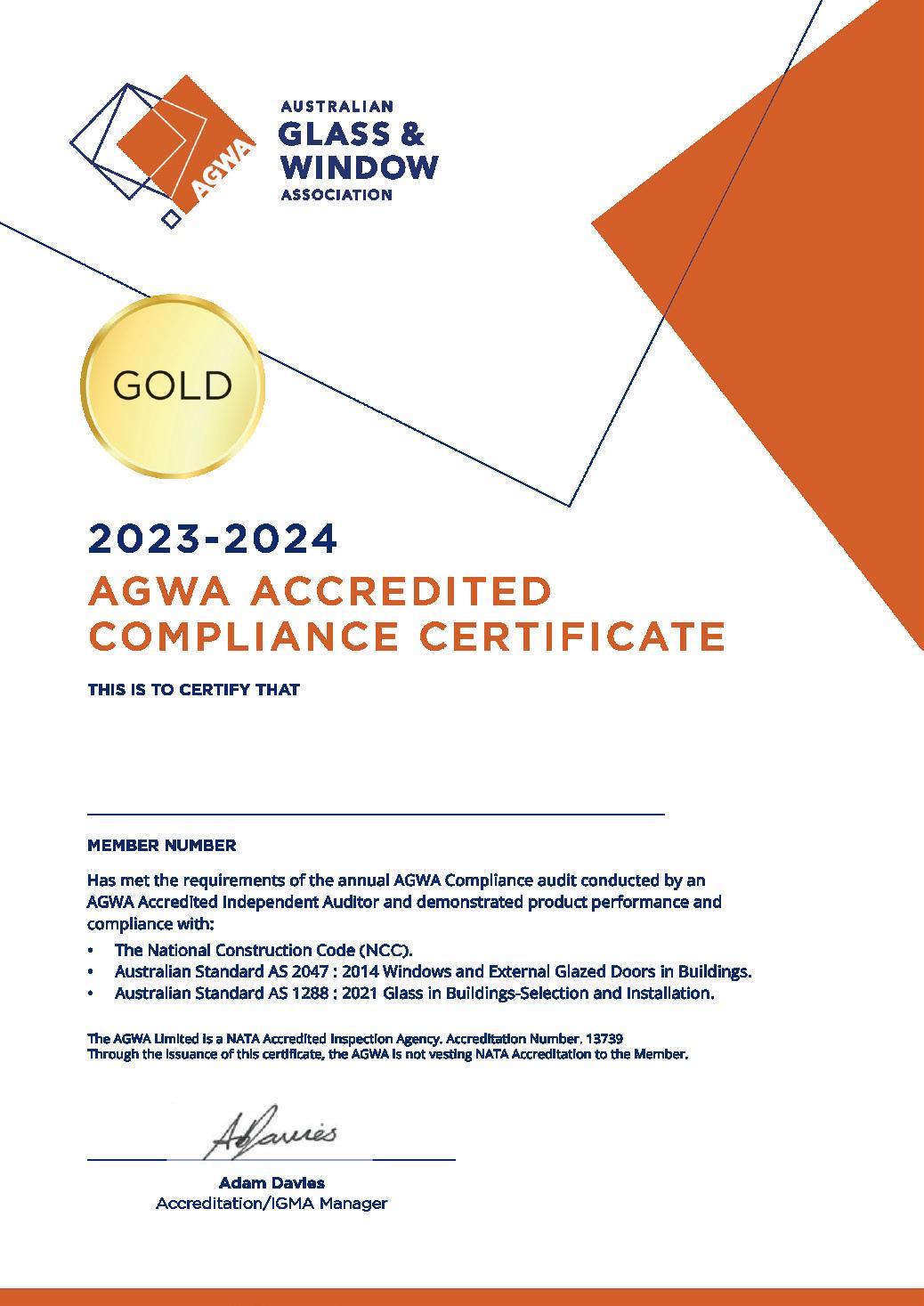
Recent events have highlighted non-compliance and fraud within our industry. In a shocking discovery, an investigation revealed that a window company had altered an accredited member’s documentation and had been using falsified AGWA certificates, deceptively claiming to be a member of the AWA (now AGWA). These actions undermine the trust and credibility that AGWA strives to uphold.
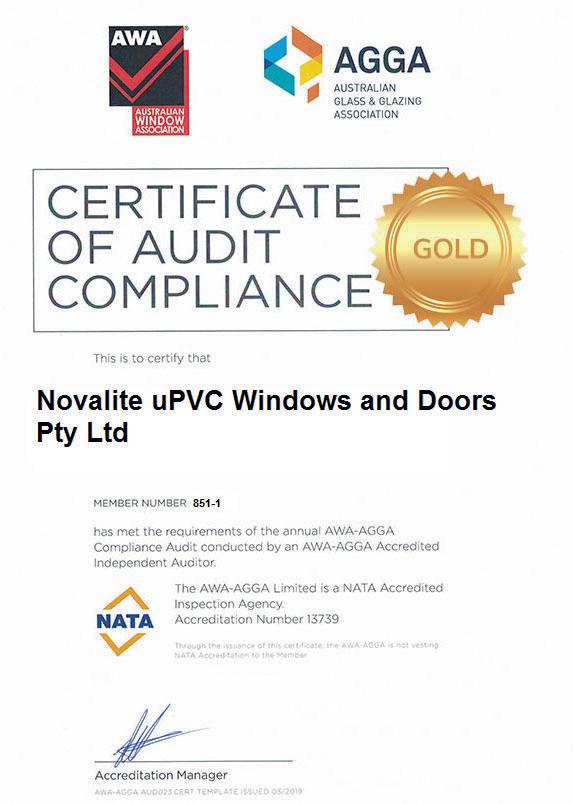
The investigation was prompted by two separate consumer complaints raising concerns about the window installation, workmanship quality, and the validity of the company's claims regarding AGWA membership and accreditation. AGWA took these complaints seriously and conducted a site inspection. The investigation and assessment unveiled a disheartening reality — the installed window solution was deemed ‘not fit for purpose’ and incapable of meeting Australian Standards. Some of the products at one of the sites were so poorly manufactured and installed that they had already ‘fallen off’ their hinges.
Equipped with this damning evidence, the AGWA Board took immediate action to address the false claims and support the consumers. To safeguard the AGWA brand and trademarks, we consulted with legal experts, who undertook an extensive legal review determine the most appropriate course of action.
In light of the findings, the AGWA Board made it a priority to report the company to the Australian Competition and Consumer Commission (ACCC) and the relevant building authorities regarding their false and misleading claims of membership and evident non-compliance. AGWA remains steadfast in its commitment to protecting consumers as well as our industry and members’ reputations.
AGWA's dedication to upholding the highest standards and its policy on non-compliance and fraud set a clear example for the industry. By investing in independent audits and taking decisive action against violators, AGWA ensures that consumers can have confidence in selecting an AGWA member for their glass, glazing, and window projects.
The recent investigation serves as a powerful reminder that AGWA remains vigilant in maintaining the integrity of the industry, safeguarding consumer interests and fostering a market built on trust and accountability. If you are aware of a company falsely reporting membership of AGWA or its previous foundation companies (AGGA, AWA etc) please us know.



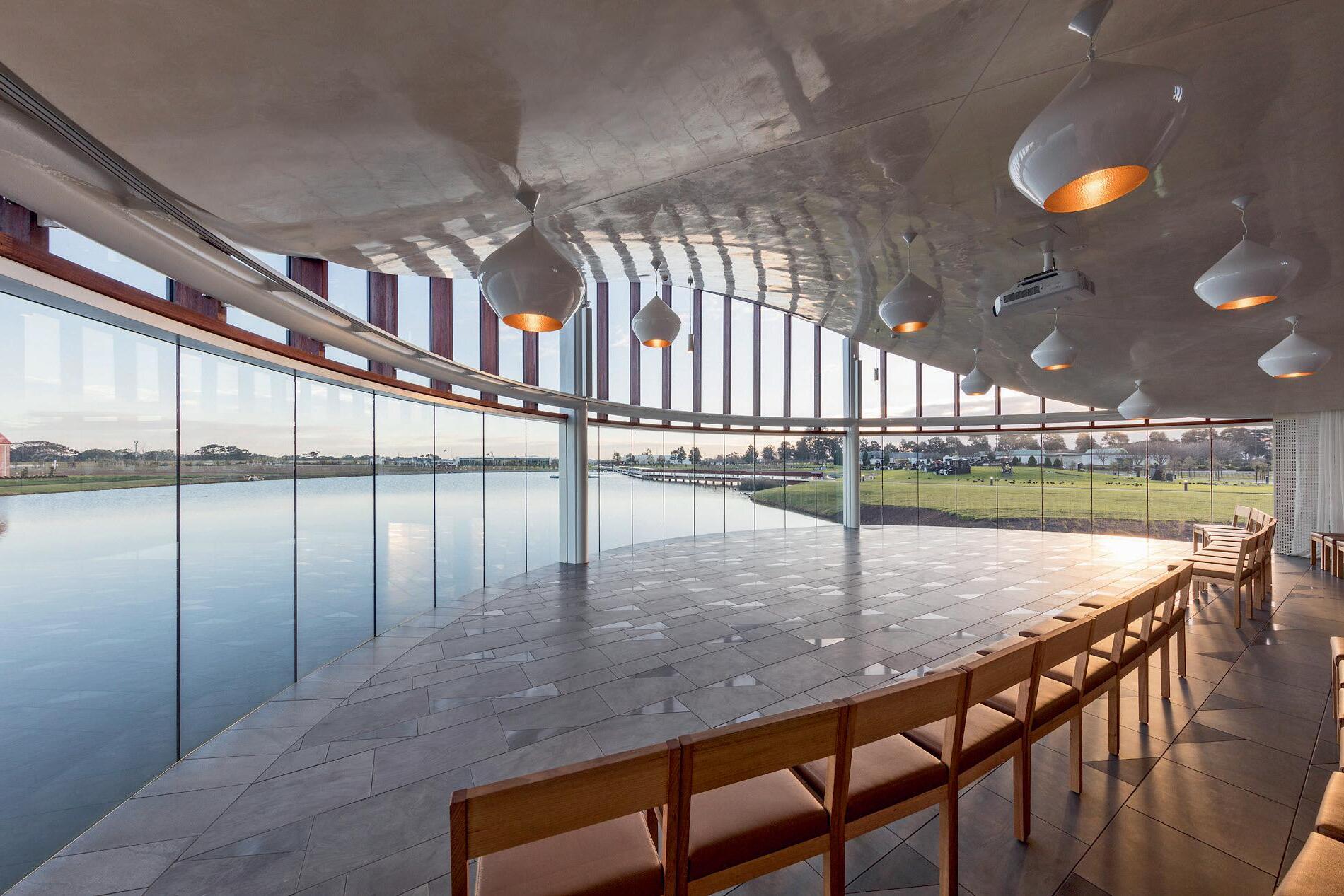




since the pandemic, so I thought it’s now or never. I found an apprenticeship quickly through a friend and I haven’t looked back since.’
Mr Kontogiannis’ retraining comes at an opportune time, as Sydney needs an additional 725,000 homes by 2036 to house its growing population according to NSW Department of Planning and Environment and key to every home is natural lighting.
a number and it's never too late to keep learning and find something that you are very passionate about’, said Mr Kontogiannis.
‘I am so glad I made the leap and have never been happier. My advice for anyone wanting to learn a new skill or career is to just do it — you are in good hands with TAFE NSW.’
The Tumbi Umbi local enrolled in Certificate III Glass and Glazing at TAFE NSW after switching careers from construction sales. Fuelled by his passion for the industry, he recognised the burgeoning demand for products and services vital to the construction sector.

‘I’ve worked in construction sales since I left school, but for the past 10 years, I’ve considered making the switch from the office to a worksite. My age dissuaded me, but I was set on trying something different or learning new skills’, Mr Kontogiannis said. ‘Through my work, I knew that glass and glazing products had been in high demand
‘I was excited to cover frameless windows. They’re new to the industry and becoming quite trendy. It’s great to see the learning environment is keeping up with the industry’, said Mr Kontogiannis.
Across the nation, according to Jobs and Skills Australia, the construction industry and building trades are projected to see a 6% increase in employment, even after a substantial 12% rise in 2022. This upward trend calls for the recruitment of new workers, making TAFE NSW graduates highly sought-after.
For Mr Kontogiannis, retraining at TAFE NSW helped him fortify a new career path and refreshed his outlook on his own ability.
‘If I knew how fulfilling it would be, I would have done this 10 years ago. Age is just
TAFE NSW Glass and Glazing Head Teacher Mark Nicholls said Ilias’ story shows the transformative power of education. ‘It’s inspiring to see mature-aged students, like Ilias, return to study later in life, equipping themselves with new skills and pursuing fulfilling careers’, said Mr Nicholls.
‘Mature-aged students bring a unique perspective and a depth of life experience to their studies, which often ignites a newfound passion for their chosen trade and inspires their peers. This is definitely true of Ilias.’
To find more information or to enrol in the Certificate III in Glass and Glazing, visit www.tafensw.edu.au or call 131 601.

Among a cohort of youthful apprentices, 55-year-old apprentice glazier, Ilias Kontogiannis, is defying age barriers and proving that experience is an invaluable asset.
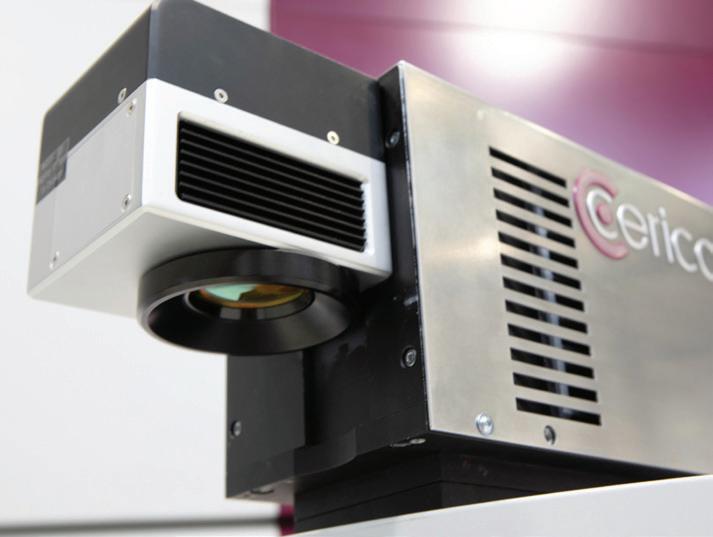
Do you need to frost, structure or drill glass?
If so, cericom Laser has the solution!
When it comes to processing glass, cericom's specialised laser processing machines are the perfect partner. They offer the ideal solution for all your glass processing needs, ensuring not just optimal performance, but also a valuable investment for your business.
Whether you want to frost the surface of glass, structure it three-dimensionally on the inside, or drill into complex shapes without touching it, with cericom's glass laser processing solutions, you can realise sophisticated projects in architecture and design and offer your customers something new and revolutionary. The cericom machines are equipped with the latest laser technology and allow you to decorate and drill glass easily and precisely.
For years, cericom Laser has been consistently developing its technology, combining glass and light in unimagined ways, and offering its customers unparalleled performance and reliability. The German-based company offers a range of machine models to choose from to ensure
customers get the equipment that best fits their needs and budget.
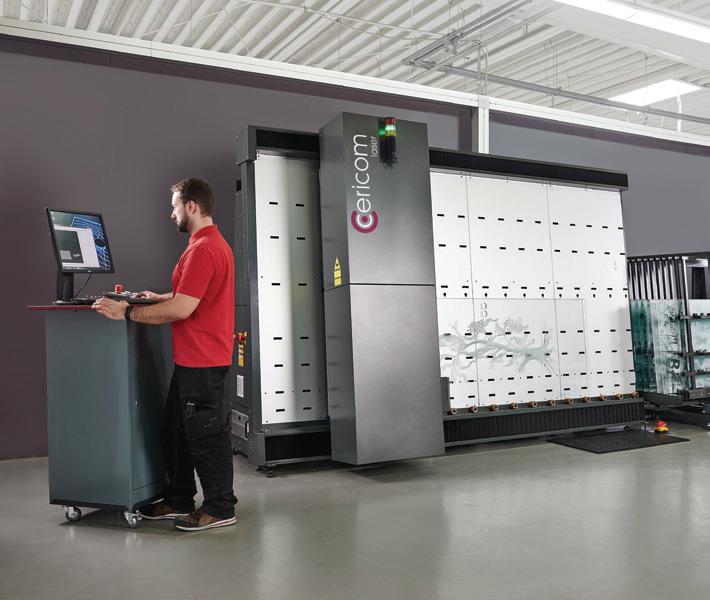
c-vertica, the space saver
Wherever horizontal alignment of the glass is not required, this system provides a powerful laser machine for glass processing.
c-mark | Marking Module
The c-mark module can be used wherever high quality markings are required or copyright is an issue.
c-cut 300/300 | Laser Glass Drilling / Milling Machine
This machine is designed for laser cutting, drilling, and milling of optically transparent brittle materials, primarily for laser processing of glass.
Visit cericom‘s website at cericom. de/en to learn more about their laser technology and machines, and how they can help you achieve your project goals.

The imminent implementation of 7-star housing standards throughout a majority of Australia in the next 12 months, will see a notable surge in the demand for highperformance windows. Depending on the specific climate zone of where construction takes place, most Australian cities will need to adopt high-performance windows to maintain the favourable window-tofloor area ratios they currently enjoy.
IGUs are a crucial component in a chieving high-performance windows. Over the past 5 years, the number of production lines for IGUs in Australia has grown significantly, leading to increased capacity. This trend is expected to continue with the commissioning of more production lines and additional ones being planned within the next 2 years. Industry has undertaken these proactive measures to meet the projected demand for IGUs with the adoption of the NCC 2022 7-star energy requirements.
With this shift in the market to higher-performing windows, window manufacturers and glaziers need to recognise that simply using any IGU
manufacturer for your windows or doors comes with considerable risks, as not all IGUs are created equally. Unlike monolithic glazing, an IGU is a complex system, consisting of several different parts requiring specialist skill and care to be assembled into a hermetically sealed, high quality, and longlasting unit. If care is not taken or the correct materials and steps used, there is the potential for the unit to perform poorly, and ultimately fail, thus requiring premature replacement.
When selecting a window or door for a building, the industry is very well versed in the need to specify and select a product that has been tested to AS 2047, manufactured correctly and is within its size limitations. The same care should be undertaken when selecting an IGU. The way to do this is to ensure that the units are supplied by an AS 4666 Certified manufacturer. To be AS 4666 compliant, a manufacturer must demonstrate that the units have longevity via ongoing long-term testing, as well as completing robust daily

production checks, which are key to producing a complaint and quality IGU. While correct manufacturing is a key component to ensuring that an IGU will last for its intended lifetime, correct installation is equally vital to the performance and lifespan of an IGU. In fact, from AGWA’s assessments, improper installation accounts for approximately 50% of IGU failures.
To ensure long life and quality installation, installers should be familiar with the specific requirements outlined in AS 4666. One of the most critical of these requirements, when it comes to installation, is proper setting block selection, placement and size as well as ensuring adequate protection to prevent the secondary seal from being exposed to excessive moisture.
We already face challenges with consumers not understanding that an IGU has a finite lifetime, as it is a complex manufactured system, and that it will not last for the almost indefinite period of monolithic products. With strong consumer law rights in Australian, AGWA is
seeing an increasing number of window manufactures remediating IGUs that have failed due to poor quality or poor installation. Time and time again, we are seeing fabricators surprised at the whole-of-life cost of failed units on their profitability. Not only do the units need to be remanufactured, but in many cases, this is a fraction of the total cost of remediation with, labour, access, and disposal weighing heavily on business earnings, often many years after installation.
Prioritising IGUs manufactured by certified manufacturers and ensuring adherence to the installation guidelines outlined in AS 4666, will minimise the risk of performance issues and premature failure. It is important that industry remembers that the correct manufacturing, installation and maintenance are key to maximising the lifespan and effectiveness of IGUs to provide energy-efficient and long-lasting solutions, becoming a significant part of energy-efficient housing in Australia.
To continue to support the growth and quality of IGUs, AGWA recommends that fabricators chose AS 4666-compliant Insulating Glass Manufacturers Affiliation (IGMA) members. IGMA is a sub-committee of AGWA and represents manufacturers and suppliers committed to supporting the manufacturing and use of quality and compliant IGUs in the Australian market. IGMA is currently developing several documents and training materials to assist manufacturers and installers in understanding what is required to ensure units are made and installed correctly.
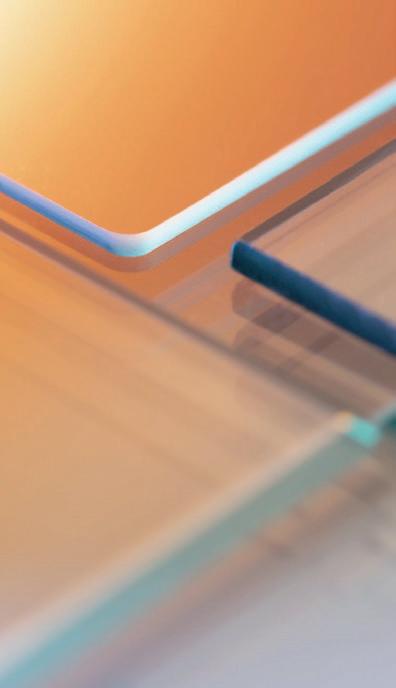
To find out more about IGMA please contact Adam Davies at adam.davies@agwa.com.au

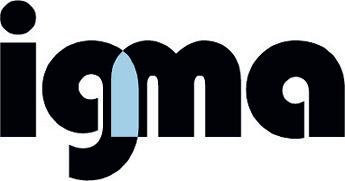

We see a world designed with smarter, safer and more energyefficient glass. We’re innovating the technology for you to make this a reality.
The Power of Saving Energy with New Technology
Energy efficiency is one of the key ways to make the electricity you use in production go further. Each time you save energy, you cut your electricity bill. Glaston continues to push the development of modern glass processing technology to meet production needs with significantly lower electricity consumption.
Advancing energy savings in glass tempering technology
‘Glaston is developing advanced heating and cooling technologies for the best glass quality, outstanding energy efficiency and reliable automation. Our tempering lines with advanced heating control make it possible to increase loading efficiency and decrease energy without sacrificing quality. With recent technology solutions, quenching energy can even be optimised’, says Riku Färm, Director at Heat Treatment Technologies.
Minimise energy losses in glass lamination
The easiest way to save energy when laminating glass is to upgrade from a traditional infrared heater furnace to full convection technology. Energy losses are
minimised, as the same air is recirculated inside the furnace. The right amount of energy stabilises the furnace temperature. Processors often report energy savings of at least 50% after a heating technology upgrade.
Convection cuts energy use in automotive glass processing
Heating technology is also key in bending and tempering automotive glass. With its targeted and efficient heat transfer, convection heating minimises energy loss during the process. Convection provides uniform heating for bending both clear and printed glass surfaces. For windshield and sunroof processing, convection minimises the number of old-fashioned reflection plates, saving more energy per unit produced.
‘In automotive glass pre-processing, energy can even be recovered. Electric motors feed energy back into the grid by decelerating the tools. In addition to that, our lightweight equipment saves up to one-third of the energy required by conventional machines’, says Robert Prange, SVP of Automotive & Display Technologies.
Save

The Glaston Thermo Plastic Spacer (TPS®) system produces IG units with only one machine instead of several components. This reduces cycle times and saves energy by completing daily production faster.
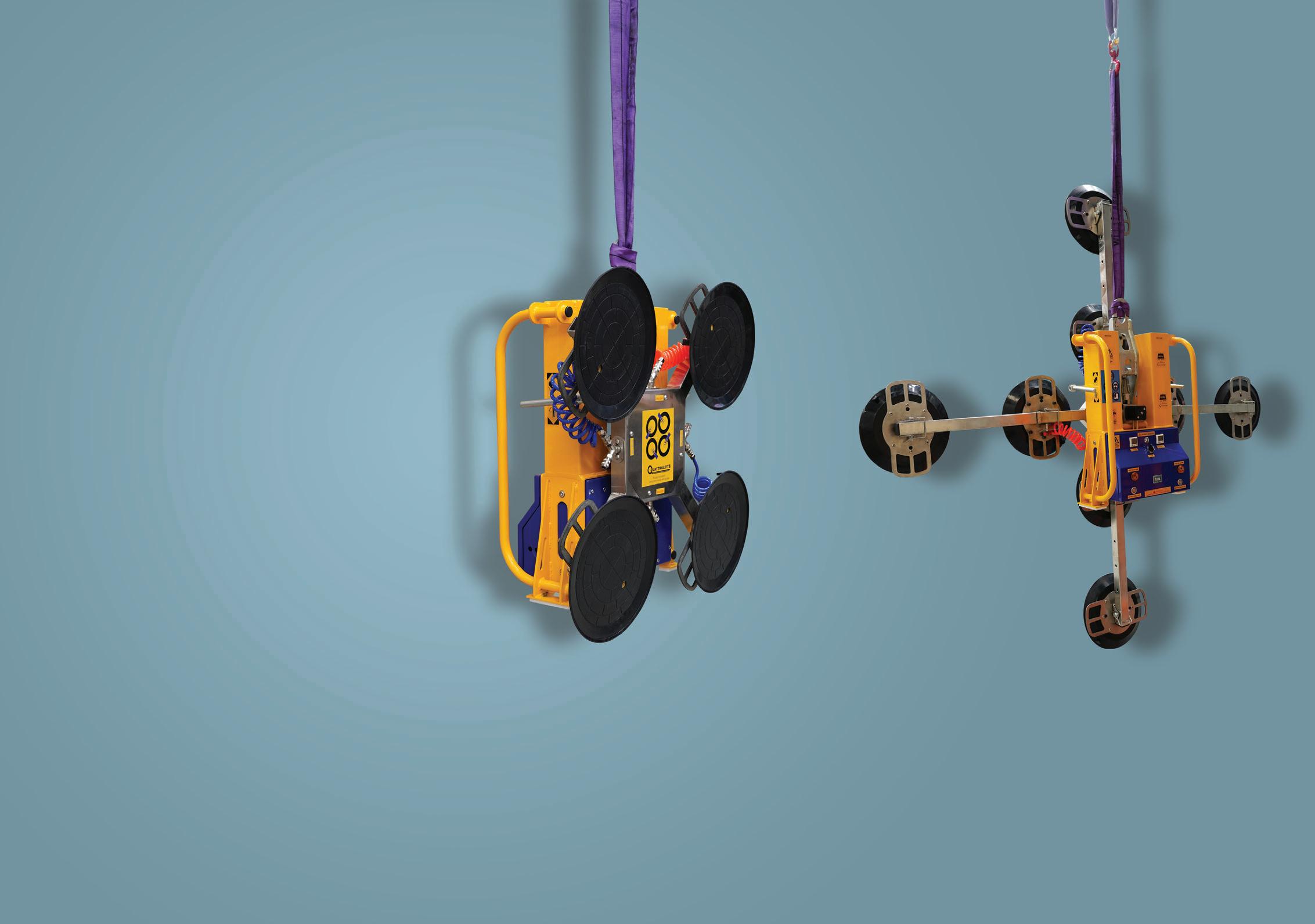
‘Glaston’s latest washing and drying machine automatically switches the drying zone off when the glass plate is dry. This reduces washing machine energy use by 25%, while the closed water circuit further reduces water consumption’, says Uwe Risle, Director at Insulating Glass Technologies.

Boost energy with upgrades
‘Upgrading an existing glass processing line with the latest technology leads to significant energy improvements without investing in an entirely new line. Most of our latest technology is available as an upgrade, making it quick and efficient to increase capacity, reach better output quality and yield, reduce maintenance, and improve uptime’, comments Artturi Mäki, SVP Services.
For more information about energy efficiency in glass processing visit https://www.glastory.net/
The importance of testing balustrade barriers cannot be overstated. Balustrades serve as critical safety features, both inside and outside buildings, primarily designed to prevent people from falling from heights exceeding one metre. These safety standards are outlined in the National Construction Code (NCC), the Australian Standard AS 1170-1 (Structural Design Actions Parts 0, 1 and 2) and AS 1288 (Glass in Buildings) for glass barriers and balustrades. Testing plays a pivotal role as the fundamental engineering qualification that provides proof of compliance with regulatory requirements.
When a balustrade undergoes testing, it provides assurance that it is fit for its intended purpose. Testing ensures that the product meets the necessary Standards and performs as expected. This level of confidence is essential for balustrade


installers as it guarantees that their installations will effectively prevent falls from heights. It is crucial to ensure that balustrades are fit for purpose, especially in scenarios where they protect common areas in building complexes. These areas often require higher levels of protection due to potential increased forces caused by crowding. The Australian Standard AS 1170-1 addresses these considerations by quantifying the performance level forces that balustrades must meet in all locations within a building.
To determine the fitness of a balustrade for its intended purpose, evidence must be provided. This evidence may include test reports or technical data, provided by the balustrade provider, obtained from a NATAaccredited testing facility. Having access to such documentation provides peace of mind to builders, certifiers, and residents,
assuring them that they have a compliant product that effectively safeguards against falls. By relying on tested and verified balustrades, stakeholders can trust that they are providing a safe environment for occupants while complying with relevant Regulations. Bespoke balustrade designs require specific attention when it comes to testing. It is imperative to conduct type testing on a project-by-project basis to demonstrate compliance and support engineering calculations. Azuma Design, a reputable provider, offers NATA-endorsed testing services to the highest standards. Clients often engage them to test bespoke balustrades beyond the minimum requirements stipulated by the NCC. For instance, Azuma Design has conducted specialised tests involving extreme heat on glass balustrades to ensure their ability to withstand local climate conditions. They have also tested balustrades under varying levels of destruction to ensure their effectiveness even in a broken state, particularly in heavily populated areas. In conclusion, testing balustrade barriers is of utmost importance. By prioritising comprehensive testing, builders, certifiers, and residents can have confidence in the safety and compliance of the balustrades in their buildings. Testing ensures that balustrades are fit for purpose, providing robust protection against falls from heights. It is a proactive approach to prioritise safety, compliance, and peace of mind for all building occupants.
1st Choice Fix / Carina, QLD
Adams & Partners Lawyers / Penrith, NSW
AGC Asia Pacific Pte Ltd / Singapore
D-Lucks Glass / Warners Bay, NSW
Euroglass Australia / Hemmant, QLD
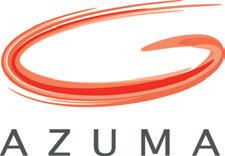
Glasscorp Australia / Bangholme, VIC
Green Star Windows & Doors/ Bankstown, NSW
Innoglaze / Varsity Lakes, QLD
Instock Windows / Kilsyth, VIC
Luoyang LandGlass Technology Co, Ltd / China
Pacific Glass Balustrades / Avoca Beach, NSW
Prime Windows / Craigieburn, VIC
SA Architectural Windows / Para Hills West, SA
Steel Window Design / Heidelberg West, VIC
Sunhohi Windows / Rowville, VIC
Super-View Windows / Hume, ACT
Victory Windows and Doors / Wallan, VIC
Windotek Australia Pty Ltd / Queanbeyan West, NSW
Capral Aluminium has recently received certification against the Aluminium Stewardship Initiative (ASI) Performance Standard V3 and Chain of Custody (CoC) V2 for the extrusion, warehousing and distribution of aluminium products and services. The certifications apply to all of Capral's 26 facilities, composed of extrusion facilities, distribution centres and trade centres, spread across every state and territory in Australia.
These certifications recognise Capral's commitment to responsible production, sourcing, and management of aluminium products.
‘As buyers become increasingly conscious of the environmental impact of their products, Capral's certification is a significant achievement that reinforces our position as a responsible and sustainable business’, comments Marc Banks, Group ESG & Risk Manager for Capral.
‘It has been a hard slog; these Standards set high benchmarks and are assessed rigorously by third-party auditors. We can now proudly hang our hat on the fact that we are the first Australasian aluminium extruder to achieve certification under the ASI Performance and Chain of Custody Standards. Our Integrated Management System (IMS) philosophy has been 13 years in the making and provided a solid foundation for us to build upon and achieve our certification.‘

With this certification, Capral joins a select group of international aluminium producers and suppliers who have met the rigorous standards set by the ASI.
In this article, we'll examine what the certification means for Capral, its customers, and the industry. We will explore the benefits of responsible aluminium production and how Capral's certification aligns with the growing demand for sustainable products.
What is the Aluminium Stewardship Initiative (ASI)?
The Aluminium Stewardship Initiative (ASI) is a global non-profit organisation that sets standards for responsible aluminium production, sourcing, and management.
ASI works with stakeholders across the aluminium value chain, including producers, suppliers, and end-users, to promote sustainable practices and ensure social, environmental, and ethical responsibility.
ASI developed their certification program through an extensive multi-stakeholder consultation process. It is the only comprehensive voluntary sustainability standard initiative for the aluminium value chain. The ASI Performance Standard V3 and ASI CoC Standard V2 were launched in May 2022 following a multi-year revision process.
ASI certification is becoming increasingly crucial for organisations, within the Aluminium value chain, wanting to demonstrate their commitment to sustainability and responsible procurement. As customers become more aware of the environmental impact of their products, they are demanding more sustainable options and increased transparency from suppliers regarding the origin and effects of the materials they consume.
The ASI Performance Standard defines 11 principles and 62 criteria under three sustainability pillars — Environment, Social, and Governance — to address pressing sustainability issues in the aluminium value chain, such as biodiversity, Indigenous peoples' rights, circularity, and greenhouse gas emissions.
The ASI CoC Standard sets out requirements for creating a Chain of Custody for material produced and processed through the value chain into diverse downstream sectors. Implementing ASI's CoC Standard links verified practices at successive supply chain steps — certified under the ASI Performance Standard — to the products produced by ASI Certified Entities.
ASI certification can help companies to identify areas where they can improve their sustainability practices, leading to long-term benefits for both the company and the environment and, at the same time, providing a robust benchmark for responsible aluminium procurement.

Capral Aluminium has a long-standing commitment to sustainability. The company recognises that responsible environmental stewardship is essential for its long-term success and the wellbeing of the communities in which it operates. In early 2022, Capral committed to reaching net zero by 2050. Shortly after that, in June 2022, Capral joined the Aluminium Stewardship Initiative recognising that the organisation would provide robust benchmarks against which it could measure its sustainability and responsible procurement practices.
In November 2022, Capral took an industry-leading position and introduced a lower carbon primary aluminium option into its range — LocAl®, providing Australian window and door fabricators, architects, designers and builders with access to cleaner, greener, lower carbon aluminium for commercial and residential building projects.
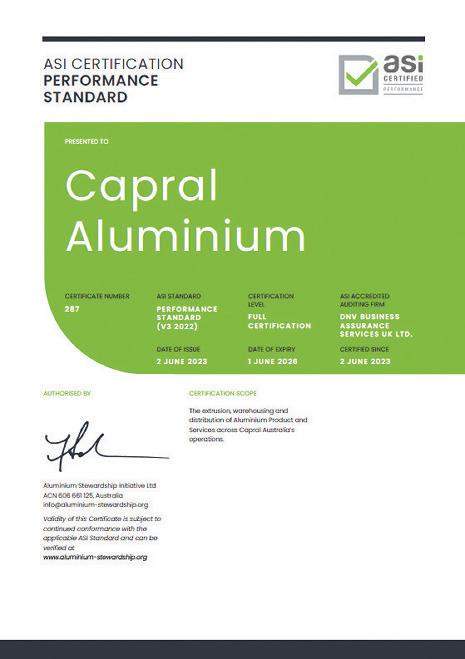

Capral has implemented various sustainability initiatives, including energyefficiency measures, waste reduction
programs and material recycling. Capral also works closely with its suppliers to ensure that they meet the same high standards for sustainability. These initiatives have allowed Capral to reduce its environmental impact and improve its operational efficiency.
To receive ASI certification, Capral had to undergo a rigorous audit process that assessed its sustainability practices against ASI's Performance and Chain of Custody Standards. The audit covered all aspects of Capral's operations, including production processes, sourcing practices, and management systems. DNV Business Assurance Services UK Ltd carried out the independent, third-party audit of the Capral's operations.
ASI-certified aluminium for Australian window and door manufacturers Capral's certification under the ASI Performance Standard applies to its comprehensive range of locally extruded aluminium window and door systems, including AGS, Urban, Urban Plus, Futureline, Artisan and Schüco systems.
‘In November last year, we committed to offering all our window and door systems from lower carbon aluminium sourced from ASI-certified smelters; now we can go one step further and add that our organisation has achieved certification under the ASI Performance and Chain of Custody Standards. For fabricators specialising in Commercial and Architectural projects, access to ASI-certified, lower carbon aluminium systems will provide an immense advantage in winning projects and tenders where environmental credentials matter’, commented Brendon Orth, Capral's National Specification Manager.
ASI's Performance Standard V3, under which Capral is now certified, has recently been recognised by the Green Building Council of Australia's Green Star under its Responsible Products Framework. The Responsible Products Framework is a credit that falls under the 'Green Star — Buildings' category and aims to assess how responsible a product is to drive the supply chain to deliver transparent, healthy, low-impact, and net zero-carbon products that are part of a circular economy.
As an ASI-certified member, Capral can now contribute to Green Star credit points (under the 'Green Star Building' category: Responsible Structure, Responsible Envelope, Responsible Finishes, and Responsible Systems) for the structure of a project.
‘The ability to claim Green Star credit points through the use of Capral's ASI-certified aluminium is a huge advantage for window and door manufacturers competing on commercial projects where Green Star certification is a priority — Capral aluminium systems are currently the only locally produced window and door systems which carry this certification’ adds Brendon.
The Green Building Council of Australia is not the only local organisation that has publicly recognised ASI and its Standards as best in class for sustainable aluminium production. MECLA, (the Materials Embodied Carbon Leaders Alliance) collaboration of organisations from all parts of the building and construction industry supply chain, is actively working with architects, designers and specifiers to advocate for the specification of ASI-certified CoC aluminium in construction projects.
The future of sustainable aluminium production for windows and doors Capral's ASI certification is a sign of the growing demand among architects, builders and developers for sustainable products and services as consumers become increasingly aware of the environmental impact of their products. As the demand for sustainable aluminium building products grows, ASI certification will likely become crucial for aluminium window and door product suppliers. Capral's certification is just the beginning a new era of responsible and sustainable aluminium production.
For more information, please contact Kellie Moore, Capral Corporate Marketing Communications Manager, at kellie.moore@capral.com.au
For more information Visit The ASI WebsiteConsult the Capral Aluminium member page at www.aluminiumstewardship.org/about-asi/members/ CAPRAL-ALUMINIUM
Elegant IG started out in a small warehouse, located in the Sydney suburb of Dee Why in New South Wales. At the outset Elegant IG consisted only of Sandro, his wife Lily and a part-time warehouse assistant. Between them, they focussed on supplying only the best IG consumables from around the world and provided an unrivalled level of service to the company’s handful of customers. It didn’t take long for word of this to spread and Elegant IG’s customer base grew at a rapid pace.
In its third year of operating, Elegant IG moved to a 210 sqm warehouse a short distance away in Cromer. At this time, the company also expanded its staff with the addition of a product manager and full-time warehouse manager.

Over the next few years, Sandro worked diligently to strengthen his knowledge of
all aspects of the insulating glass industry to solidify existing customer relationships and form many new ones. He served as the IGMA Chairman for 3 years, having been on their Management Committee and an AGWA Director for approximately 17 years. In 2017 he was awarded the Glass Person of the Year for NSW.
Sandro’s tireless work cemented Elegant IG’s reputation as an industry leader, and, in 2007, the company again relocated to accommodate its growing size. The new site in Belrose, approximately 30 minutes from Sydney’s CBD, was selected with future growth in mind. At this time Sandro and Lily were joined by one of their sons, Simon. In 2013 their youngest son, Joshua, also joined the family business. Elegant IG continues to operate from the 1300 sqm facility in Belrose, which is spread over three warehouses.
Elegant IG’s history dates back to August 1996, when the owner and director, Sandro Ianni, founded the company with the vision of providing Australian manufacturers of insulating glass units with a complete line of quality components.
Now in 2023, Elegant IG is proud to announce it is expanding again to better service its customers in this growing industry. Elegant IG will be opening a brand new 1300 sqm warehouse in Truganina, Victoria. This new facility will focus on servicing customers in the southern states and WA, while its Sydney warehouse and head office will continue to service NSW and Queensland.
Our Sydney office will also house our new Sparklike calibration service centre, due to open fourth quarter of 2023 where it will service all devices for Australia, New Zealand and Southeast Asia.
Over the years the Elegant team has grown from three to nine staff members with three more joining shortly in Victoria. Its range of products has expanded to also include machinery and accessories for auto
or manual production of double-glazed glass, as well as a range of products developed to make handling and working with glass easier and safer. Some of these products include, Tecglass digital ceramic printers, Sparklike Argon gas testing equipment, Bassra glass processing equipment, Schiatti Angelo edge processing machinery, Glasweld Scratch removal kits, RPM chemicals, Tiller lift and Diamant edge processing tools.
Sandro believes honesty, loyalty and integrity, together with highly professional and flexible customer support, are the cornerstones of Elegant IG’s success.


A vacuum lifter is one of the most frequently used positioning and lifting aids for the glazier. Usually these are bulky, manually driven lifting aids. With the Tiller® electric liftmobile for handling glass, windows and doors you have the most compact and manoeuvrable machine, you can easily lift, move and install glass on your own. This compactness is extremely suitable for glass assembly for indoor or small spaces.
This machine allows you to easily lift, move and install glass up to 120kg.

If you would like further information on Tiller products please visit our website www.elegantig.com.au or contact one of the Elegant team on 02 94736500



Reducing energy consumption is undoubtedly a must today. This priority has automatically involved the frame industry as well, resulting in an improved performance requirement for windows with increasingly lower thermal transmittance values, Uw [W/m2 K], The new generation of spacers used in the ‘warm edge’ insulating glass units has played an important role in the achievement of these objectives.
‘Warm edge’ spacers are defined as all spacers built with materials whose thermal conductivity is significantly lower than that of the conventional aluminium spacer bar and which contribute to improving the performance of the window by reducing the thermal bridge at the edge. Various kinds of materials are involved depending on the type of spacer: flexible foams, thermoplastics, plastic/metal hybrids and stainless steel. When choosing the spacer, however, many factors must be considered, including the manufacturing process, environmental, regulatory and energy factors.
Currently, warm edge spacers can be divided into two groups:
Flexible Spacers
Pliable, flexible thermoplastic and/or silicone-based materials with incorporated molecular sieves. Among these, the butyl hot melt types without any additives such as TPS and the silicone types, cold-applied, which in their most advanced version are butylated laterally with the back in contact with the outer sealant such as Super Spacer Triseal.
Plastic/Metal Hybrid Spacers
Plastic materials such as Polycarbonates and Polypropylene combined with low metal shims that have the same working procedures as the conventional aluminium spacer requiring cutting or bending, butylating, drilling for the introduction of desiccants and gas, Chromatech Ultra and Thermix TX Pro.
Benefits of using warm edge spacer
The widely established and recognised benefits of warm edge spacers are the following:
• Energy savings.
• Environmental benefits with lower CO2 emissions.
• Reduction of surface condensation on the insulating glass.
• Reduced risks of mould formation on the frames, thereby extending their service life.
• Contact surfaces of the window are less cold and thus more comfortable.
Aluminium, on the contrary, is an excellent heat conductor. It creates a thermal bridge which lowers the temperature in the perimeter zone of the glass unit, favouring condensation and so increasing the risk of mould developing on the frame, deterioration of the frame, degradation of the sealants and consequent shortened service life of the insulating glass unit. These possible effects are minimised with the use of warm edge spacers.
Condensation, mould and surface temperature effects
The condensation on the surface of the window begins when the glass temperature falls below the dew point. Condensation

cannot be eliminated altogether, but the use of warm edge spacers can significantly reduce the condensation effect, which also benefits the frame by extending its service life. Warm edge spacers have a remarkably positive effect on the surface temperature of the internal glass measured near the edge.
Difficulty of Use
The transition from classic aluminium spacers to warm edge spacers includes:
• For spacers belonging to Group 1, an investment in special machinery.
• For those belonging to Group 2, an adaptation of the machinery and replacement of the blades with a different setup for the procedures for cutting, bending and drilling the groove where necessary.
For manufacturing the high flexibility and particular shape of the materials belonging to Group 2 makes large frames harder to handle and require careful verification of the quantity and continuity of the edge seam.

'Warm edge' spacers are defined as all spacers built with materials whose thermal conductivity is significantly lower than that of the conventional aluminium spacer bar and which contribute to improving the performance of the window by reducing the thermal bridge at the edge.
Types of warm edge spacer available

For more information, please see www.elegantig.com.au
Congratulations to the following AGWA members who have recently passed their accreditation audit:
A&L Windows - QLD

ADS Glass & Aluminium Pty Ltd
(formerly Aluminium Door Services Pty Ltd)
Architectural Windows & Doors
Argus Vision (Australia) Pty Ltd

Arkcon Group
Astellite
Austwel Building Materials
Boka Windows Pty Ltd
Breezway Australia - QLD
Bretts Architectural Window & Door Solutions
Construction Glazing Pty Ltd (Chevron Glass Group)
Cooper & Caller (t/as Winplex)
C-View Windows
DL Best Building Materials Pty Ltd
Dowell Windows - Virginia QLD
EBSA Pty Ltd
Elvapark Pty Ltd (t/as R & R Glass
& Aluminium)
Festival Glass & Glazing Pty Ltd
G & G Glass & Aluminium (G&G)
G.James Glass & Aluminium - Gold Coast
Green Life Window & Door Systems
Integra Windows & Doors Pty Ltd
KP Windows Pty Ltd
Langs Building Supplies
Liverpool Glass Company
Marzdeez Glass & Maintenance
Mitchell Glass
Nationwide Windows Pty Ltd
Northern Trade Solutions (NT) Pty Ltd
Nu-Look Glass & Aluminium Windows
Plumb Glazing Pty Ltd

Plustec P/L
Prestige Plus Pty Ltd
Prompt Glass
PTG Commercial Glazing
Rockingham Glass & Security Screens

Southern Cross Glass Windows & Doors
Stegbar Pty. Limited - Lansvale
Superior Glass (Brisbane) Pty Ltd
Trend Windows & Doors - Ormeau QLD
WA Custom Glass
Winsulation Double Glazing
Yantai Aosheng Windows and Doors Co Ltd
Yokor Window AUS Pty Ltd

Standard M o tif s are a requ i rement o f AS128 8 . We h ave a ful l r a nge of motifs t h at are avail a ble to m embers .
Satisfy & Comply with AS1288 & AS1428.1
Extensive Range
50 Metre Rolls




Unpri n t e d C o nt i nu o us M o t i f s colours to ensure y o u a chi eve a m ini m um 30% luminan c e c ontrast t o satisfy AS1428 .1 .


Pe rforma n ce Lab e l s are des i gned t o c on f orm wi th AS204 7 .
Assorted sizes available in Clear or Silver .
Guarantee Repeat Business
Easy to Apply
Customised Branding
DECO Australia (DECO), leading manufacturer of aluminium buildings products, has partnered with Capral Aluminium (Capral) to supply LocAl® Green lower-carbon aluminium. DECO is leading the way by being the first to commit to switching all their Capral aluminium extrusions to LocAl® Green.

Announced with the Prime Minister in attendance, the agreement to switch 100% of DECO’s aluminium supply from Capral to lower-carbon aluminium is an important step in DECO’s commitment to reducing carbon emissions.
‘Capral Aluminium is Australia’s largest aluminium extruder, and we are pleased to announce today that DECO Australia and Capral have reached agreement for Capral to supply DECO with lower-carbon aluminium to assist in producing more environmentally friendly building products’, said Ross Doonan, Founder and Director of DECO Australia.



DECO’s commitment to LocAl® Green aluminium is part of the company’s Sustainable Framework, which has a core environmental commitment to reducing
emissions across the business, including their product offerings.
‘We are continuously looking to improve our responsible material sourcing and this agreement with Capral Aluminium will assist in reducing the emissions intensity of one of our major material inputs’, said Richard Hamber, General Manager DECO Australia. Richard continued, ‘the switch to LocAl® Green aluminium will also directly support our customers across the architectural and building industries by supplying aluminium building products made from responsibly sourced, lowercarbon aluminium, helping them to achieve their own sustainable initiatives and outcomes’.
The LocAl® Green aluminium has the same technical properties as primary aluminium, however, it is produced using lower emission energy sources and reduces the embedded carbon of the aluminium by 50% (when compared to the global average for primary aluminium).
‘We have worked together to ensure we can support DECO on their sustainability journey’, said Luke Hawkins, Capral’s
General Manager of Industrial and Procurement. ‘This is what it’s all about, making it possible for Australian manufacturers to make responsible and sustainable procurement decisions around Aluminium.’
DECO Australia has long been dedicated to investing in innovative and sustainable outcomes for the Australian building industry. The partnership between DECO and Capral, and their commitment to lowercarbon aluminium, is set to pave the way for a cleaner and greener building industry.

DECO will start receiving the supply of LocAl® Green lower-carbon aluminium from June 2023.

For more information on DECO Australia visit www.deco.net.au.
For more information on LocAl® Green visit www.lowcarbonaluminium.com.au

MAY 2023-JUNE 2023
AS 1288 Human Impact and Wind Loadings, 3 May 2023
Faizan Ahmed, Bright Balustrading
Tim Arkey, Aspect Windows Pty Ltd
Andrew Brodie, Aspect Windows Pty Ltd
Matthew Brodie, Windows Pty Ltd
Ross Farrelly, PCW Commercial Windows
Trent Gillies, TasTAFE
Michael Henderson, Aspect Windows Pty Ltd
Aaron Kenny, PCW Commercial Windows
Mitchell Livingstone, Ultimate Windows
Chris Loukas, Aspect Windows Pty Ltd
Justin Read, TasTAFE
Peter San Martin, Aspect Windows Pty Ltd
Dillon Selby, PCW Commercial Windows
Clinton Sullivan, Aspect Windows Pty Ltd
Intermediate Fenestration, 9-23 May 2023
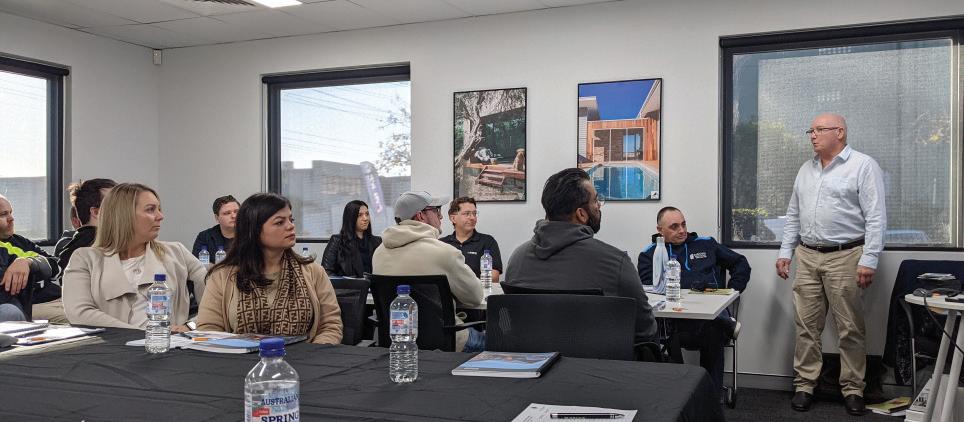
Andrew Hawley, Nationwide Windows
Paul Nash, Windoor Joinery
Michael Picone, Alspec
CJ Rowley, Alspec
Gareth Styles, Windowline
AS 1288 Overhead, Barriers and Structural, 24 May 2023
Steve Brooks, Greater Glass
Clark Dang, Viridian
Trent Gillies, TasTAFE
Jared Hodierne, Advanced Frameless Glass
Robert Plowes, Greater Glass
Justin Read, TasTAFE
Window Essential, 7 June 2023
Mark Lee, Darley Aluminium
Rubina Afroz, Capral Aluminium
Julie-Anne Crosby, Trend Windows &Doors
Aaron Davies, AGWA
Chelzee Dela Cruz, Trend Windows &Doors
Emma Dong, Trend Windows &Doors
Shirley Heron, ALG Group Services Ltd
Ryan Lee, Touch Station Pty Ltd
Declan Long, Doric Products
Angela Pignataro, Doric Products
Alannah Smith, Trend Windows &Doors
Lily Thomas, Capral Aluminium
Siddharth Kumaran, AGWA
AWS Intermediate Fenestration, Brisbane 6 and 7 June 2023
Adam Harvey, Langs Building Supplies
William Boyd, Langs Building Supplies
Sharon Koplick, Langs Building Supplies
Gayle Bambrick, Bretts Architectural Window and Door Solutions
Shoneen Tuhimata, Bretts Architectural
Window and Door Solutions
Matthew Thompson, Bretts Architectural
Window and Door Solutions
Suzy Window, True Blue Glass
Tony Dinh, Crystal Clear
Mick Rosolen, Windowmakers
Ben Gill, Windowmakers
Chris Rose, CHGA
Kyle McIntyre, CHGA
Jack little, CHGA
Lochie Turner, CHGA
Catherine Whitfield, Architectural
Windows & Doors
Scott Brown, Horizon Windows and Doors
Scott Munro, Pattersons
Gary Dionysius, Pattersons
Lee Patterson, Pattersons
Jason Szabo, Pattersons
AWS Intermediate Fenestration, Sydney 20 and 21 June 2023
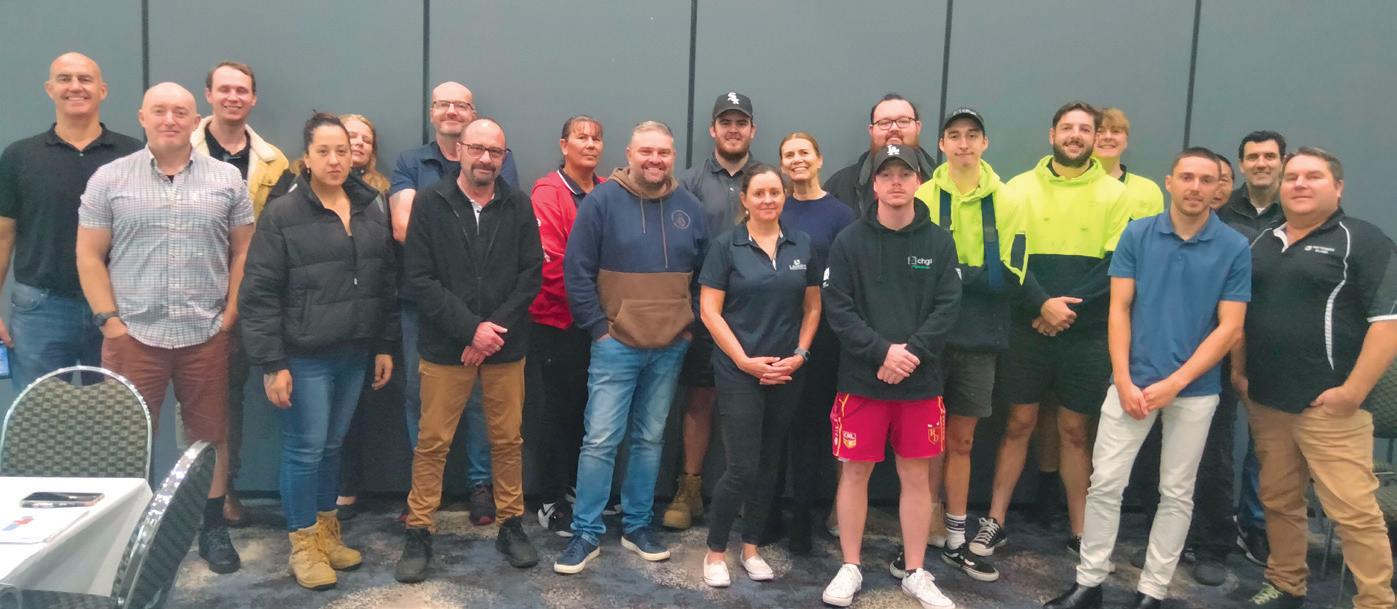
Susan Abela, AWS
Jake Mercieca, AWS
Lauchlan Hutton, AWS
Rafaella Kavouras, AWS
Ethan Gersbach, Custom Windows
Stephen Cuthbert, Everclear
Paula Baghdisar, Evolution Windows
Mark Wilson, Evolution Windows
Lisa Ornelas, Evolution Windows
Carol Hammond, Hanlon Windows
Bilal Mir, Western Windows and Doors
Chris Chhoeu, Winlux
Abhas Rajbhandari, Excell
Srijal Khadka, Excell
Chau Nguyen, Excell
Mathew Bryant, Bryants
Chris Howarth, Bryants
Mitchell Robertson, Bryants
Tyson Smith, Bryants
The new AGWA 4055 Tool is now live and ready for you to use. Unlike previously, the AS 4055 Tool is located on the AGWA website. Go to the Members Portal and then to Technical Resources. Within that you will see a tab called Industry Tools. The new Tool is located there. You will need your AGWA username and password to access the Tool.
The Tool is, however, not the same as the old Tool. The way you determine the data has changed due to the changes in AS 4055: 2021. Because of this we have also rereleased the AS 4055 Tool training. We strongly recommend that you run through the revised training, so you understand the differences between the old Tool and the new Tool. Please note that you will not be able to fully utilise the new AS 4055 Tool unless you have done the training.
For more information, please contact training@agwa.com.au.
AGWA is excited to announce the graduates from the Second Fenestration training in Australia.


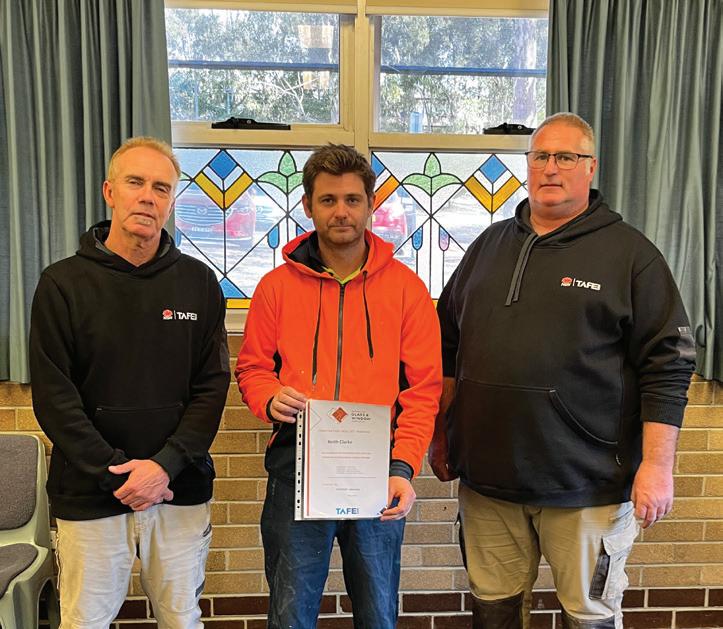
Ten employees from G.James, Bradnams, Greenefire, Coastal Windows and Doors and Windoor Joinery travelled far and wide to spend one day a week for 5 weeks at Lidcombe TAFE (NSW) in May 2023. They have now completed their course and received a Statement of Attainment at a graduation celebration at Lidcombe TAFE on 30 May 2023.




We are so proud of these incredible representatives of the glass and window industry! They now join our first group of 11 graduates.
This is a significant milestone for the window industry in Australia.
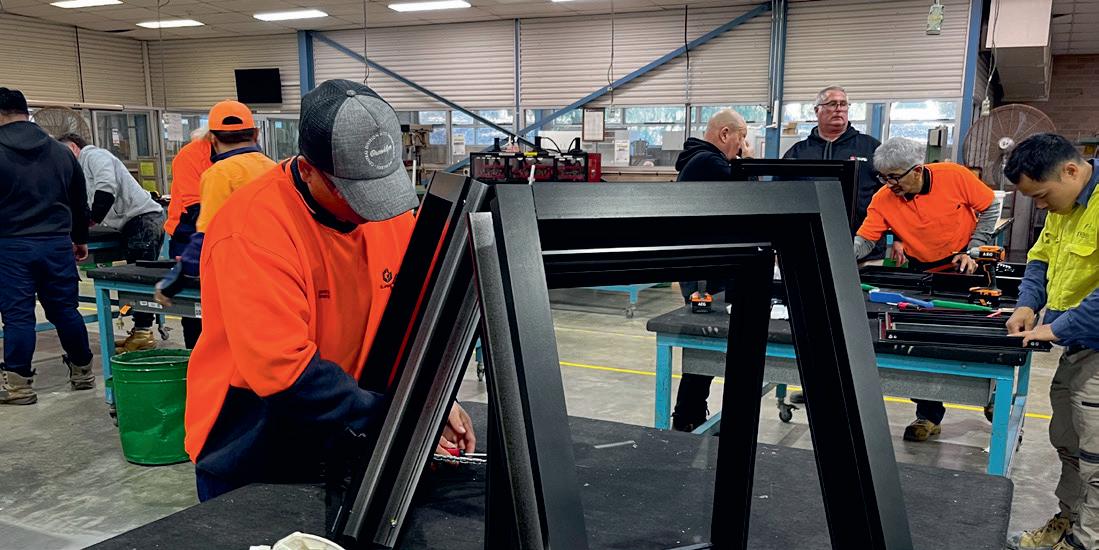

Students completed 4 units from the new Certificate III Fenestration (MSMWHS200 Work Safely, MSMSUP106 Work in a team, MSFGG3039 Manually Move Glass, and MSFGG2016 Assemble Glazing Products). The Statement of Attainment transcript, showing their results in these 4 units, can then be used to go towards completing of the full qualification.
Thanks to the amazing teachers at Lidcombe TAFE and Training Services NSW for all their hard work in getting this training running.
We are running more courses in 2023 so contact training@agwa.com.au if you are interested in sending your employees along.

Background

With its harsh and variable weather patterns, Australia has the highest solar radiation per square metre of land of any continent in the world. This means that products formulated for the Northern Hemisphere often lack the durability to survive our extreme climate, leading to embrittlement, discolouring, and fading over time.

Responsible suppliers recognise the need for all products used in Australian buildings to be formulated and designed for the country’s harsh climate. Until recently, the market had no means of identifying uPVC profiles that had been manufactured to resist the ferocity of the Australian climate. Recognising this gap, the uPVC Window Alliance developed the uPVC Window Profiles
Industry Code of Practice (ICP) Accreditation Scheme. Now window and door profiles, manufactured for Australian conditions, can be tested and certified for their durability, strength, and colour longevity.


What does ICP accreditation involve?

The ICP has set specific composition, weathering resistance, colour and impact strength requirements for extruded uPVC window and door profiles in Australian buildings. These go beyond the typical testing standards in other regions including Europe, North America and Asia.
To gain ICP accreditation, uPVC profiles are independently tested and must meet stringent strength and colour retention criteria after 2 years of exposure. Specifiers, builders, architects and their clients can be confident that ICP-certified uPVC profiles are

durable under Australian climatic conditions, and that they will maintain their strength and colour for many years of service.
The Australian Glass & Window Association recognises and supports the uPVC Windows Alliance’s ICP by including it in its Accreditation Program for its uPVC members. This means that AGWA’s uPVC members meet the stringent testing requirements that are relevant to Australian conditions.





























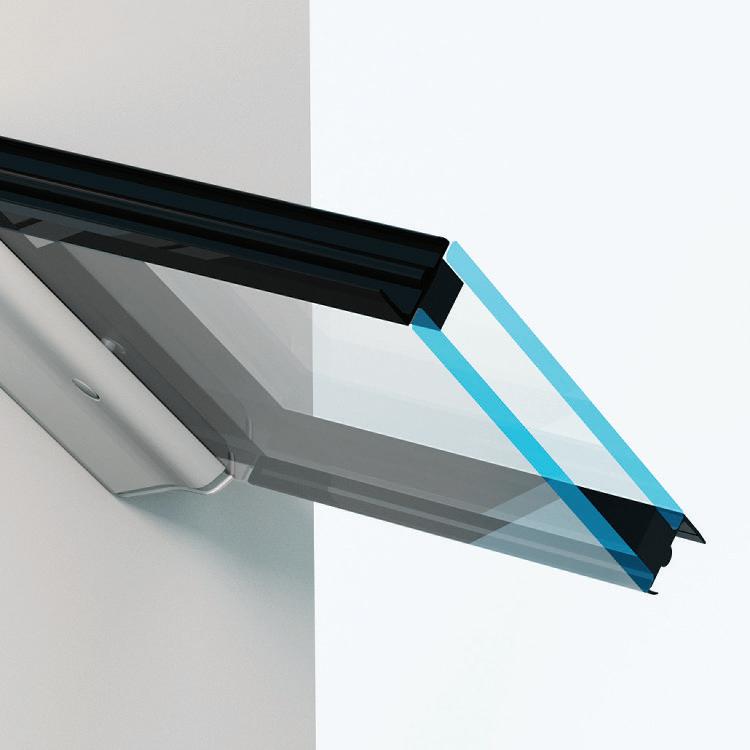












AGWA’s Queensland Members enjoyed a fantastic day on the greens at Nudgee Golf Club on Friday 12 May 2023.

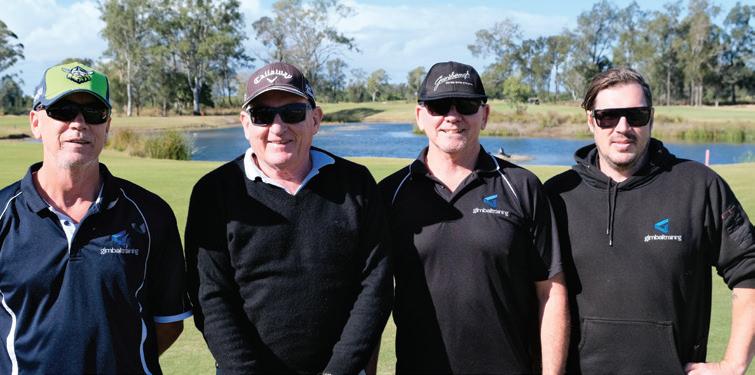






122 golfers were blessed with amazing weather and a great time was had by all. Congratulations to all our players, especially to the team from Fitout Glass & Aluminium for their well-deserved win on the day. The day also raised over $1000 for the incredible work of the Surf Life Saving Foundation thanks to a fundraiser organised by Next Gen Glass and Aluminium.
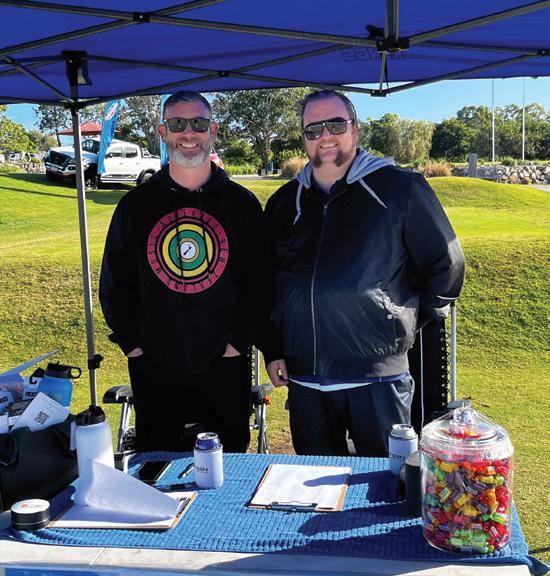


Thanks to our major event sponsors Westpoint Autos and Oceania Glass. Thanks also to Hole Sponsors, without their support these great member social events would not be possible; A & L Windows, AWS, Breezway, Capral, Dulux, Powder Coatings, G.James, Gimbal Training, Interpon Powder Coatings - AzkoNobel, Knotwood, Lincoln Sentry, Next Gen Glass & Aluminium, NFK, Rio Tinto, Signet, Suburban Glass & Leadlights, The Green Guys
We are look forward to seeing you all again next year so put 17 May 2024 in your diary now.

SMARTLY
Celebrating 5 YEARS of Full Success!
Vesuvius is a world leading producer of fused silica glass tempering rolls used in the production of flat and curved safety glass

As the pioneer of mechanical endcaps, Vesuvius launched the SMARTLY DRIVEN™ PLUS roll in 2018 , bringing reliability and consistent performance to the process of thousands of satisfied customers around the world

With the SMARTLY DRIVEN™ PLUS roll, Vesuvius has invented the glue -less generation of rolls’ endcaps. Thus, the customers enjoy rolls that are :
STRONGER – Elimination of ceramic shoulder gives a major strength advantage and resilience.
STRAIGHTER – Reduced and consistent TIR directly improves glass flatness and reduces wave distortion.
LIGHTER – Easier to handle during maintenance operation, up to 4% (on average 1.5-3 kg) weight saving on comparable rolls
RELIABLE AND REVERSIBLE – Ready to use product for horizontal glass tempering furnaces with a fully mechanical endcap attachment system . Ready for temperature exposure up to 250°C (and peak temperature exposure of 350°C for 2 hours max)
Hinged Security Door Lock
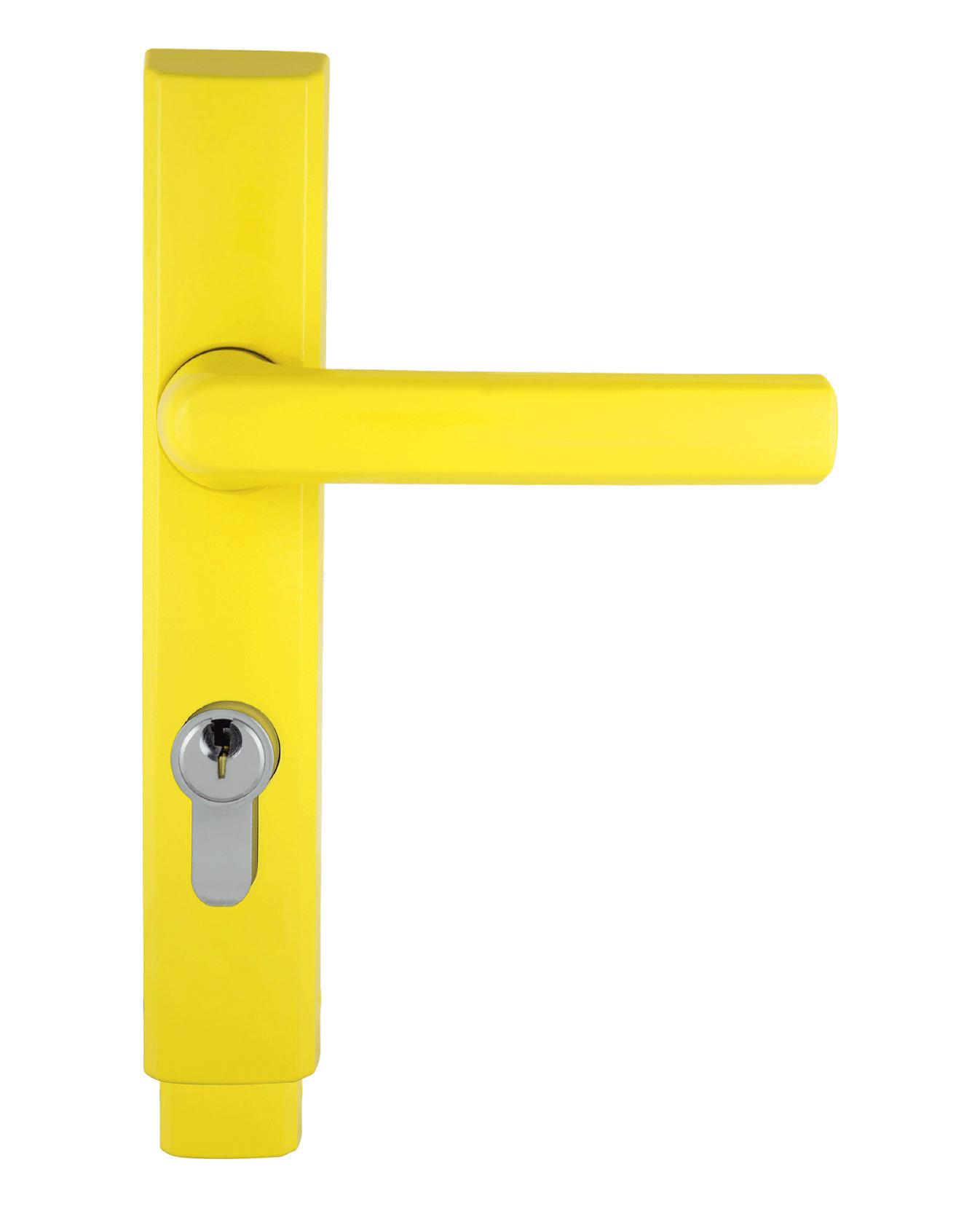 DAVID HEAL Product manager david.heal@vesuvius.com
DAVID HEAL Product manager david.heal@vesuvius.com
+61 299 145 500
GUAN THEAN LIM Regional Sales manager guan-thean.lim@vesuvius.com+86 512 6274 4075

Vesuvius Foseco Australia
7 Stuart Street, Padstow, New South Wales 2211, Australia
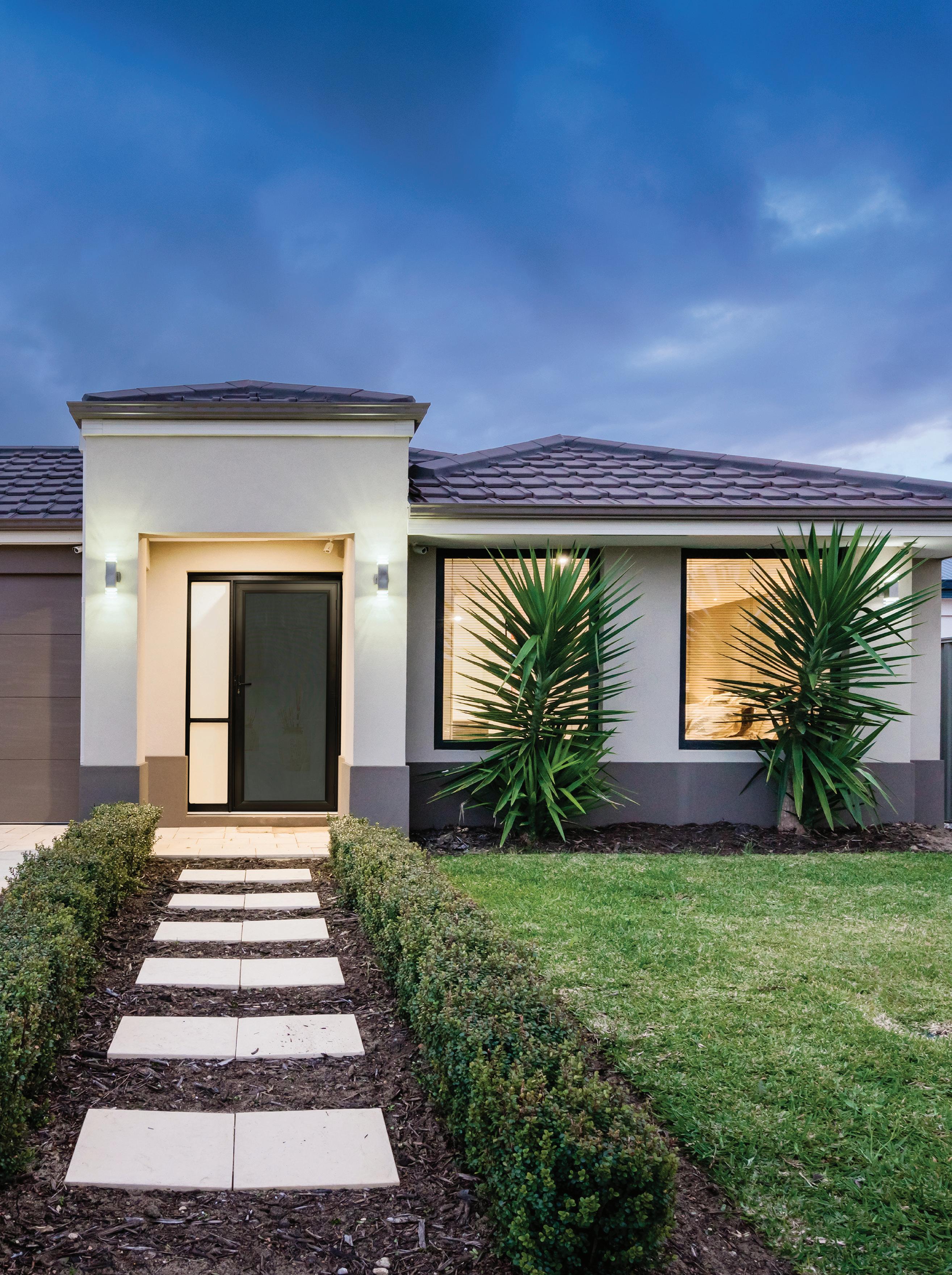
Phone: +86 512 6274 8927

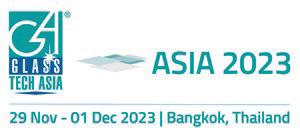
Contact us: www.zyarock.com
Australian designed and manufactured
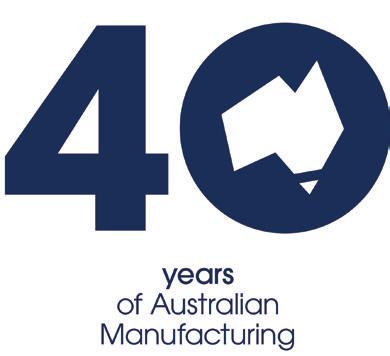
New premium aesthetic with stainless steel face plate
Over 200 colours to choose from Dulux and Interpon
7
The ScreenGuardTM Stainless Steel Mesh System for windows and doors is designed to offer maximum security, visibility and style.
ScreenGuard TM security screens and doors are made with high tensile 316 marine grade stainless steel mesh that provides strength and quality. While ScreenGuard’s unique aluminium frames are tempered to T6, using state-of-the-art equipment.
ScreenGuardTM rated forFireAttenuationfor 3hours&10minutes!
10 YEAR WARRANTY

Australian designed & engineered
Easy to fabricate & install
Now available with Nylon Corner Stakes
Meets and exceeds AS 5039-2008
High tensile 316 marine grade stainless steel mesh
Bushfire rated BAL 40
Corrosion Resistant
Rated for Fire Attenuation in accordance with Appendix B7 of AS1530.4:2014
To request a catalogue or find out more go to www.screenguard.com.au
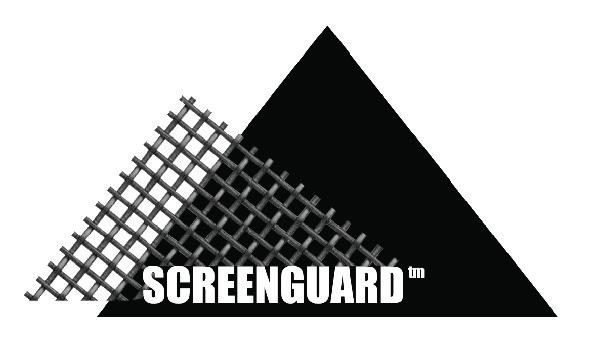
SYDNEY HEAD OFFICE . T: (02) 8887 2888 . E: sales@darleyaluminium.com.au
MELBOURNE . T: (03) 9238 3888 . E: salesvic@darleyaluminium.com.au
BRISBANE . T: (07) 3287 1888 . E: salesqld@darleyaluminium.com.au
PERTH T: (08) 9437 2999 E: saleswa@darleyaluminium.com.au








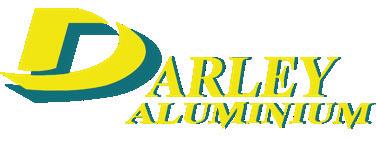



The new StormGuard® screen offer was released to Amplimesh® dealers throughout July and August as part of the national Amplimesh® dealer roadshow receiving great feedback for its performance, style and ease of manufacture.
Amplimesh® National Market Manager Salim KoKo comments, ‘we were excited to introduce a product we know our dealers have been looking for. It provides Amplimesh dealers with a solution for cyclonic regions. It addresses concerns around galvanic corrosion, which can impact the aesthetics and performance of security products’.

At the centre of every StormGuard® screen is an ultra-high tensile stainless steel mesh that offers exceptional strength and corrosion resistance without compromising natural light and ventilation. However, something that sets this product apart from other systems on the market is the StormGuard® patented* isolated screw clamp mesh retention system.
StormGuard® isolated screw clamp mesh retention system.

The StormGuard® patented* isolated screw clamp (ISC) mesh retention system combines extreme wedge pressure, highfriction materials, and custom-engineered screw clamps to efficiently absorb and disperse impact energy equally along the frame, ensuring every single mesh strand is secured. Typical screw clamp systems screw through the mesh directly into an aluminium frame increasing the chance of galvanic corrosion (electrolysis).
The StormGuard® ISC system uses stainless steel screws that bite into an engineered plastic retainer, completely isolating the screws from the frame for improved longevity and corrosion resistance.
Salim adds, ‘the StormGuard® isolated screw clamp is a simple but essential innovation for the market; it is easy to manufacture, provides a strong and secure mesh retention solution and solves a big problem many of us are aware of around galvanic corrosion. It is common to see stainless steel mesh screens with tea staining or corrosion along the frame where the mesh has been fixed with screws. By isolating the screw, this problem goes away, we have an incredibly secure fixing method, and we solve the unsightly staining problem on the mesh. We are confident consumers will prefer this option which ensures the longevity of their screens’.
Testing and Performance
Amplimesh® StormGuard® is engineered and tested to meet and exceed all relevant security and cyclonic testing requirements.
Dynamic Impact Test — AS 5039/5041: 2008 — Security Screen Doors and Security Window Grilles
The dynamic impact test was created to imitate an intruder attempting to kick, shoulder or otherwise force their way through the screen. The accepted and standardised test to replicate this is five 100-joule impacts (energy).
Jemmy Test — AS 5039/5041: 2008 — Security Screen Doors and Security Window Grilles
Amplimesh® StormGuard® is tested to withstand jemmy attacks from levers, such as large screwdrivers used to apply large amounts of torque to locks and hinges. The rigid nature of the heavy-duty StormGuard® fame extruded in T6 tempered structural alloy ensures a pass on this test.
Corrosion Test — AS 2331.3.1 — Methods of Test for Metallic and Related Coatings
To help prevent corrosion, Amplimesh® StormGuard® uses an isolated screw clamp
(ISC) retention system that is completely isolated from all other metal types. This eliminates the chance of galvanic corrosion, a known flaw with standard screw clamp systems.
Knife Shear Test — AS 5039: 2008 — Security Screen Doors and Security
Window Grilles
The premium high tensile stainless-steel mesh used by Amplimesh® StormGuard® passes the test. The test simulates a utility knife attack on the mesh or similar bladed tools used by a burglar seeking entry into a home.
Cyclonic Debris Impact Test — AS 2047 and AS 1170.2 — Debris Impact Testing Requirements
The cyclonic impact test is the toughest for any screening product, and Amplimesh® StormGuard® achieves the maximum rating of 44 m/s. This equates to 3870 Joules, exceeding the 100-joule security impact by nearly 40 times!
‘This is a high-performance product which we know security fabricators are going to love’, adds Salim. ‘It performs exceptionally well against all the relevant tests, exceeds the performance outcomes of Australian standards and delivers a great-looking screen fabricators can feel proud of.’
For more information, please contact Salim Koko, Amplimesh National Market Manager at salim.koko@capral.com.au
The Capral Amplimesh Security products range has been expanded with the introduction of the Amplimesh® StormGuard® screen system, specifically designed to provide high-level cyclonic impact performance without compromising security and aesthetics.

Doric improves on its market-leading range of mortice locks with the new DS2800 'Lift to Lock' Mortice Lock Body. Engineered to integrate with premium architectural aluminium, the DS2800 builds upon the success of its predecessor the DS1297. It is an Australian-designed lock body for higher levels of security, simplified installation and fits left-hand and right-hand hinged and bi-fold doors.
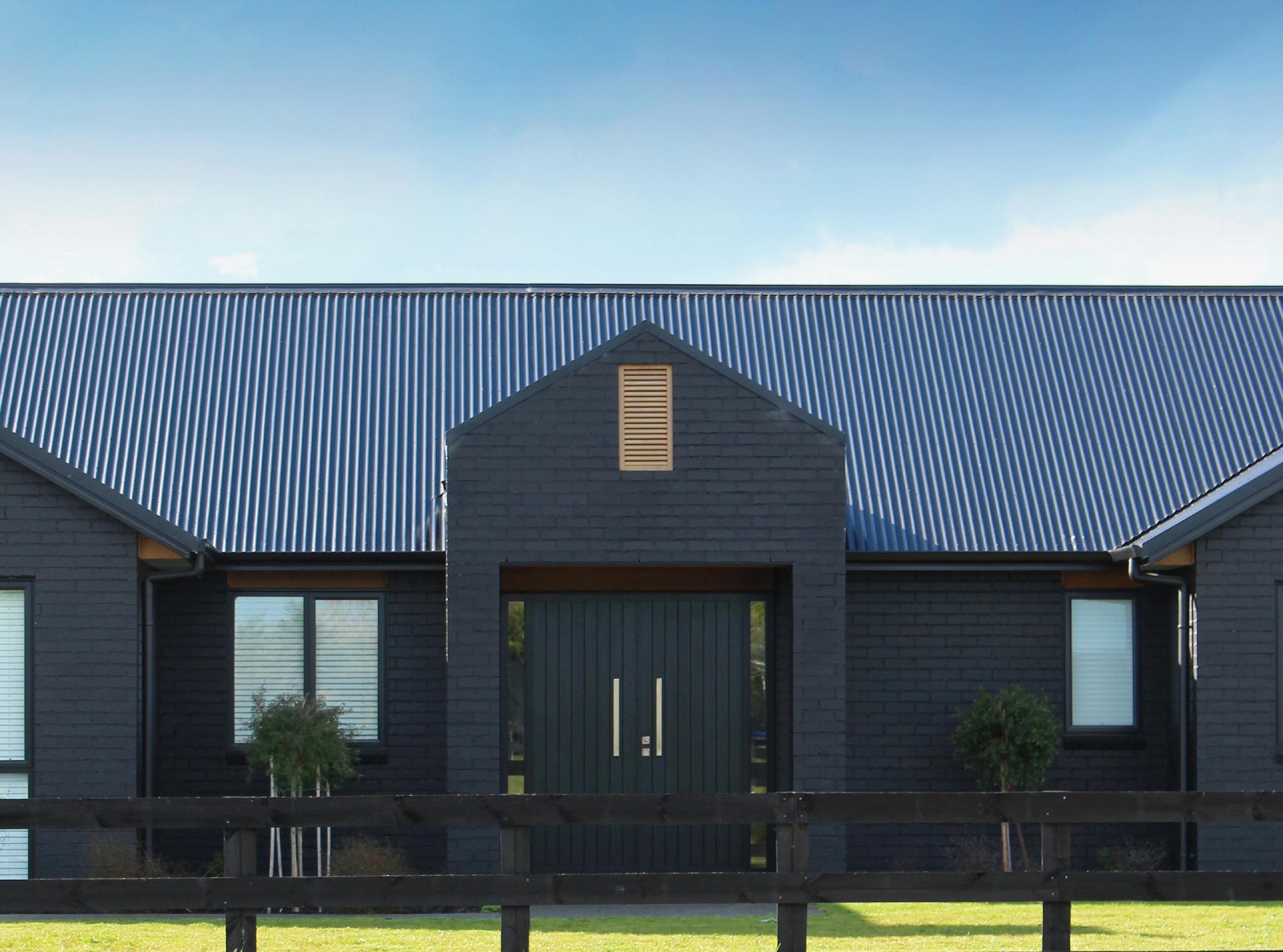
The DS2800 includes a cartridge-style installation. This design makes on-site installation, maintenance and serviceability much easier. DS2800’s components have been revised for hollow aluminium profiles that can be prone to sound resonation with the inclusion of a new accessory kit.
DS2800 is a four-point locking system with Doric’s signature ‘Lift to Lock’ function that uses only the handle to apply four latching points, that other key driven systems cannot reliably achieve without the risk of breaking the key.
This leaves the key lock self-latching latch bolt as independent functions and separate to do what they were designed, key deadlocking and latch closed.
Using handle driven projection bolts the DS2800 can be optioned to include additional top and bottom security bolts. These, when engaged, apply pressure to better square and secure the door against the door seal. This feature becomes necessary on doors over 2400 mm in height because the additional locking

points assist to pull the door tightly shut and increasing the doors wind and water performance. This function cannot be achieved reliably using just the key.

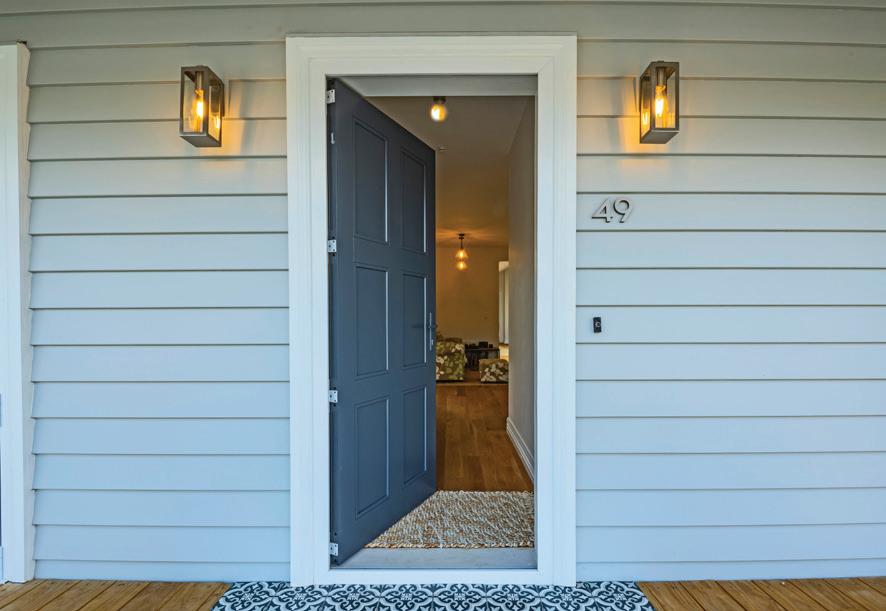
For the manufacturer, a revised Mid Guide eliminates additional tab mounting components and makes mounting the lock body simpler saving on manufacturing time. In application, the security has also been improved using a revised over-camming mechanism within the lock mechanism. This over cam prevents the deadlock from being overridden should the locks security be challenged. Additionally, the lock body is made using pressed sheet steel construction to best secure the door, building, and its occupants.
For day-to-day functionality, applying furniture with a snib to the DS2800 lock body is an option that secures the door from being opened by the handle, from the outside, without a key. This feature is fast becoming a standard.
For durability, the DS2800 surpassed Doric’s demanding functionality test, achieving an impressive 100,000 cycles. Furthermore, it has successfully undergone a maximum torque test exceeding Doric’s required 76 Nm with standard hinged furniture applied in a deadlocked configuration.
The DS2800 'Lift to Lock' Mortice Lock Body by Doric sets a new standard in excellence in the Australian fenestration industry.
ALUMINIUM FRONT DOORS DESIGNED TO FIT INTO YOUR OWN DOOR FRAMES.
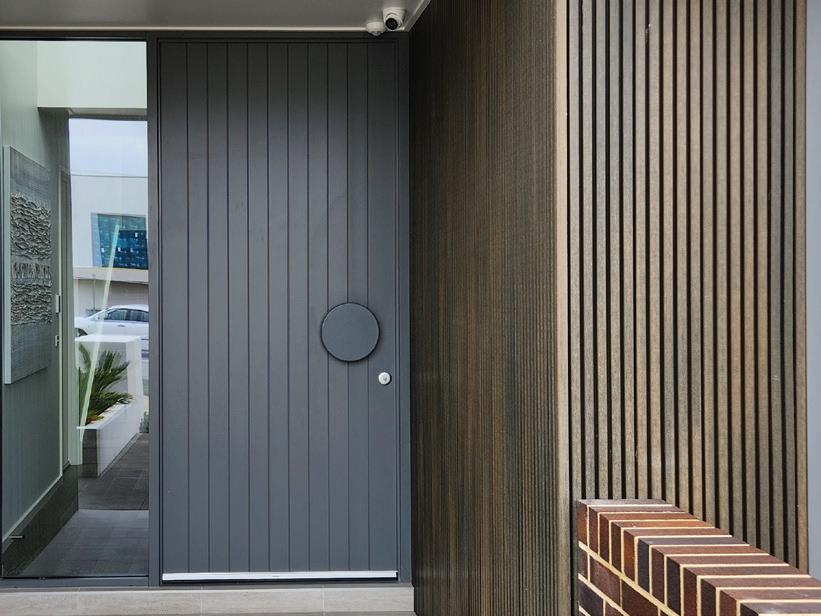


Parkwood’s aluminium front doors are made-to-order, finished in any powder coat colour and supplied to window fabricators nationwide. Add Parkwood’s premium aluminium front doors to your product range to complete your offer.



